
Breanna J. Gonzales
Acoam Carroll Scholarship Winner
Livingston Central High School
June 5, 2025
By Lola Guess
The 2025 Acoam Carroll Scholarship has been awarded to Breanna J. Gonzales of Ledbetter, Kentucky. Breanna will be attending the University of Kentucky, where she plans to pursue a career as a Pediatric Nurse Practitioner.

Livingston County Historical Society President Judy Wasko and scholarship recipient, Breanna J. Gonzales
Throughout high school, Breanna demonstrated exceptional dedication both academically and in extracurricular activities. She was actively involved in the Science Club, Teen Leadership Coalition/4-H, HOSA, Photography Club, and FFA. As Varsity Cheerleader Captain, she exhibited strong leadership skills and school spirit.
Breanna’s commitment to excellence is reflected in her numerous achievements and certifications, including proficient/distinguished performance on testing, Stop the Bleed Certification, CPR, First Aid Basics, CERT, and FEMA Certification.
Her community service record is equally impressive. She volunteered with the National Red Cross Blood Drive, Varsity Cheerleading Clinic, Santa’s Workshop, and HOSA Trash Pickup. Professionally, Breanna gained firsthand experience working as a Patient Care Technician at Livingston County Hospital and was also employed at Willow Pond.
Breanna’s outstanding achievements, leadership, and dedication to her community make her a deserving recipient of this year’s scholarship. We are confident she has a bright future ahead at the University of Kentucky and beyond.
Congratulations Breanna!

Livingston Central High School Graduates – 2025.
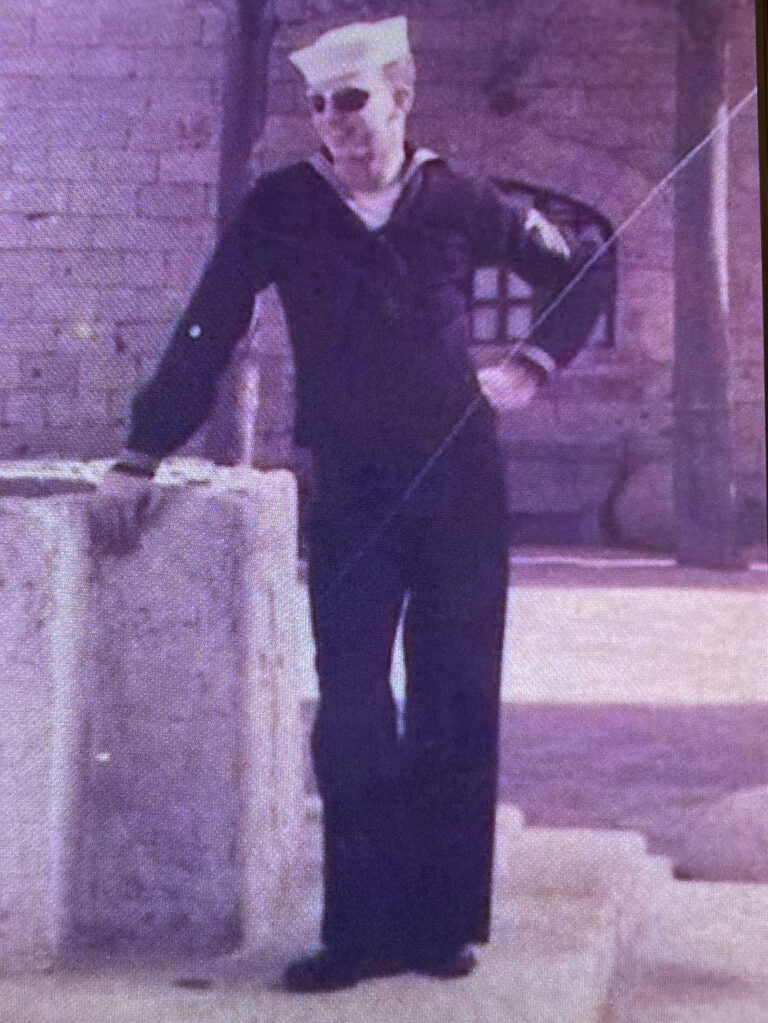
Jimmy Rudd - Surviving the Fire on the USS Forrestal
Don Foster’s interview with Navy Veteran Jimmy Rudd is available on the Livingston County Historical Society’s YouTube Channel. Watch the video, as Mr. Rudd gives a first-hand account of the accident on the Navy ship, the USS Forrestal, in 1967. Mr. Rudd describes how the fire started, the injuries he received, and shares memories of his time in the service.
Jimmy R. Rudd is a lifelong resident of Livingston County. He was born in Smithland and graduated from Livingston Central High School in 1963. In January 1964, Mr. Rudd joined the Navy. He signed up in Paducah and traveled to Louisville, Kentucky, for induction. His basic training was in San Diego, California. He was then sent to a base in Memphis, Tennessee, for A school training. After this training, he was sent to Jacksonville, Florida, where he joined the VA-46 Squadron. His entire air wing was assigned to the USS Shangri-La in 1964. Then, in 1965, the USS Shangri-La went to the Mediterranean for nine months. In 1966, the sailors returned to the Mediterranean on the USS Saratoga. In January 1967, the air wing was assigned to the USS Forrestal.

USS Forrestal
In June of 1967, the USS Forrestal left its home port in Norfolk, Virginia, sailed to Brazil, rounded the Horn of Africa, and finally reached the Gulf of Tonkin off the coast of Vietnam in the South China Sea on July 25, 1967. Four days later, on July 29th, a devastating fire broke out on board the Forrestal after an electrical anomaly caused a rocket on an F-4 Phantom to inadvertently fire, striking the external fuel tank of an A-4 Skyhawk.
Just prior to the moment of impact of the rocket, Jimmy, the final checker, was communicating through hand signals with Lt. Commander Gary Starnes, the pilot of the plane. They were discussing the weight of the plane. Once Starnes was satisfied with the weight, he gave Jimmy a “thumbs up.” Jimmy decided that he needed to check on John McCain’s airplane, which was one plane over on the port side of the carrier. Jimmy took one step and “kaboom.” Eight hundred gallons of flammable jet fuel spilled across the flight deck, ignited, and triggered a chain reaction of explosions that killed 134 sailors and injured 161. The rocket had hit the external tank of Starnes’s plane. Jimmy’s clothes from the knees down were soaked in burning jet fuel. He ran across the flight deck, laid down, and started rolling. Several sailors then smothered the flames. After five and a half hours in sick bay, he was transferred to the flight deck and put on a helicopter, and flown to the USS Oriskany. Eventually, he transferred to the USS Repose, a hospital ship. He transferred again to a hospital in Da Nang, Vietnam, and then to the Philippines for one night. After one more transfer to a hospital in Japan for eight days, he went to a burn unit in San Antonio, Texas, where he received extensive treatment for eleven weeks. After additional duty on the USS Intrepid in the VA-72 Squadron, he was honorably discharged from duty in December of 1968.

Fire and destruction on the USS Forrestal

Notably, Mr. Rudd’s experience on the Forrestal directly influenced a critical safety change in the Navy. Due to the injuries he sustained from the burning cotton pants he was wearing; the Navy transitioned the fabric of flight deck clothing from cotton to rayon. His rayon jacket, in contrast, protected his upper body from severe burns.
Thank you, Mr. Rudd, for your service, your dedication to this country, and your unwavering support for your fellow servicemen. Livingston County is proud to call you one of our own. (Jimmy Rudd – Livingston Central High School Class of 1963.)
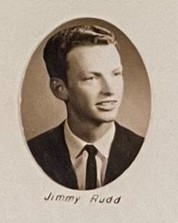
Jewell Paris
May 16, 2025
By Lola Guess
A boating accident at the site of the unfinished Smithland Lock & Dam took the lives of two men on Tuesday, August 25, 1980. The towboat, Linda Lou, struck a concrete pier, capsized, and sank. Four of the six men on the boat were rescued. The two missing men were Jewell Paris from Smithland, Kentucky, and Victor Hoxworth from Bloomfield, Illinois. After striking the pier, the Linda Lou and the barge were separated. The time of the accident was estimated to be shortly after 6:30 a.m. when workers reported seeing the barge come through the dam. Divers searched the area for the boat and the missing men. According to the Coast Guard, the water was swift, and the depth was 40-50 feet.
The Linda Lou, built in 1976, was fifty feet long and eighteen feet wide. The boat was recovered on Wednesday, shortly before dark, a day after the accident. Paris was in the pilot house atop the boat, and Hoxworth was inside. Water was pumped from the boat to search for the bodies.
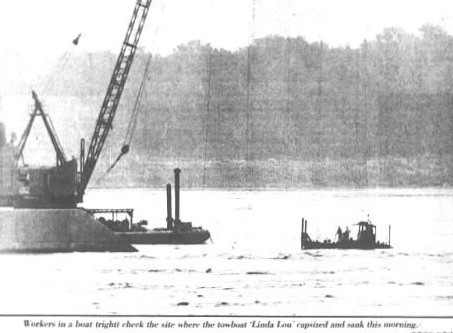
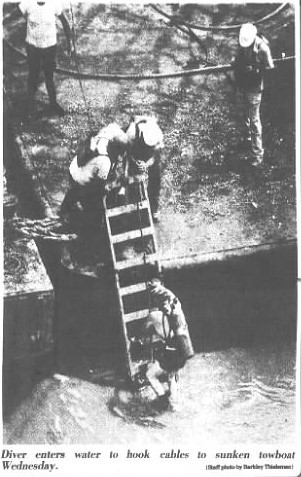
Hoxworth’s body was found two days after the accident by a commercial fisherman approximately two and a half miles downriver from the dam. The search for Paris was extended to all of the Ohio River to Paducah.

Oliver Jewell Paris was born on May 19, 1929, to Ollie and Maude Easley Paris. He married Mamie Irene Joiner in February 1951. Earl and Frankie Champion witnessed the wedding ceremony. Jewell was twenty-one, and Mamie was nineteen. They had five children: Jewell Junior, Detra, Jeff, Diane, and Justin. Tragedy struck the family when Mamie passed away from cancer in October 1974, at the age of forty-one. Burial was in Ferguson Cemetery.
At the age of sixteen, Jewell had briefly dated Christine Buford. They parted ways when Jewell went to work on the boat and Christine went on to finish high school. Many years later, they met again at a farm auction and married in 1975. Christine was at work at the Florsheim Shoe Factory when she was notified of the boat accident. Needless to say, there were endless sleepless nights and countless unsuccessful searches by Jewell’s family and friends.
The family was called upon at other times through the years to identify bodies. A positive identification did not happen until twenty-five years later in 2005, when partial remains of a body were found on the riverbank. A DNA sample was taken from Jewell’s brother, Loyd Paris. The sample was a match. Jewell’s partial remains had been found. A memorial service was held, and the remains were buried in Ferguson Cemetery beside Jewell’s first wife, Mamie.
Jewell’s boss stated that he was the best tow boat captain he had and that Jewell had repeatedly loaded barges. He was described as a devoted husband and father, a treasured community member, and had worked on the river for many years as a tow boat captain. (Lois Ramage contributed to the story.)

Oliver Jewell Paris
Ferguson Creek & Ferguson Cemetery
May 2, 2025
By Lola Guess
The oldest tombstone in Ferguson Cemetery near Smithland, Kentucky, marks the grave of Hamlet Ferguson. Hamlet was born in 1773 and died in 1840. He was born in South Carolina and lived in Pope County, Illinois. He was the sheriff of Pope County (1816) and a delegate to the Illinois State Constitutional Convention (1818). At some point in his life, he moved across the river to Livingston County. Upon Hamlet’s death, records show that two slaves he owned were emancipated in 1842 by the administrator of his estate. Pompey, aged about 55 and 5’8” tall, and Miles, about age 60 and 6’ tall, were both granted freedom by the Livingston Circuit Court. The court conveyed the right to freedom to Pompey for $350.00 and to Miles for $150.00. Other family members of the Ferguson family are buried in this cemetery, which became known as Ferguson Cemetery, and the nearby creek was named Ferguson Creek.
In 2023, the Kentucky Fish & Wildlife Department began developing the Ferguson Creek Wildlife Management Area. This 614-acre wildlife sanctuary is partially bound by Highway 70 and the Cumberland River, and Scotts Chapel Road runs through the property. The state of Kentucky purchased the land from a former pine and timber company, which contains ninety-eight acres of wetlands.
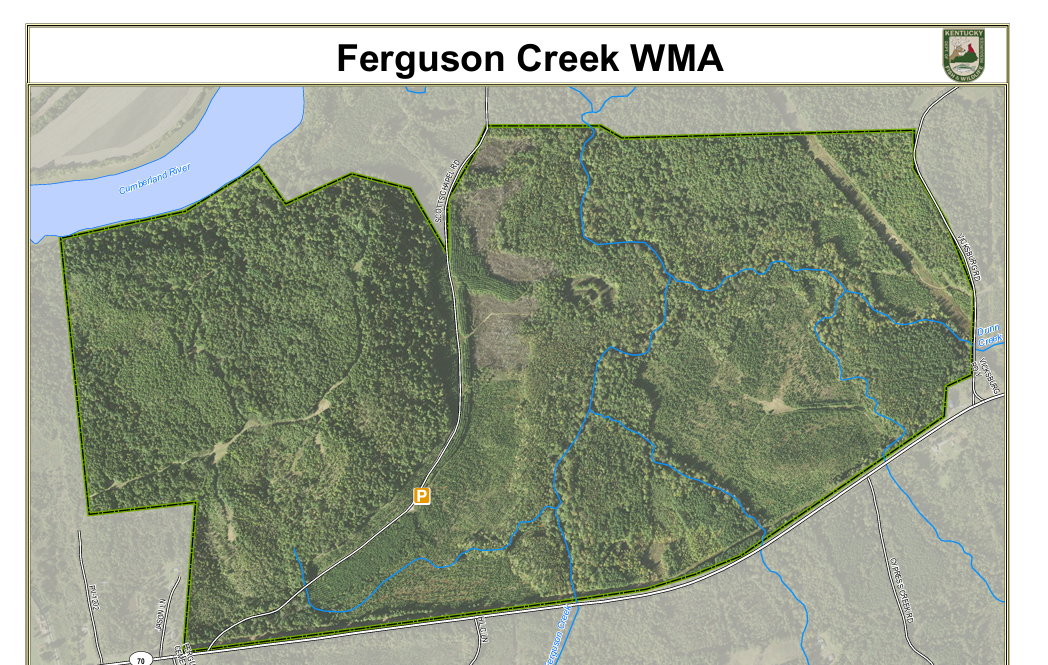
The caves in the Ferguson Creek Sanctuary provide a safe and protected habitat for the endangered gray bat. This category of gray bat is on the federal list of threatened species. Another protected species found at Ferguson Creek is the rare lesser siren salamander. These amphibians are in decline due to pesticides, low water quality, and fertilizers. They are also used as bait for fishing.
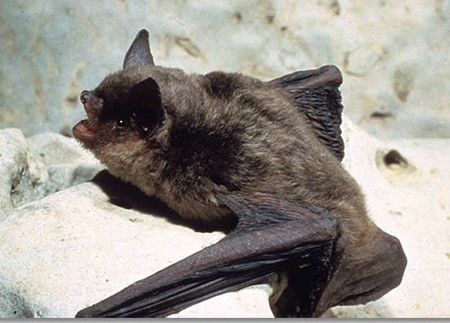
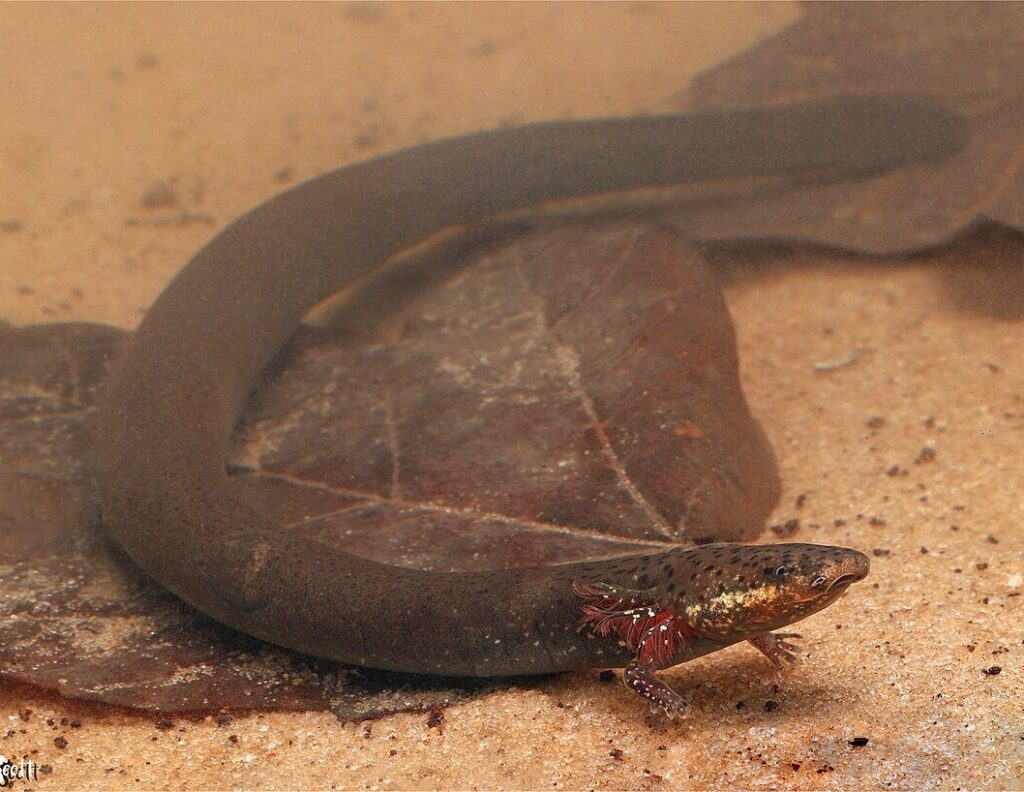

Wood Ducks and Teal visit Ferguson Creek in the fall, along with other waterfowl in the winter.
All types of wildlife and their habitats are being protected in this beautiful sanctuary in Livingston County. The Ferguson Creek Wildlife Management Area is open under statewide hunting regulations. Pictures: Kentucky Firsh & Wildlife Department.
Lilburn & Odar Mae Ramage
April 25, 2025
By Lola Guess
Lilburn Ramage and Odar Mae Doom were very much in love in the early 1930s. The problem was that Lilburn lived near Parker’s Store across the Cumberland River from Tiline, where Odar Mae lived. Lilburn sincerely wanted to visit Odar Mae, so he decided to swim across the river at Pinckneyville. First, he tied a bundle of dry clothes on top of his head, swam the river, landed near the English farm on the Tiline side, changed clothes (left his wet clothes on the riverbank for the return trip), walked down Vaughn Road, and finally arrived at Harvey and Allie Doom’s house to court Odar Mae.
As the romance blossomed, swimming across the river became more frequent as well as problematic. At times, the swift current pushed Lilburn further downriver from where he wanted to land. Barges and other river traffic were dangerous for someone swimming in the river. Lilburn needed a boat. He found a tree to his liking, hewed the log into a canoe, and crossed the Cumberland River with ease.
Since there is more to the story, let’s back up. Lilburn was the son of Issac and Fannie Ramage. Issac and his two brothers were from France, and upon arriving in Salem, lived in a cave. Fannie was half Indian. Lilburn was one of eight children. One of Lilburn’s sisters, named Marie, died in a fire at three years old when her dress caught fire while her mother used a wash kettle.
Lilburn and Odar Mae met at a dance party or “play party,” as these gatherings were called. Musicians from around the neighborhood played fiddles and guitars while everyone danced and enjoyed each other’s company. Weekly “play parties” were in full swing until one night when Lilburn and Zula McDonald were out on the floor. Lilburn picked up Zula and twirled her around, lost his grip, and threw Zula out the window. That broke up the “play parties.”
The play parties may have ended, but the courtship didn’t. Lilburn continued to cross the river to see Odar Mae and became a regular in the Doom household. Harve Doom decided Lilburn was a good worker and hired him to work on the farm. Lilburn moved in with the Doom family. Eventually, Lilburn and Odar Mae married. Lilburn insisted on getting married on his birthday, December 19th. He told Odar Mae that by getting married on his birthday, he wouldn’t forget their anniversary. Lilburn was nineteen, and Odar Mae was sixteen. This was the beginning of a marriage that lasted a lifetime.
The Ramage’s set up housekeeping near Tiline and bought the Sanders farm from Odar Mae’s parents. They raised four sons, Cleveland, Bobby, Orville, and Eddie. Lilburn worked at the Klondike Mine and was later employed by the State Highway Department. Lilburn gave each of his sons land on the farm to build their own houses so he could keep them close. Ralph Smith and Eulen Ramage took notice of all the Ramage houses and had two signs made. Under the cover of night, they nailed up a “Ramageville” sign at both ends of Lilburn’s farm. The community, of course, accused the Ramage family of putting up the signs.
Lilburn’s nickname was “Mule.” He earned this name because if anyone touched or tickled his ears, he would jump, squirm, and swat them away. Since mules don’t like their ears touched, Lilburn became known as Mule Ramage.
Lilburn helped dig graves for people in the community. Sometimes, a newly dug grave would fill up with water, and that bothered Lilburn. He would work to get the water out before the burial took place. This caused him to decide he wanted a mausoleum. A few years before his death, he purchased a mausoleum and had it erected in Leeper Cemetery. Lee Smith lived next door to the cemetery. Lilburn asked Lee how he liked the mausoleum. Lee replied that it would be a good place to store his sweet potatoes for the winter.
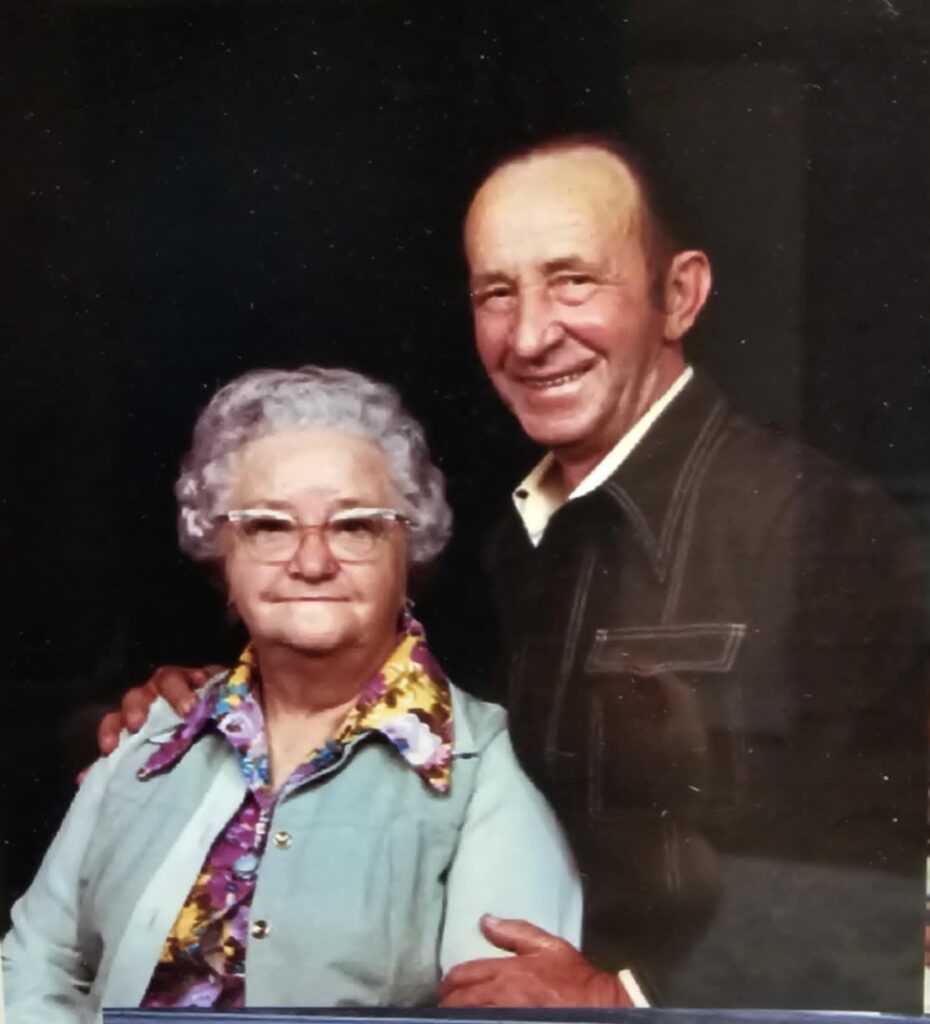
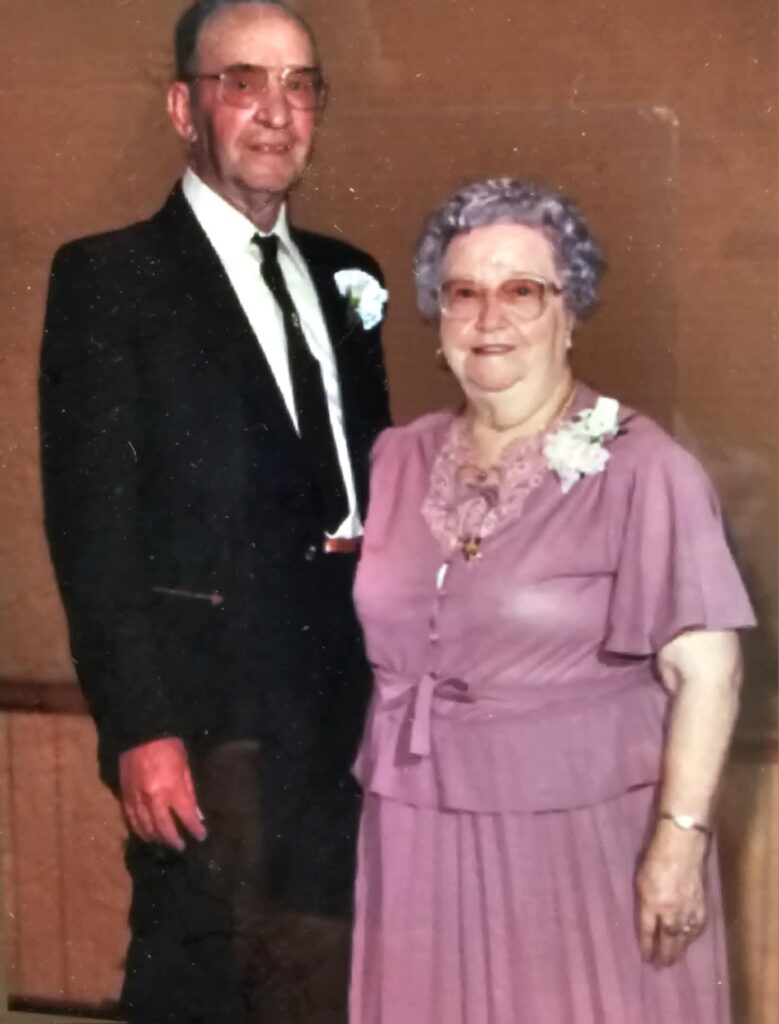
As you can see, Lilburn was a good family man, a strong member of his community, and he loved to have fun. Although he lacked years of formal schooling, he was quick with numbers and “horse trading.” Odar Mae made beautiful quilts, and they gladly shared green beans, beets, tomatoes, and other vegetables from their garden with their neighbors. Lilburn passed away in 1989 at the age of seventy-four. Odar Mae passed away in 2009 at the age of ninety-two.
Even with the passing of several members of the Ramage family, grandchildren and other relatives remain in “Ramageville” today. Lilburn and Odar Mae provided a strong foundation for future generations.
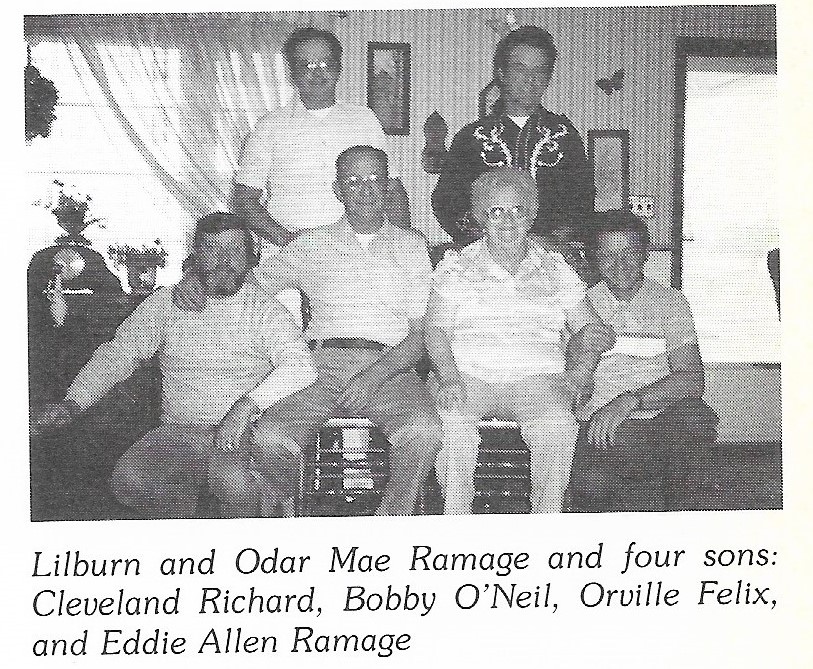
2017 Historical Society Quilt Show
Courthouse Museum - Smithland, Kentucky
Throughout this coming week, there will be quilt displays, vendors, and the quilters themselves arriving in Western Kentucky for the annual quilt show events. The main attraction is the Paducah Quilt Show held in the Quilt Museum. These events make it a good time to look back at the Livingston County Historical Society Quilt Show held in the Courthouse Museum in April of 2017. Local quilters entered antique quilts, works of art, and original designs. This is a sample of the work of talented Livingston County quilters.
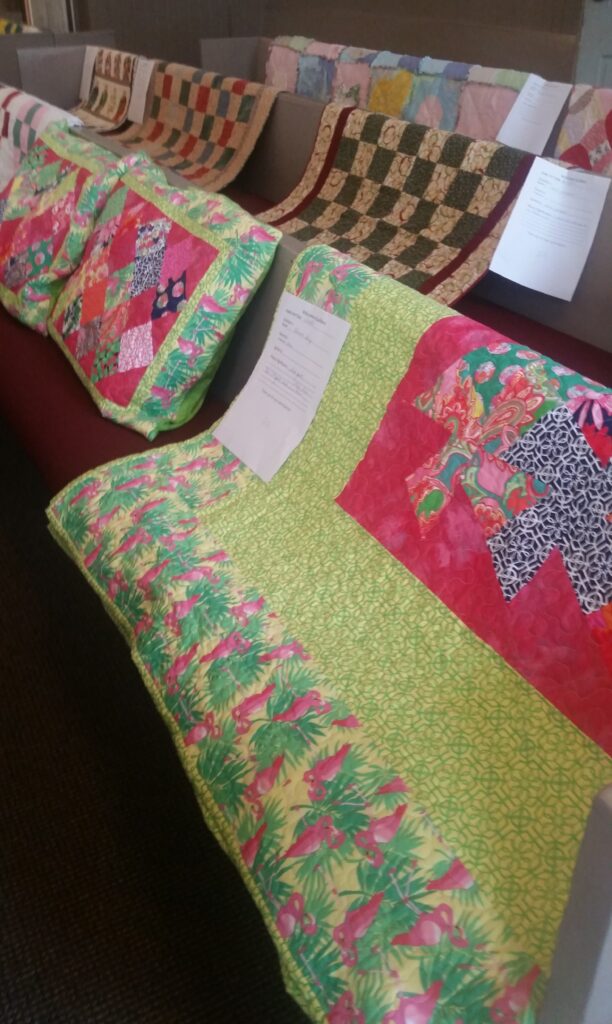
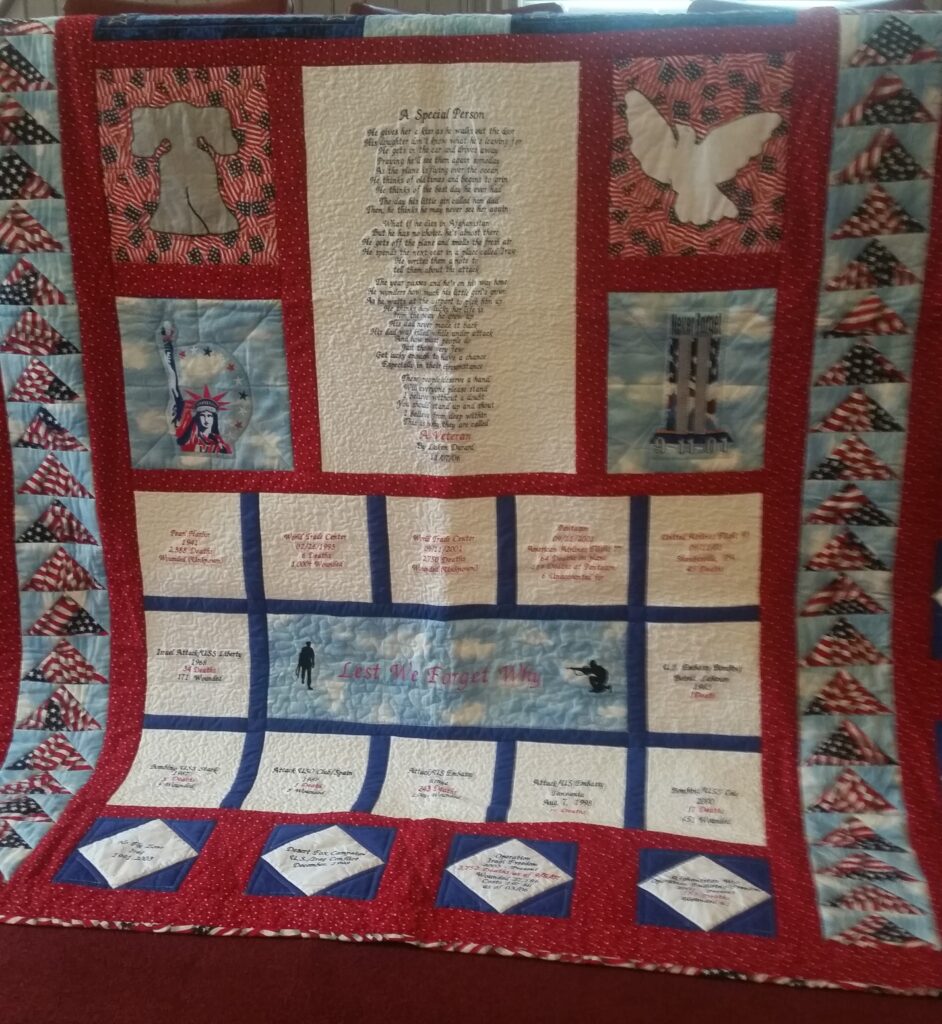
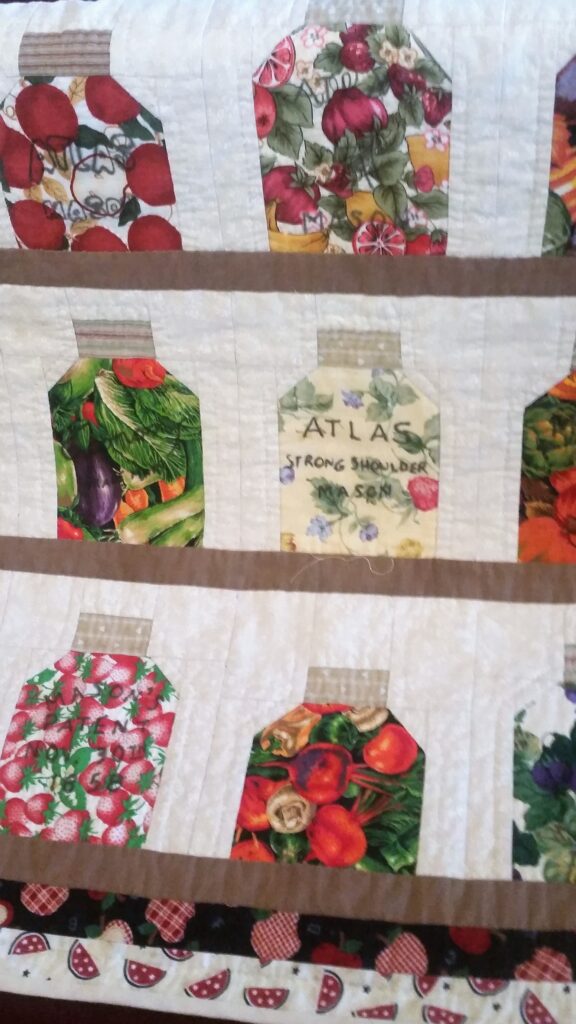
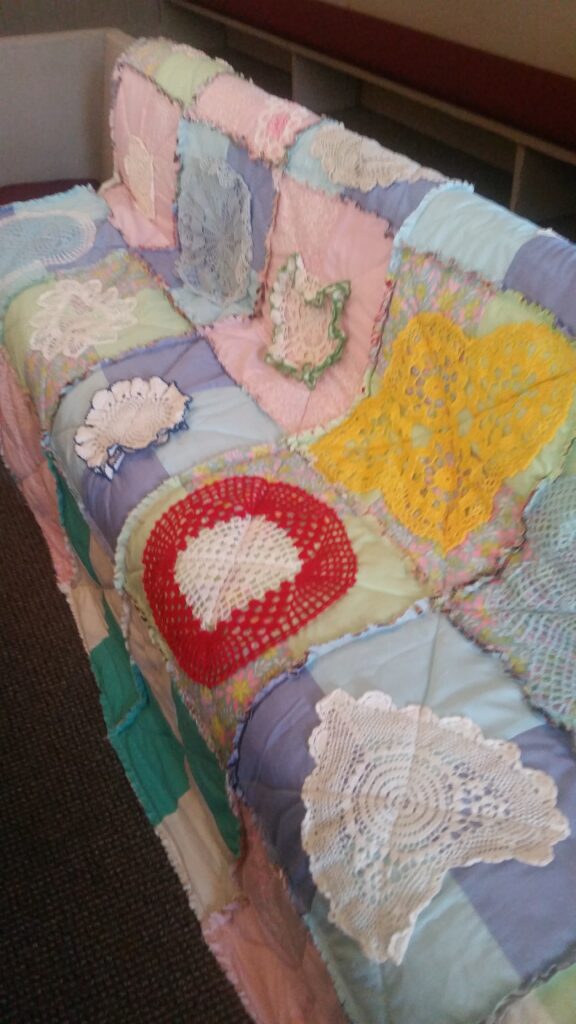
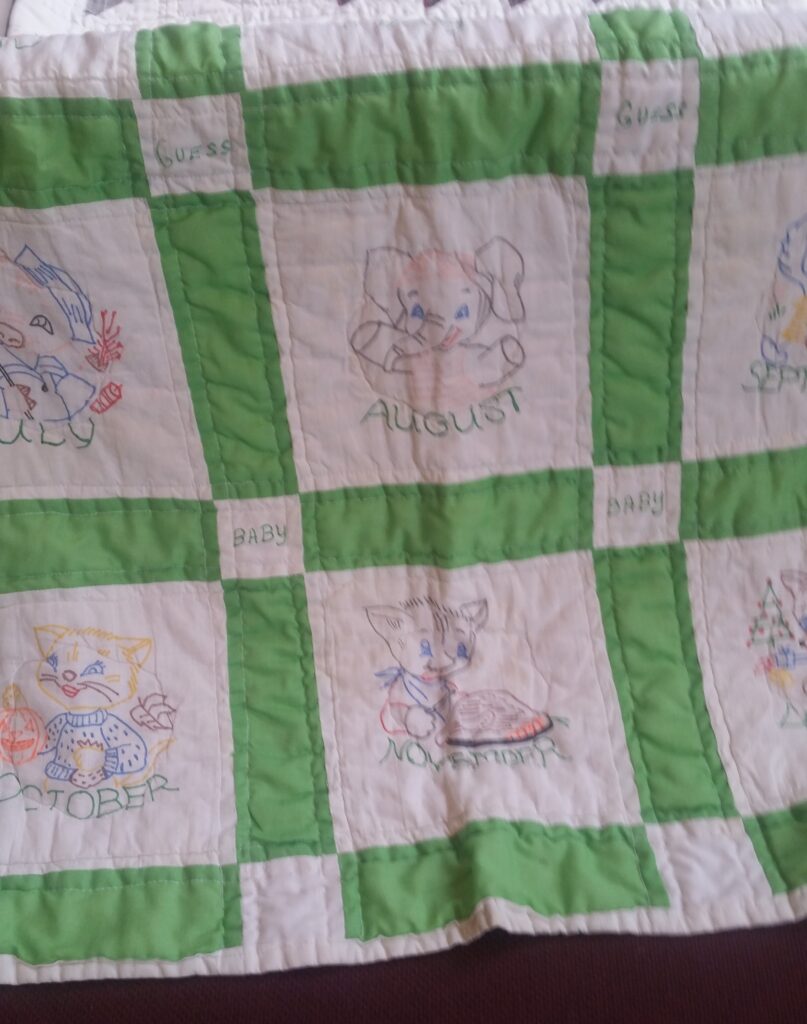
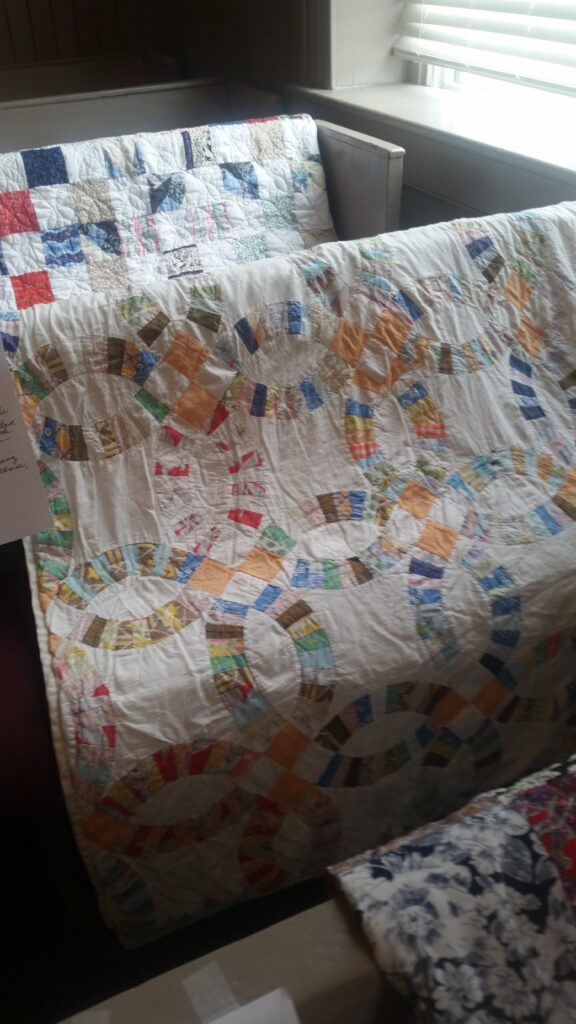
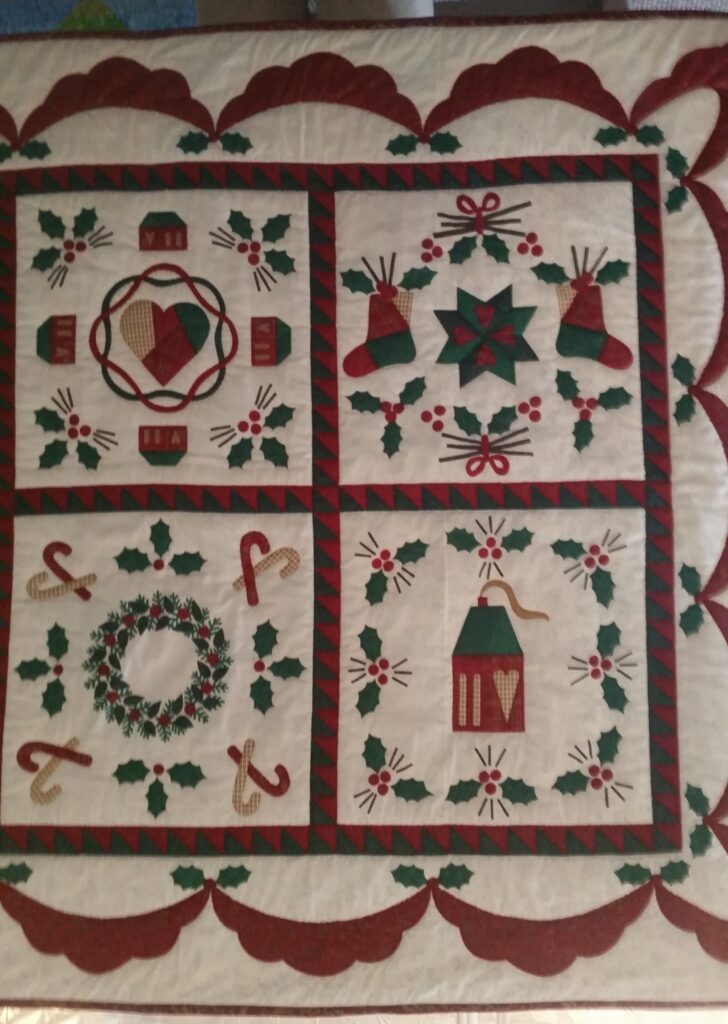

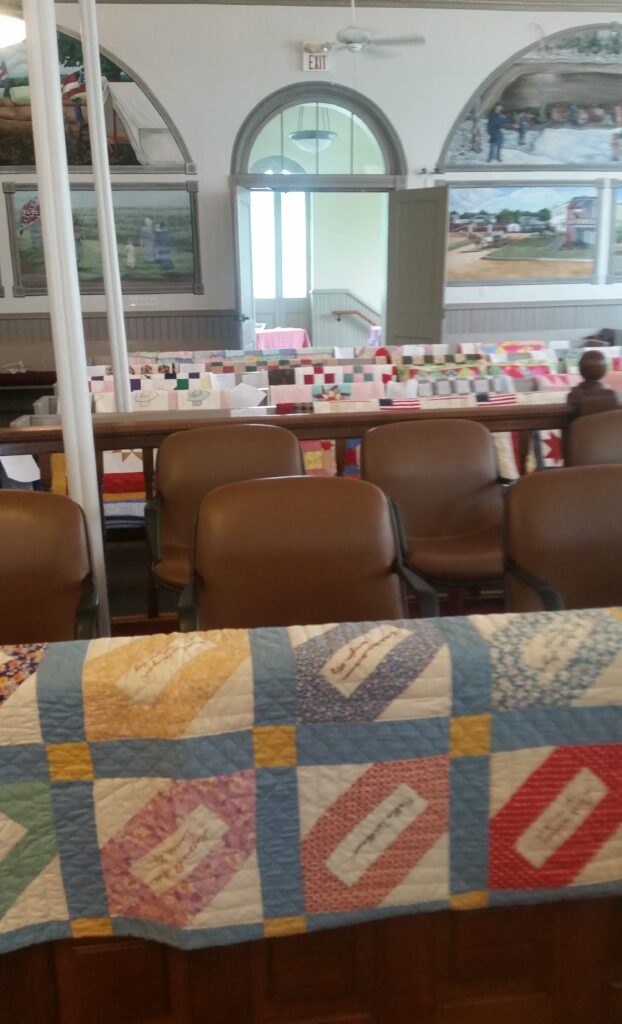
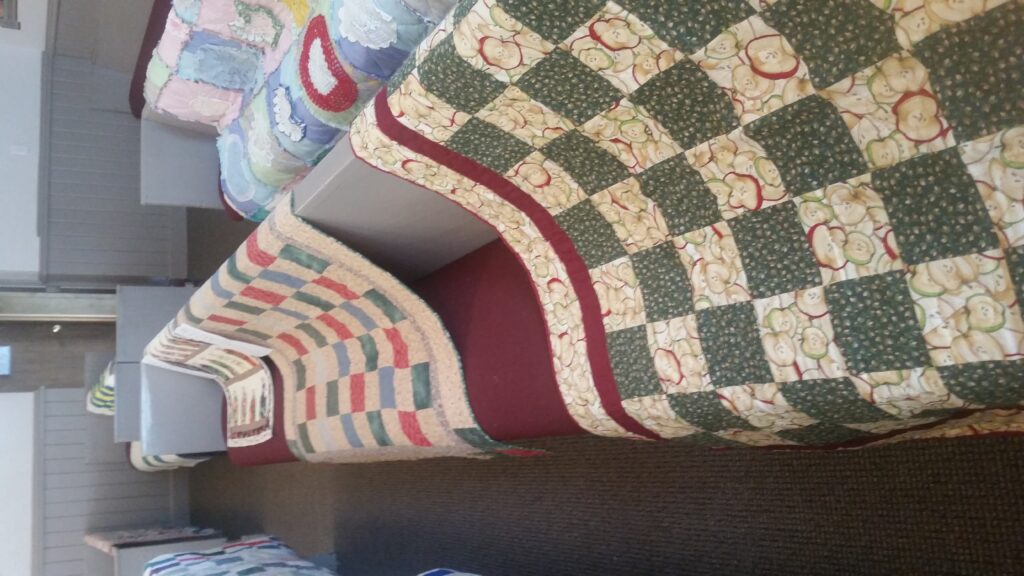
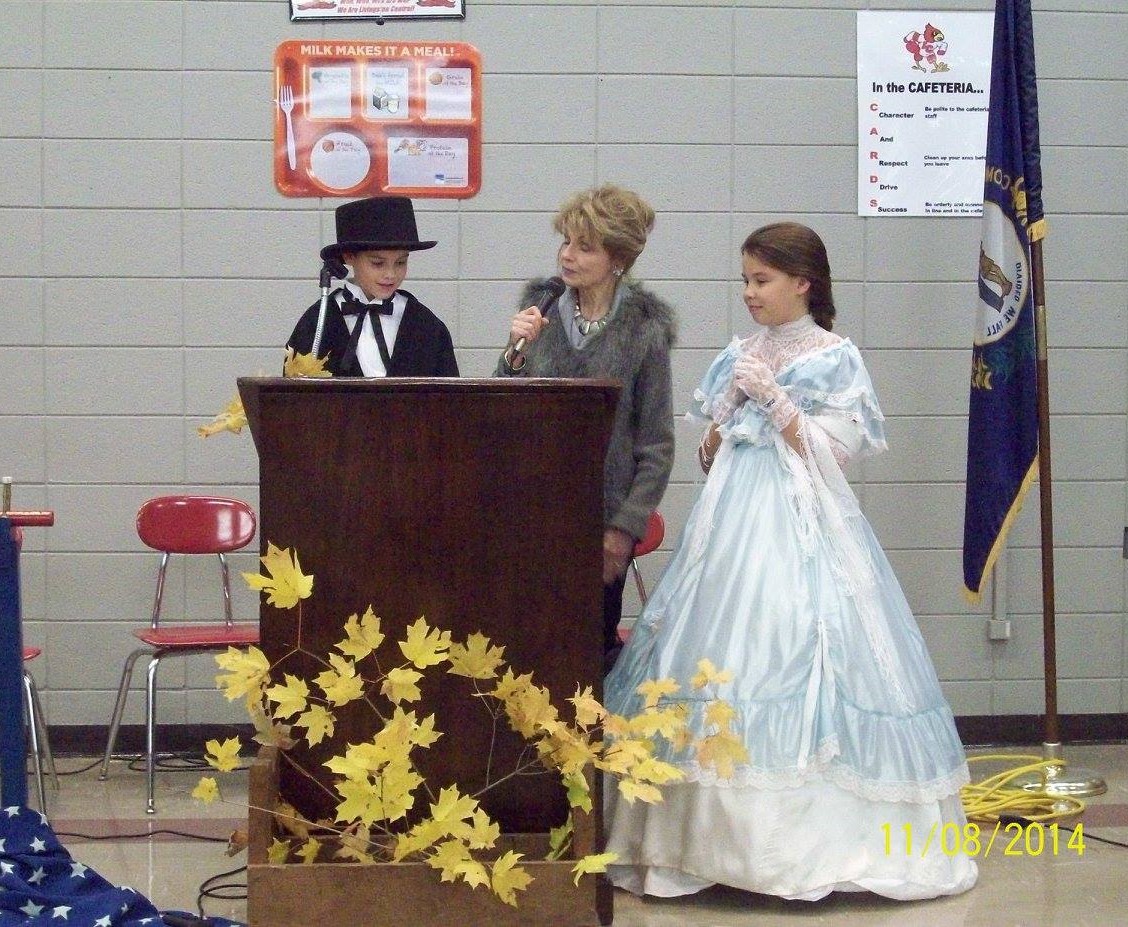
Growing Up in the Livingston County Historical Society
March 14, 2025
By Lola Guess
Barbra Riley is an active and valued member of the Historical Society. When her grandchildren, Katelyn and Hunter, were younger, she brought them to events and meetings at the Courthouse. We look back at memories of those special days.
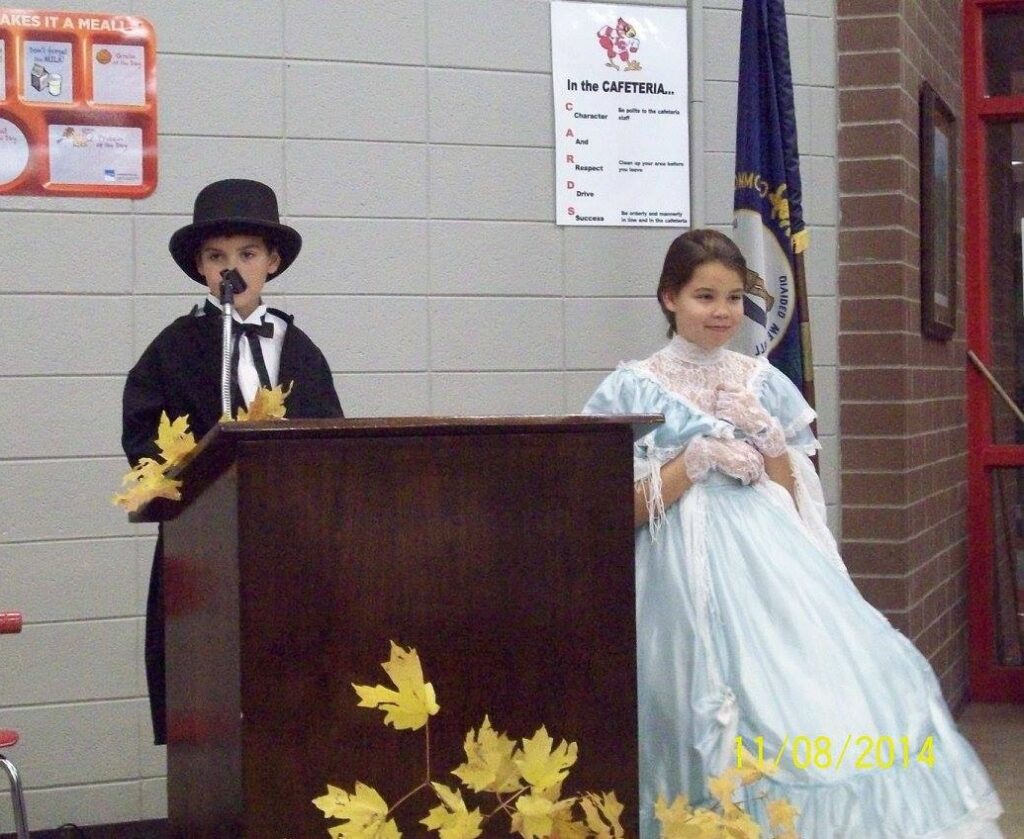
Hunter and Katelyn at the Civil War Dinner. Hunter is reading the Gettysburg Address. He had to stand on a milk crate to reach the microphone. Hunter was seven and Katelyn almost ten.
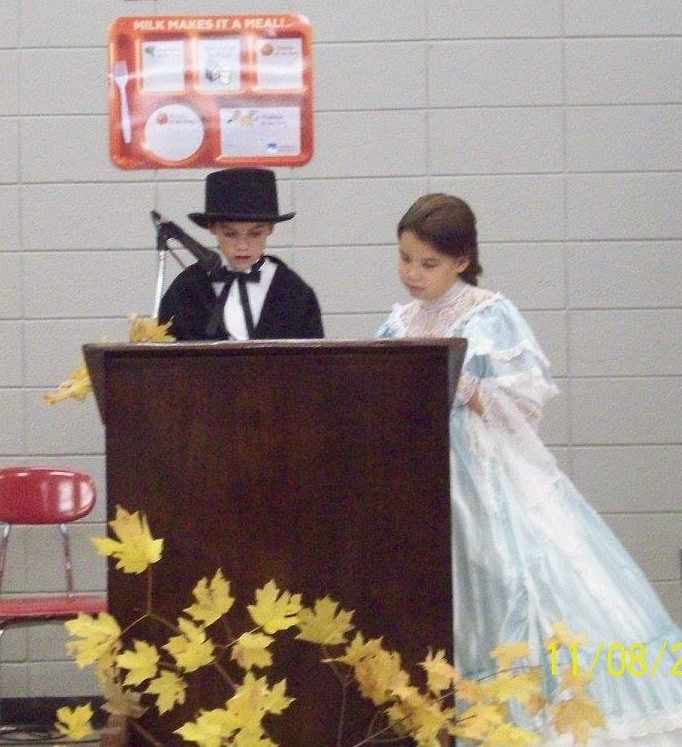

Flag Day at the Museum – Both read a story about a Veteran from Livingston County.
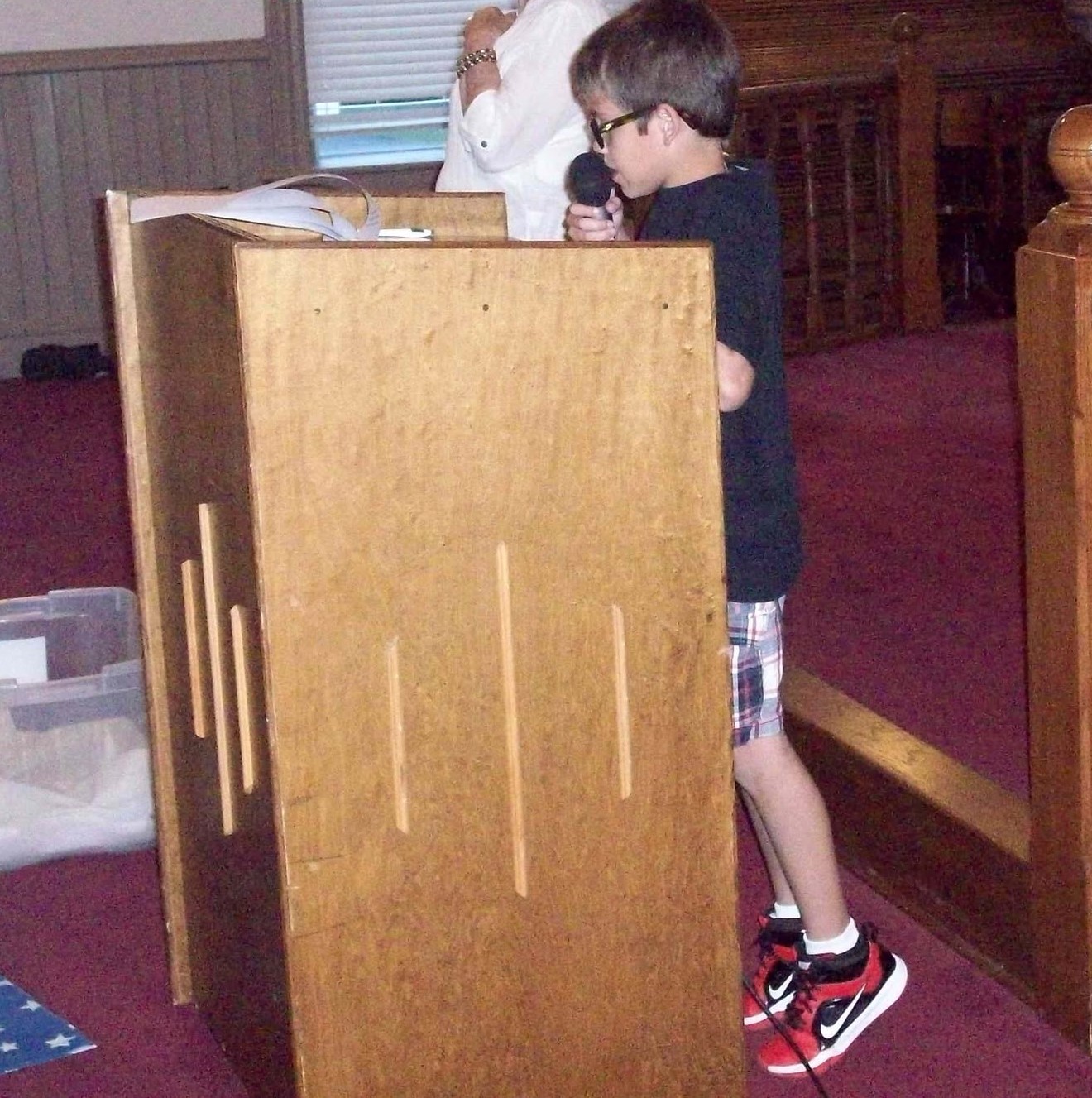
Hunter is on his tippy toes.
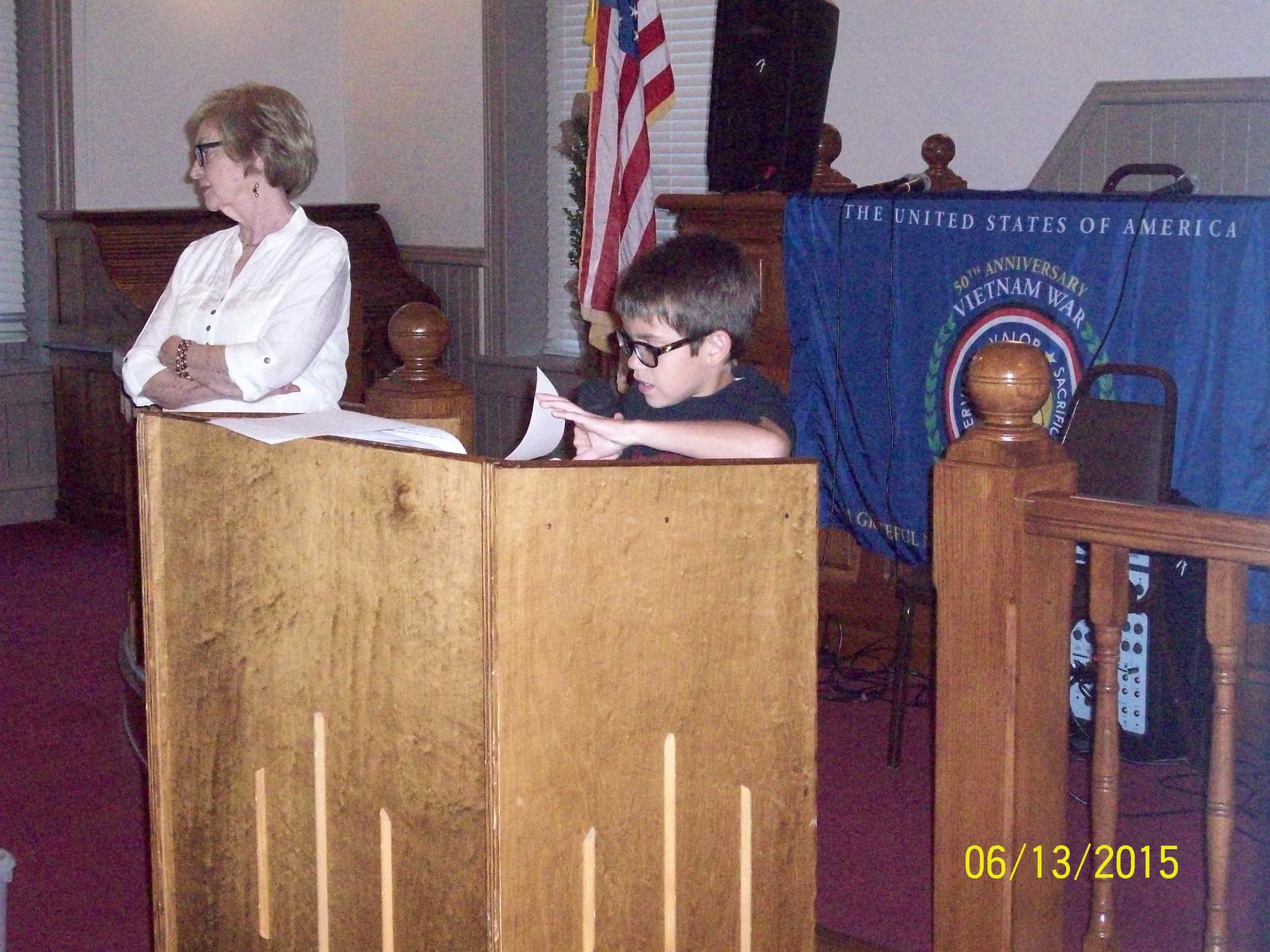
President Judy Wasko watching over Hunter’s presentation.
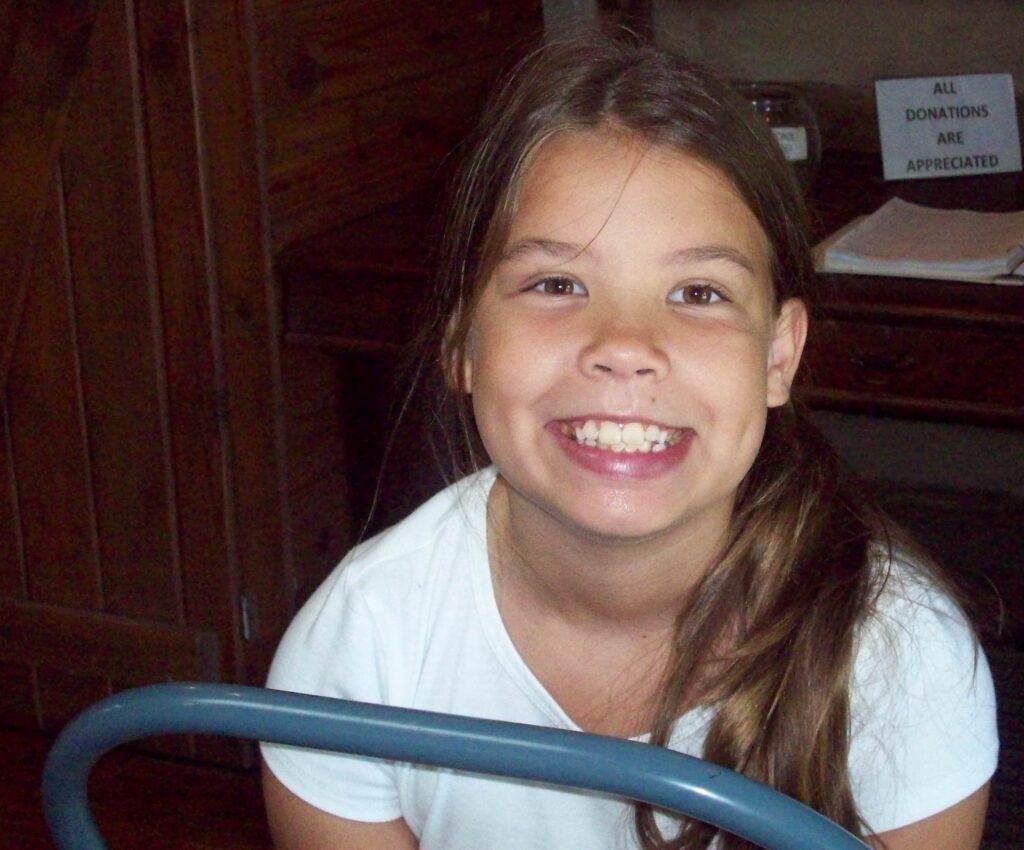
Katelyn is having a good time at the Historical Society.

Hunter is concentrating on finishing the inventory at the Courthouse.
Katelyn, age 20, is a sophomore at Murray State, and Hunter, age 18, is a senior in high school.
Their parents are Micah and Suzanne Riley and grandparents are Ronnie and Barbra Riley, all from Grand Rivers, KY.
Juanita Walker Drennan - Historian
January 31, 2025
By Lola Guess
On July 10, 2017, Livingston County lost a dedicated historian, a devoted mother, sister, and wife. Juanita Drennan passed away at the age of eighty-six and was buried in Scotts Chapel Cemetery.
Virginia Juanita Walker was born on November 13, 1930, to Oliver Noah Walker and Reba Ward. The family lived in Tiline and moved to Smithland in 1940. Juanita graduated from Livingston County High School in 1948. After graduation, she taught all eight grades in one-room schools at Gum Springs and Threlkeld. She raised three sons, Daryl, Kendal, and Lynn Dickerson, and one daughter, Delores Gass.


An article in the Paducah Sun in 1995 states that, along with the Homemakers Club, Juanita published the first book listing cemeteries and death records. This book entitled “Livingston County Cemeteries (1738-1976 )” is one of more than ten county record books Drennan published before 1995. After joining forces with the Homemakers Club to compile this cemetery book, she stated, “I got hooked.” The project ignited her love of preserving the County’s history and cemented the positive impact Juanita had on co-workers, programs, and future undertakings. In 1994 alone, she compiled and published the 1920 Census of Livingston County and the 1910 Census of Crittenden County and continued to work on other Census books.
Drennan received the Individual Award of Distinction from the Historical Confederation of Kentucky in 1995. In the span of approximately fifty years, Juanita received many other awards and was recognized for her steadfast commitment to Livingston County’s history. She continued her research and publishing work at the Livingston County Historical Society until her death.

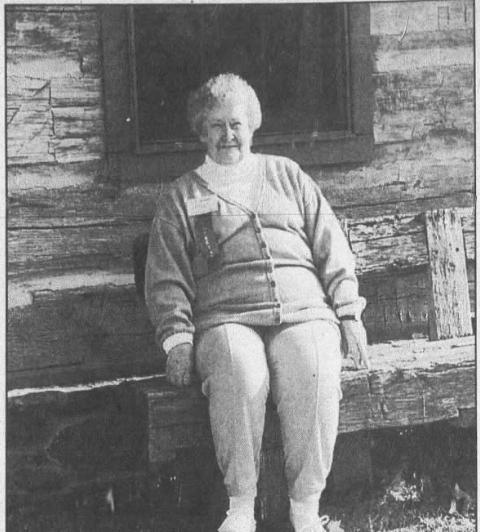
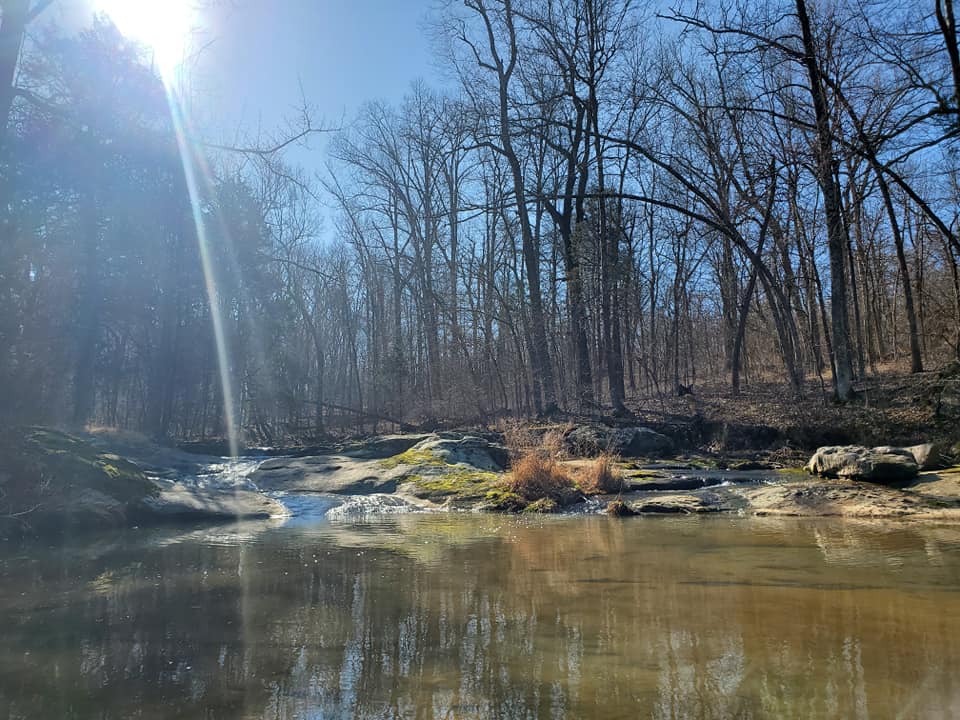
Mandy Falls
January 24, 2025
By Lola Guess
Mandy Falls also known as Joy Falls is located off Highway 133 about two miles west of Joy, Kentucky. The falls are fed by McGilligan Creek. It is a beautiful, quiet, and serene natural wonder.
The legend of Mandy Falls began with Mandy Flanary who lived near the Falls. After Mandy finished her daily chores, she would go to the falls, build a fire, and keep vigil sometimes all night. Mandy seemed to meditate as she sat by the fire at the Falls. When morning came, she returned to her house and cared for her family. Mandy stayed during the rain and snow. No one knows for sure why Mandy kept this nightly mysterious watch. It was speculated that it was because of her Cherokee heritage and that she would sit out there in memory of the Cherokee who camped at nearby Mantle Rock during the winter of 1838-1839. During their stay at Mantle Rock, the Cherokee came to Mandy Falls for fresh water.
Another legend related to Mandy Falls is that of Cherokee Chief Junaluska. The Chief is said to have been part of the Trail of Tears march to Oklahoma and camped at the Mandy Falls- Mantle Rock area. Chief Junaluska was born about 1775 in North Carolina. His name is translated as “One who tries but fails.”
He fought in the Battle of Horseshoe Bend in the War of 1812 alongside Andrew Jackson. Junaluska is credited with saving Andrew Jackson’s life during that battle.
Years later, when President Andrew Jackson met with Junaluska regarding the Indian Removal Act, President Jackson said, “Sir, your audience is ended. There is nothing I can do for you.” Chief Junaluska stated, “If I had known that Jackson would drive us from our homes, I would have killed him that day at the Horseshoe.”
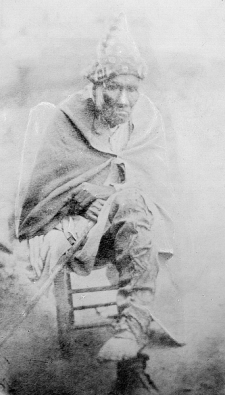
Cherokee Chief Junaluska
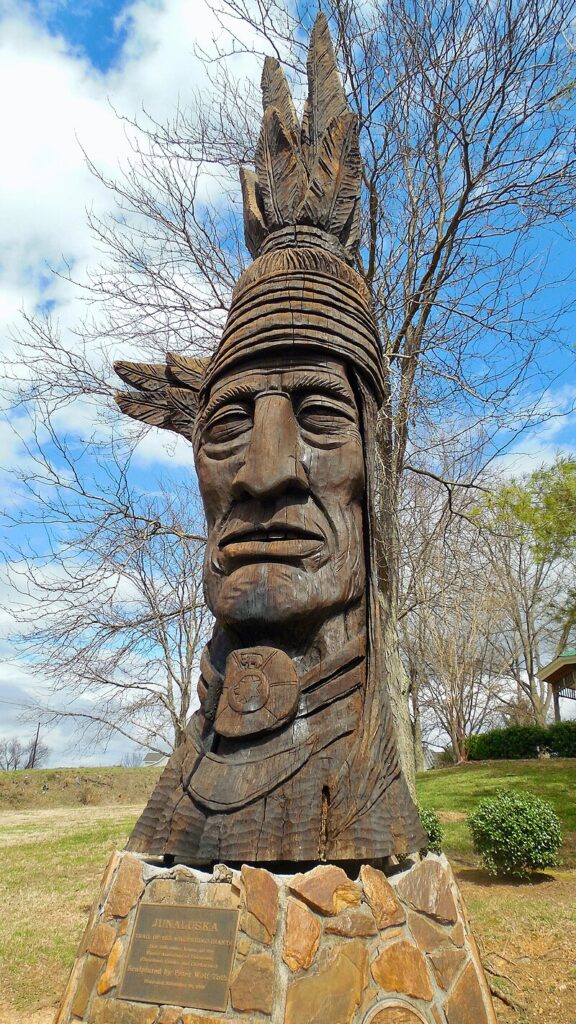
Carving of Chief Junaluska in Johnson City, Tennessee
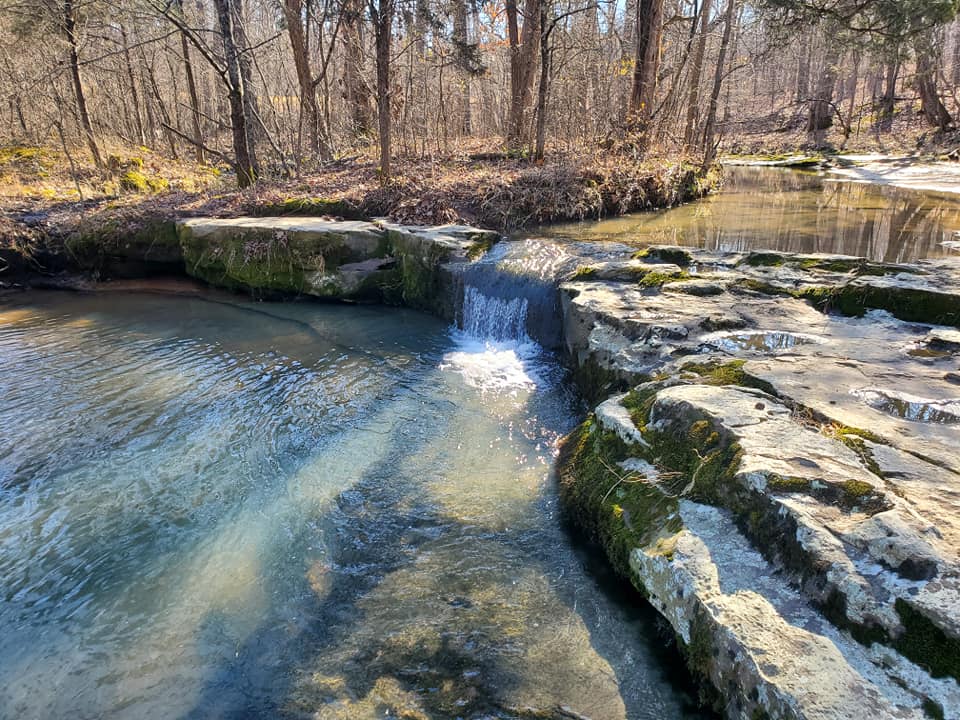
Photography by Mark Trail
Georgia McGrew Edwards - Artist
January 17, 2025
By Lola Guess
At the turn of the century Livingston County native, Georgia McGrew Edwards painted a four-foot by seven-foot oil painting of the natural sandstone bridge known as Mantle Rock in Livingston County, Kentucky. On March 15, 1904, the painting was shipped to the St. Louis World’s Fair to be exhibited at the Kentucky Building. Mrs. Edwards’ father had requested that his daughter paint Mantle Rock for the exhibition.
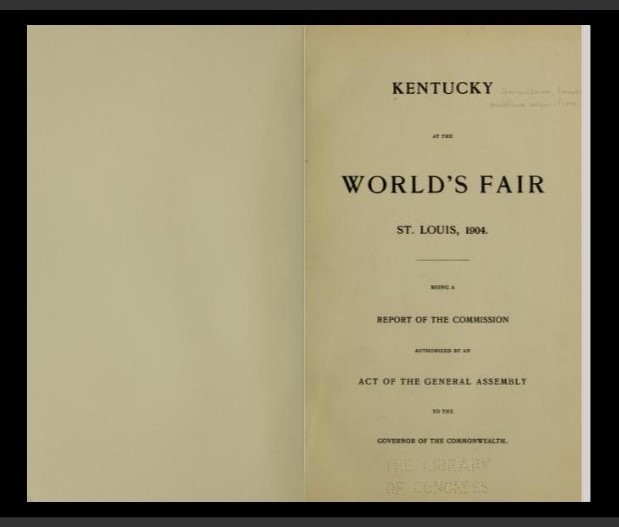
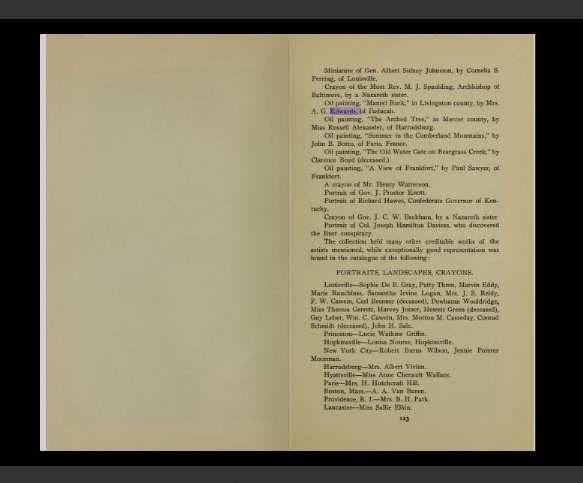
In 1915, Martha C. Grassham Purcell wrote about this event in her book “Stories of Old Kentucky.” Purcell wrote, “Mantel Rock, or Natural Bridge, in Livingston County, its picturesqueness rivals the far-famed Natural Bridge of Virginia. This rock, resting against the hillside, is eight and three-fourths feet thick and twenty feet wide; its arch spans two hundred twenty feet. One of the paintings that attracted the most attention in the Kentucky Building at the St. Louis World’s Fair was the artistic reproduction of this picturesque place by Mrs. Georgia McGrew Edwards.”
In May 1915, the Mantle Rock painting was displayed at the Federation State-wide Exhibit of Living Kentucky artists in Lexington, Kentucky. The approximately two hundred paintings were some of the finest contemporary artwork ever gathered at that time. Mrs. Edwards’ reputation as an artist continued to gain popularity and she earned thirty-three awards at the State Fairs in Louisville, Kentucky.
Soon after the successful exhibit in Lexington, Mrs. Edwards donated the original painting to the newly formed Art Gallery of Paducah, Kentucky. In 1934, the painting was listed in the collection of Mrs. C. E. Purcell of Paducah.
Georgia McGrew was born on April 14, 1872, in Livingston County and was the daughter of G. N. and Mary Elizabeth Rogers. G. N. and Mary Elizabeth owned a farm in Bayou which remains in the McGrew family today. After graduating from local Livingston County schools, Georgia attended Lindland College in Glendale, Kentucky. She studied at the Cincinnati Art School and taught art for three years in high school in Marion and Grand Rivers, Kentucky. Georgia soon established a private studio at her home on Jefferson Street in Paducah.
Georgia McGrew was married to A. G. “Gus” Edwards a Paducah businessman. They had one daughter, Mary Elizabeth Edwards. Mrs. Edwards passed away on January 1, 1949, at seventy-six years of age. She is buried in Oak Grove Cemetery in Paducah.
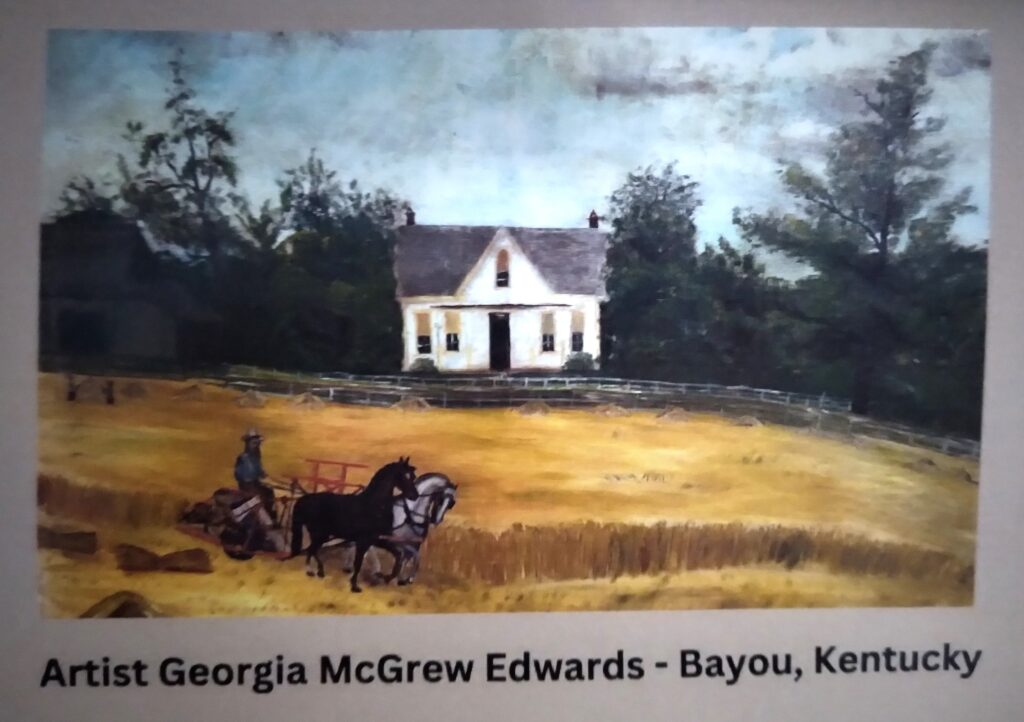
Note: I could not find any pictures of the Mantle Rock painting. If anyone has information about Georgia’s painting, please let us know.
Research Sites
January 10, 2025
By: Lola Guess
Searching for ancestors and building a family tree is not an easy task. However, research has become easier than it was before the internet. Genealogy websites make finding long-lost relatives a fun project until you hit a brick wall and don’t know where to search next. There can also be surprises along the way. Maybe you didn’t know your great-grandfather had two wives (not at the same time) or you thought your relatives landed in North Carolina and traveled west and then you find out they lived in Boston. I have listed some websites that might be helpful. Most public libraries offer free access to some of the most popular websites. The McCracken County Library has an extensive genealogy collection as well as some of our surrounding counties.
Come and do your research at the Livingston County Historical Society Office at the Log Cabin in Smithland. We have books and files on local families, books written by local historians, maps, and pictures. The cabin is open on Wednesdays and Fridays from 10:00 until 2:00.
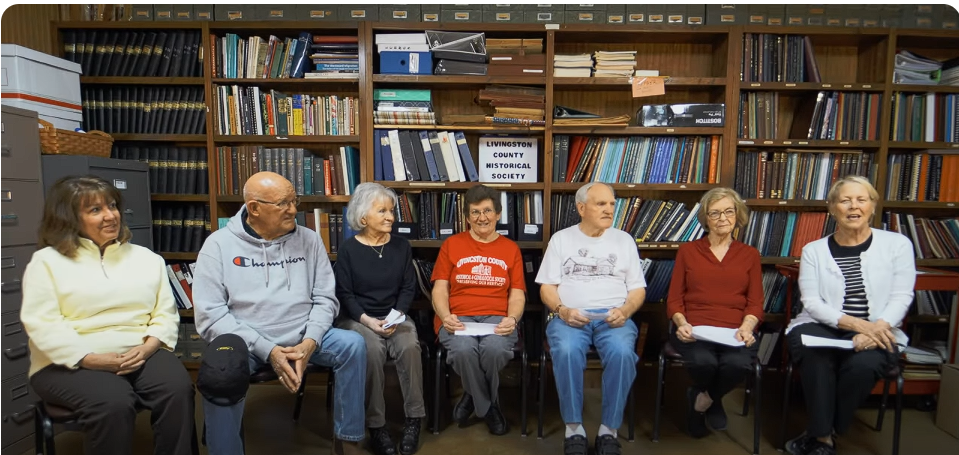
Check out these volunteers who are ready to help with research. As you can see, we have a lot of research material and there is another room of books as well.
Visit the Website: https://lchgs.org
Join the conversations on Facebook and see what others post about their relatives and our county.
Plan a tour of the Livingston County Historical Courthouse Museum and enjoy historical displays, pictures, movies, murals, antiques, and artifacts. We are constantly adding to our collections. The Museum will open again in the spring.
I have listed websites that are familiar and some that maybe you have not visited before. Please add any websites you use in the comments on Facebook, so that others may discover places that will help in researching our ancestry.
Ancestry https://www.ancestry.com $
FamilySearch https://www.familysearch.org
Newspapers.Com https://www.newspapers.com $
Chronicling America (Library of Congress) – https://chroniclingamerica.loc.gov
Fold3 https://www.fold3.com $
Social Security Administration – Freedom of Information Act – request a copy of a deceased person’s original application for a Social Security Card – https://www.ssa.gov/foia/request.html
National Archives Military records (pension files) – https://www.archives.gov/veterans/mil
National Archives https://www.archives.gov/research/cat…
Google searches – https://www.google.com
Google Books and other book sites https://books.google.com/ or https://www.hathitrust.org/ or https://archive.org
Google Maps https://www.google.com/maps
Black’s Law Dictionary – download at https://heimatundrecht.de/sites/defau.
Census enumerator instructions – https://usa.ipums.org/usa/voliii/tEnu
Genealogy Bank https://www.genealogybank.com
Stephen P. Morse information on passenger lists https://stevemorse.org
Behind The Name https://www.behindthename.com 17:51
Bureau of Land Management records – land patents – https://glorecords.blm.gov
Map of US – historical map https://www.mapofus.org
David Rumsey Map Collection https://www.davidrumsey.com
DNA Relationship Chart https://thegeneticgenealogist.com/wp
DNA Painter https://dnapainter.com
FamilyTreeMaker https://www.mackiev.com/ftm $
RootsMagic https://www.rootsmagic.com/
Myheritage.com
Findmypast.com
Archives.gov
KentuckyGenWeb and USGenWeb
Kentucky Historical Society https://history.ky.gov
Heritagequest.com
23andme.com
Wikitree.com
Findagrave.com
DAR (Daughters of the American Revolution) https://dar.org
Cyndislist.com
Memories of Growing Up in Smithland, Kentucky
Excerpts by Dickie Berry
December 6, 2024
“The Methodist Parsonage – The Methodist Church where we belonged. My Sunday School teachers were Mrs. Gorgie Wilson, Mrs. Elvis Rudd, Mrs. Rogers, Mrs. Mahan. Between Sunday School and Church Gary Barnes would take us all boys for a ride in his dad’s Oldsmobile. One Sunday we went all the way to Dyer Hill to see where a truck load of onions had turned over. Some of the pastors I remember, Kenith Stuart, Bro. Morrison, Bro Walker, Bro. Stuart was my favorite. He could really play a piano. They had a daughter name Dixie Eason. We had Boy Scout meetings in the basement. Mr. Ed Hank was the Scout Master. During the 1950 flood Mahan’s had their store in the basement.”
“The sheriff’s office was a busy place. Eulen Ramage was the first sheriff I remember. Rol Driskill was one of Eulen’s deputys. They didn’t get much sheriff work done on Mondays because they went to Mayfield Cattle Auction, Berry & Whitford Stock Yards. When school was out I would ride to Mayfield with them in Rol’s 1947 Chevy truck with cattle sides. They would tie my suitcase to the cattle rack. I would set between Eulen & Rol. Rol always had a gun and a qt. of whiskey in the seat. When summer was over, after spending the summer with Uncle Roy and Aunt Lizzy, I would ride back home with them.
I was setting in front of the post office, had just got my drivers license. Eulen ask me to go with him and drive him and J. O. Pierce (?) to Marion, Ill. J. O. was drunk and had been for some time. We took off about 10:00 a.m. Eulen had a 1954 Chevy 4 door. We stopped at Brookport, got gas. Eulen bought two Pepsi colas. J. O. drank them while the man filled the car with gas. Got to Marion, Ill. Veterans Hospital. They would not keep him. So we took him back to Paducah to the AAA. Ended up taking him back to Salem. Eulen had a bottle of whiskey and would give him a drink once in a while. Boy that was a long day. Don’t know what ever happened to J. O.”
Dickie Berry’s book has page after page of his memories of growing up in Smithland. There are many pictures Dickie has collected of the people and places he remembers. Book is available at the Log Cabin in Smithland, Kentucky.
Katie Davis Love
November 22, 2024
By Lola Guess
The “Walking Driving Tour of the Historic Smithland Cemetery” contains this article about Katie Davis Love (1875-1962).
“A very eccentric lady, Ms. Katie, was a former Livingston County Circuit Court Clerk who lived upstairs in the Richard Olive House (now known as the Rudd House and listed on the National Register of Historic Places). The house is located across the street from the Livingston County Courthouse Annex and Library. This house was built around 1840 by Richard Olive. Richard Olive (1804-1847) and his wife, Evalina (1808-1857), are buried at the top of the hill near the Reverend G. G. Moore. The parents of Katie Davis Love bought the house from the Olive family around 1858. This house had an unusual daughter’s bedroom upstairs which was called a “safe room.” It was called a “safe room” because the only stairs to and from the bedroom was in the parent’s bedroom on the lower floor. In her later years, Ms. Love became very reclusive and would lower a basket from the upper balcony of the house to the ground for groceries to be delivered to her. Ms. Love had a big pear tree in her yard which local kids were told she guarded with a shotgun. Only a select few were allowed in her house or around her pear tree.”
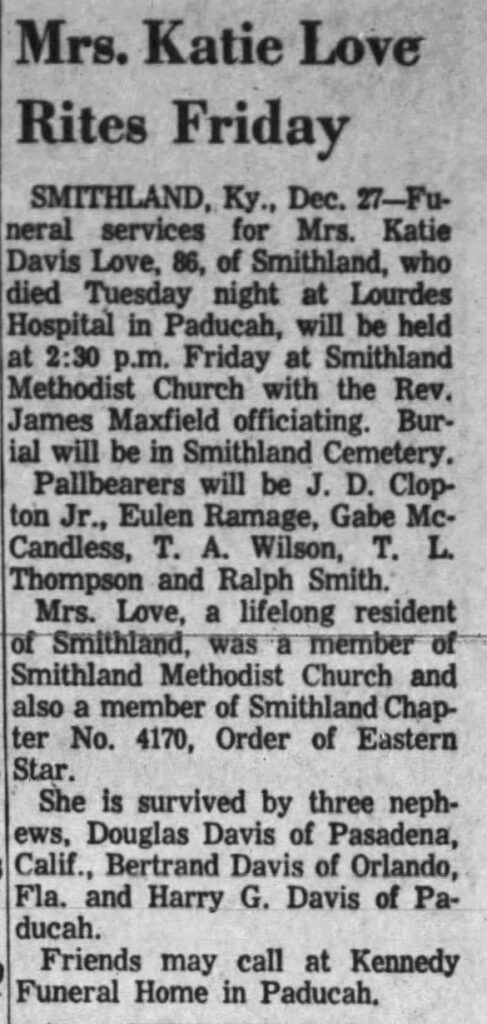
Katie Davis Love Obituary – 1962

Katie Davis Love Auction – 1963
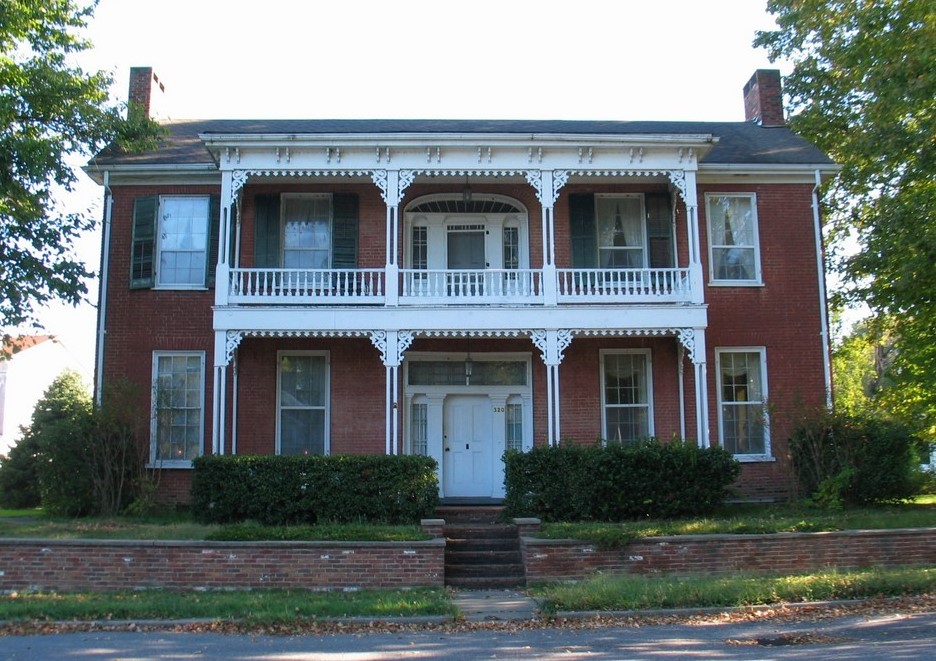
Katie Davis Love House (Rudd House)
Katie married Quincy B. Love in 1895. At the time of their marriage, he was 23 and she was 20 years old. Her parents were Charles B. Davis (1845-1927) and Ida Cade Davis (1851-1930).
The Walking/Driving Tour of the Historic Smithland Cemetery” is available at the Log Cabin in Smithland ($5.00). There are interesting stories of many people buried there as well as a map of the Cemetery.
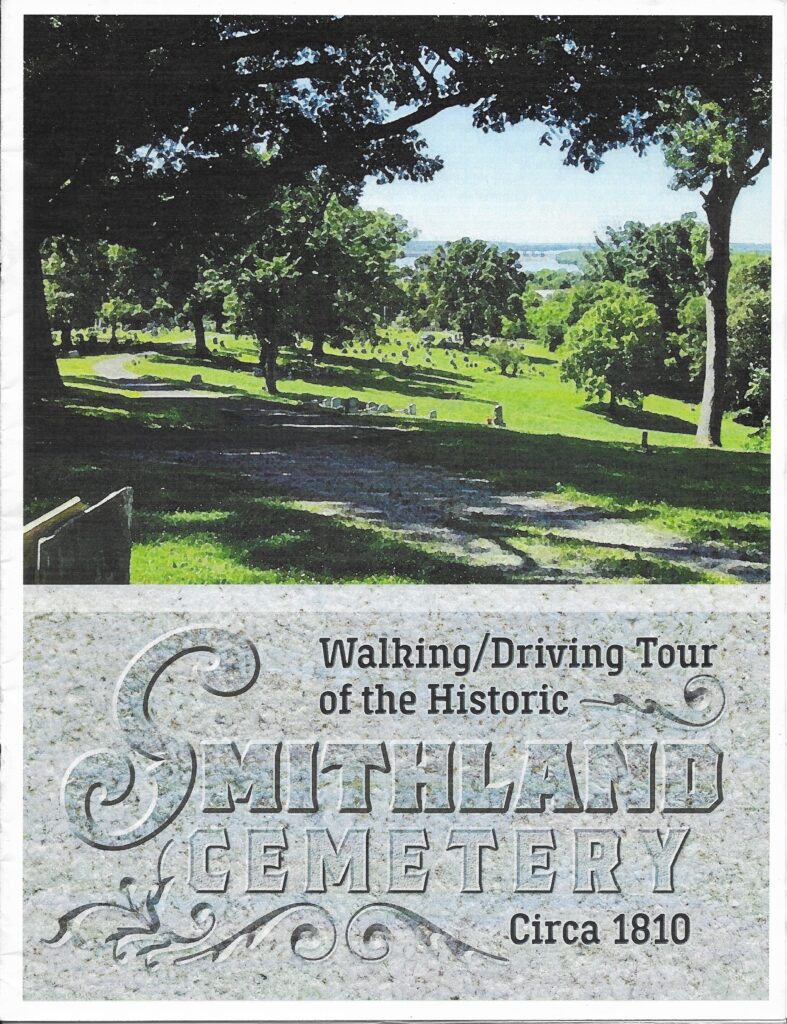
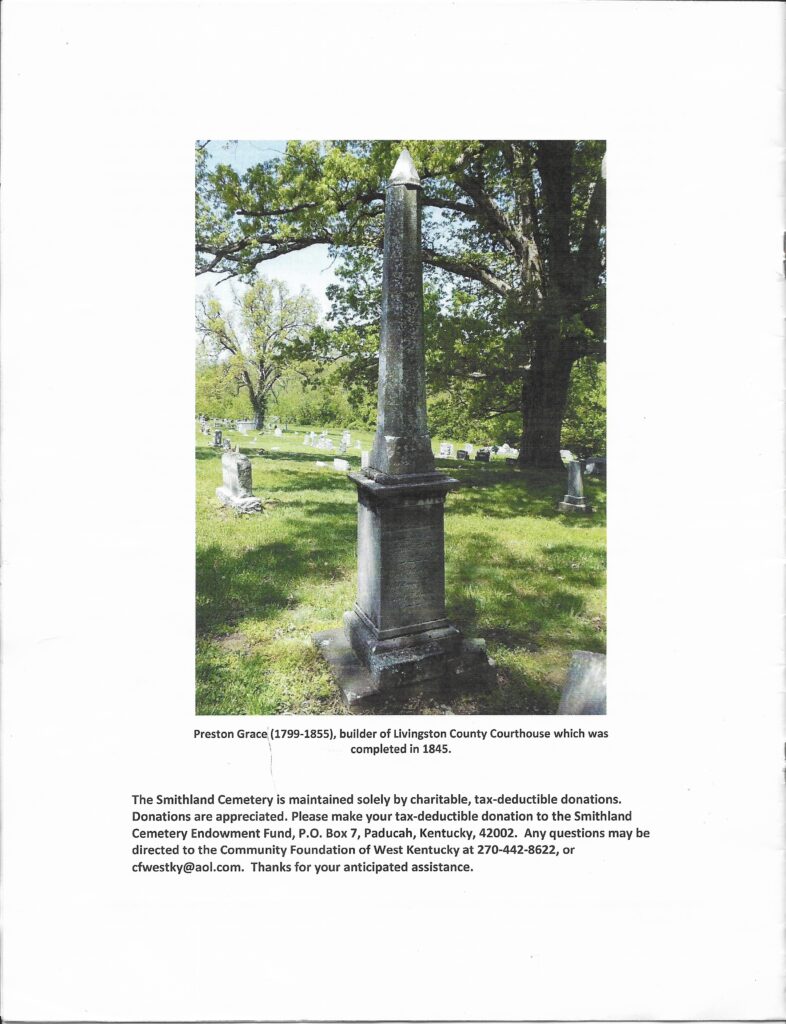
Kentucky - Livingston County
Deer Hunting
November 15, 2024
By Lola Guess
Livingston County’s deer season is in full swing. Hunters have several options to choose from including bow hunting, muzzle loading, gun season, and senior and youth hunts which all have different dates, rules, and regulations. There are rules for residents, checking, tagging, licensing, bag limits, types of equipment, age, and the list goes on. Game wardens were first appointed in 1904 to enforce regulations that were in place at that time. In 2023, the deer harvest totaled 1,594 in Livingston County with a statewide total of 141,142 according to the Kentucky Fish & Wildlife Department.
Deer hunting in Kentucky has a long and varied history. Dr. Thomas Walker reported in 1750 that deer were plentiful in portions of Kentucky. Around 1767, John Finley hunted along what is now the Kentucky River. He told Daniel Boone about the abundant deer he found there. Daniel Boone settled in Kentucky in 1775. In 1787, a settler named Mose McWaters stated he was able to “kill all he wanted without leaving the cleared area around his cabin.” In 1819, venison hams were sold for fifteen cents each, but the large numbers of deer didn’t last long because of settlers crossing the mountains and coming from the east.


Timeline of the Highlights of Deer Hunting in Kentucky:
1775: The Virginia Colonial Legislature, which governed Kentucky before statehood, passed laws to regulate deer hunting for the hide trade.
1894: The Kentucky legislature outlawed killing deer from March 1 to September 1 due to a depleted herd.
1912: The Kentucky Game Commission was formed.
1915: A field survey revealed that deer were almost extinct in Kentucky.
1916: The Kentucky General Assembly prohibited deer hunting in response to the recommendation of the Division of Game and Fish.
1929: Isaac Bernheim released fifteen red deer from Europe on his property in Bullitt County.
1946: The first legal deer hunt in Kentucky since before World War I was held, focusing on red deer.
1969: The first crossbow season in Kentucky was held at the Pioneer Weapons Wildlife Management Area.
1981: The first time a season kill exceeded 10,000 deer, with 14,983 deer checked.
1991: Kentucky established a limit of one antlered buck per season.
1999: Deer restoration ended, and all 120 counties were open to deer hunting for the first time.
The whitetail deer population in Kentucky is estimated to be 985,386 in 2023, and about the same in 2024. Hunters in Livingston County, enjoy the 2024 season!
Flags in Livingston County - Veterans Day
A Look Back at The Lions Club Telethon of Stars
November 1, 2024
By Lola Guess
In the past, as soon as Halloween was over, Western Kentuckians turned their attention to the annual Lion’s Club Telethon aired on WPSD-TV. This fundraiser was a joint effort between the TV station and the Paducah Lions Club to raise money for disabled children and adults. The funds were donated to charities and facilities such as the Easter Seals of West Kentucky and various other organizations.
The first telethon was held in 1957 and raised $8,000.00. Thereafter, benefits were held throughout the year in almost every county in Western Kentucky. Churches, Sunday school classes, clubs, individuals, schools, and collections on street corners were a few of the fund-raising efforts. In 1981, over $548,000.00 was raised in a single year. The WPSD-TV station was overwhelmed every year with visitors waiting to get in to turn over their collections.
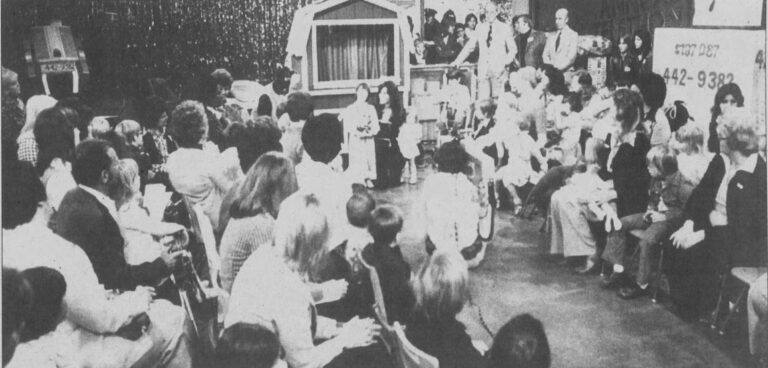
Celebrities from across the United States came to Paducah to support the telethon. This is a partial list of those who traveled to Paducah, in the 1960s to lend their time and talents.
1958 – Anita Bryant
1959 – Betty White
1960 – Merv Griffin
1961 – Bob Barker
1962 – Rita Hays
1963 – Art James
1964 – Gene Rayburn
1965 – Ed Ames
1966 – Doc Severinson
1967 – Leonard Nimoy
1968 – Archie Campbell
1969 – Grandpa Jones
In the 1970s and 1980s, Michael Landon, Ralph Emery, Barbara Mandrell, Willard Scott, and Jerry Reed, were included among the guests to appear along with numerous other celebrities and local talent. These performers were on the air all through the night. People in this area looked forward to parties, sleepovers, staying up all night, and a trip to the TV station to see the Telethon.
The “Singing School Teacher” Dorothy Olsen (Olson) was an anchor on the program in the early years. Mrs. Olsen first appeared in 1958 and continued every year until 1975. This was the last year she was listed as a participant. Dorothy was a schoolteacher from White Plains, New York. She appeared on “Name that Tune” and won $25,000.00 and was given an RCA Recording contract. Her song “Little White Duck” sold more than a quarter-million copies. She went on to make several other recordings.
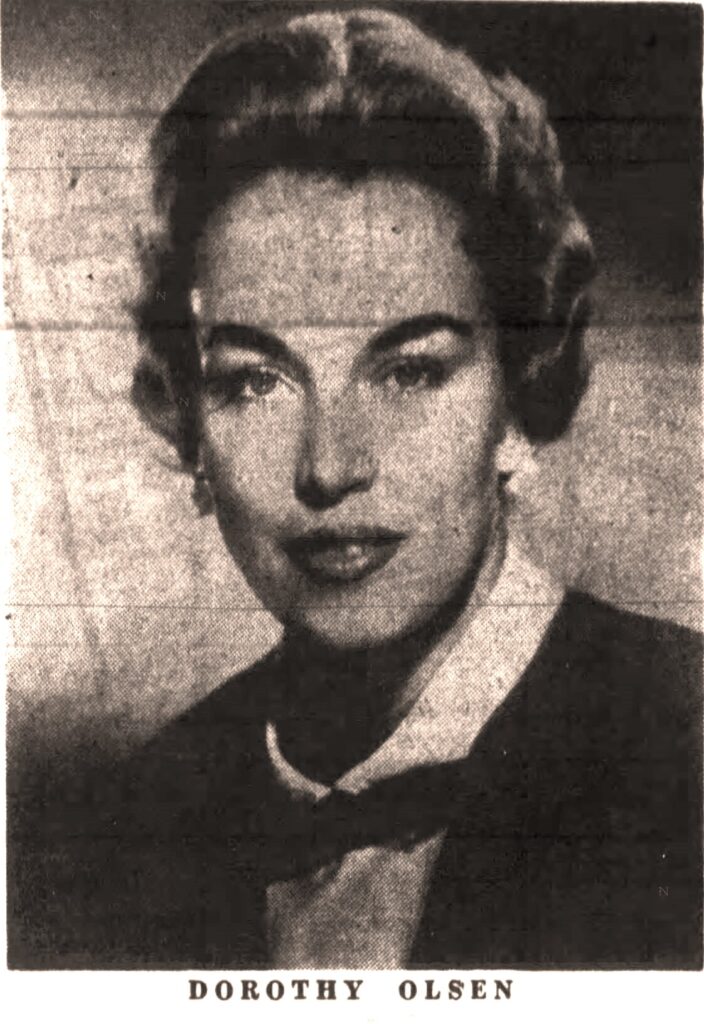
The Telethon has raised over $30 million in the last 67 years. In 1984 the Telethon was moved to the Executive Inn Showroom in Paducah, Kentucky. In 2024, the 68th annual WPSD-TV Lion’s Club Telethon of Stars continues to raise funds.
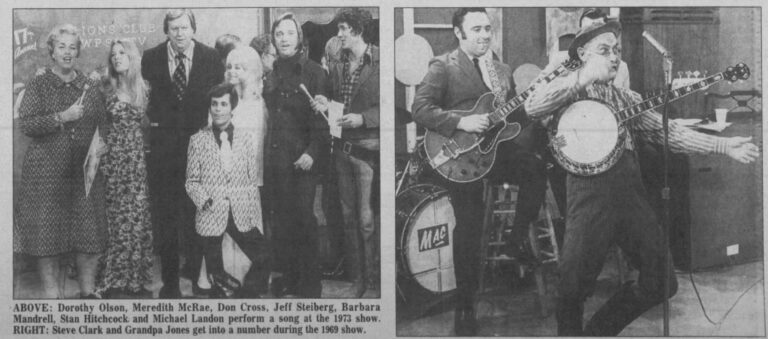
The Pelican Restaurant
October 25, 2024
By Lola Guess
In 1956, Dwight Eisenhower was President and Elvis Presley recorded “Blue Suede Shoes.” At home in Livingston County, the Pelican Restaurant in Lake City, Kentucky, opened its doors for business for the first time. There was always something that set the Pelican apart from other restaurants. The locals came to the Pelican for good food and conversation. Kentucky Lake catfish, hamburgers, daily specials, and of course the breakfast menu were included in the favorites.
The Pelican was open 24 hours a day. Fishermen, tourists, boaters, and shift workers from the quarries, and the chemical plants at Calvert City showed up at all hours, The Pelican hosted weddings, parties, and meetings throughout the years. You could always depend on a tasty meal and top-notch hospitality for any event at any time of night or day.
In 2006, the restaurant was featured in a book by Gary West entitled “Eating Your Way Across Kentucky, 101 Must Places to Eat.” The book featured out-of-the-way places where the locals eat. That was an impressive endorsement considering the number of restaurants across Kentucky.
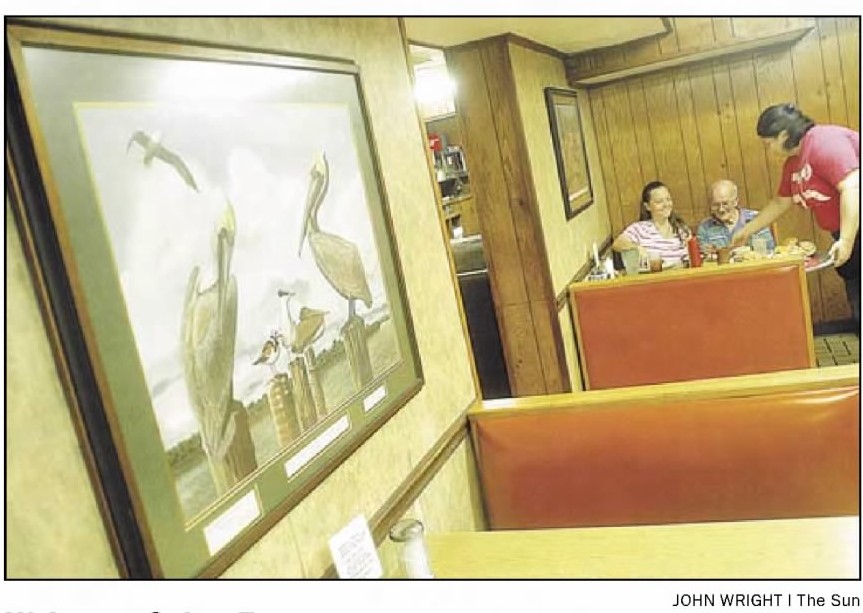
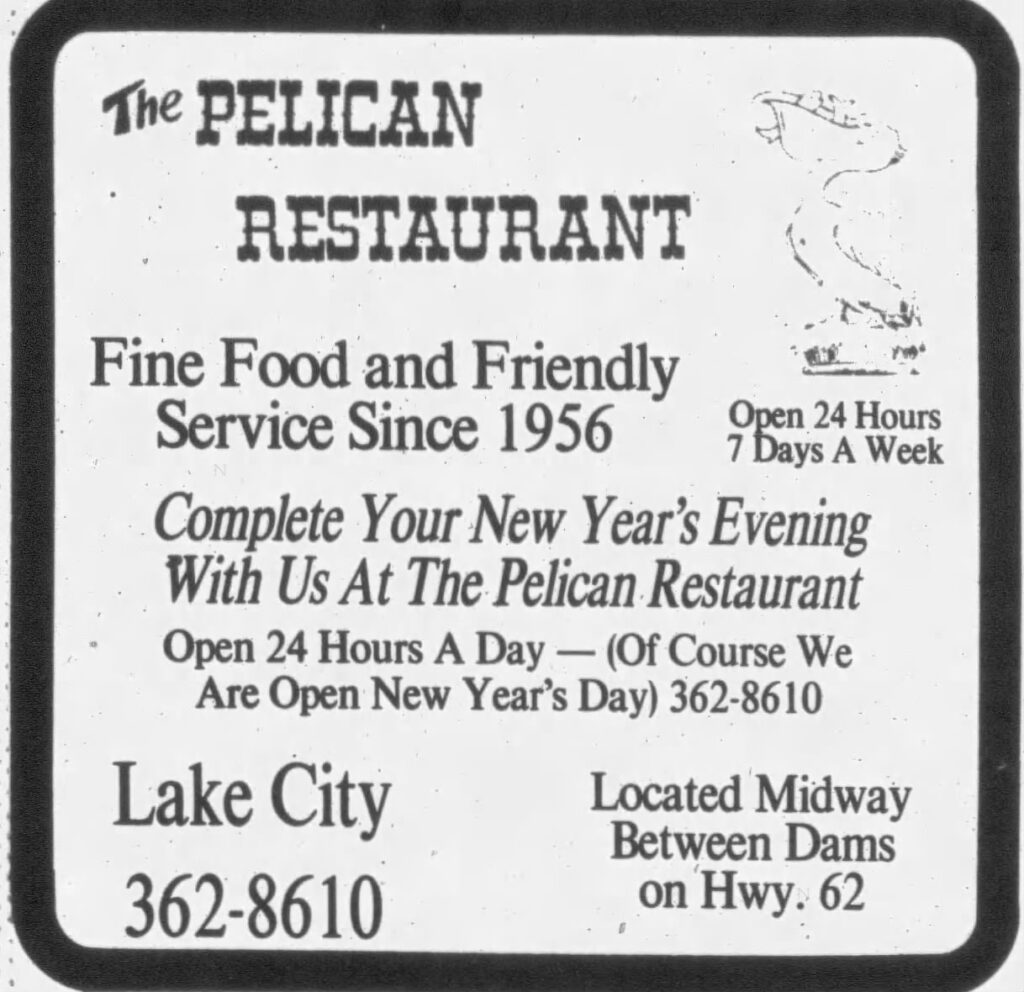
December 1986
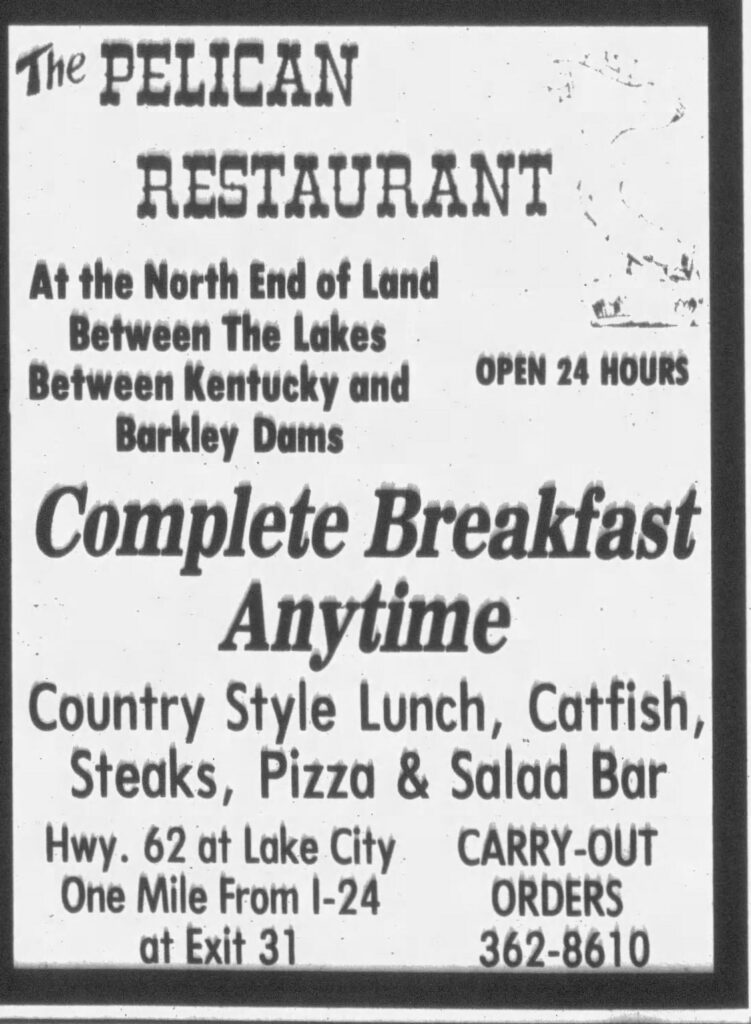
March 1987
In the early 2000s, despite the reputation for good food, friendly atmosphere, and around-the-clock service, the number of the diner’s customers began to dwindle. The last hot meals were served on Saturday, June 7, 2008. The Pelican closed its doors. It was a heartbreaking decision for some of the employees who had worked there for close to thirty years. Managers and owners attributed the closing to high food prices, high gas prices, and the decline in the number of people eating out. Others speculated that the I-24 Highway caused people to bypass Lake City and when Cracker Barrel was built in Calvert City, it pulled tourists away from the Pelican.
Livingston Countians have fond memories of the Pelican Restaurant. A big platter of homemade chicken and dressing, with gravy and mashed potatoes is one of those memories.
Calamities at Iuka Ferry
By Lola Guess
October 18, 2024
Shelly Dycus and Jack Burton operated the Iuka Ferry which is believed to have been opened in 1912 or earlier. The ferry was owned by W. A. Duke who owned the land on the Livingston County side, and Charley Baldwin who owned the land on the Lyon County side. The ferry could transport only two cars at a time because the oars were in the middle of the boat between the cars. The story goes that after a few years, Mr. Dycus wanted to move his family to Grand Rivers. He loaded all the household belongings, hogs, cattle, chickens, and two horses on the ferry boat and headed to Dave Black Landing on the Lyon County side of the Cumberland River. A rainstorm came up as soon as they arrived at the other side. The hogs ran away, and the family lost most of their household belongings.
In July 1934, Mrs. Laney Yates of Kuttawa drowned when she lost control of her car and drove through the chains across the end of the ferry. She could not escape and was still in the car when it was pulled from the river. The car had plunged into about twenty feet of water. Mrs. Yates’ daughter-in-law, Mrs. Broad Rice, was also in the car and managed to escape through a window and was rescued by ferrymen. The women were returning from a shopping trip in Paducah. As a result of the drowning, a lawsuit was filed by George Yates on behalf of his wife, Fanny Yates, in Lyon County in March of 1935 against the Iuka Ferry Company.
In November of 1948, the ferry sank with a truckload of coal. The operators of the ferry and the truck driver jumped off as the ferry went down. The truck was recovered, but the ferry was out of operation for several days.
In August of 1949, the ferry sank when 40,000 pounds of frozen fish valued at $10,000 was driven onto the ferry. The cargo was saved by the refrigerated trailer, and no one was injured. The ferry was out of service for approximately ten days.
In January 1950, high water caused problems for the Iuka Ferry. The ferry boat had motor trouble during the high water and three carloads of people were stranded on the boat for seven and a half hours. The ferry had drifted a long distance before a mechanic from Kuttawa arrived to do repairs.
In August 1950, Mrs. Lewis Wilson’s car plunged off the ferry into the Cumberland River into 15 to 20 feet of water. She drove onto the ferry and was unable to stop her car. Mrs. Wilson ran into the guard rail and the car broke a chain and plunged into the river. She could not open the car door and escaped through a front window. According to a story by Les McDonald in “Echoes of Yesteryear,” the ferry operators managed to save her because her bloomers were full of air, and that held her up until they could get her out. Mrs. Wilson was the wife of the cashier at the Bank of Smithland.
In the 1950s, Tiline bank robbers chose the ferry as their escape route. Percy Stinnett, chief boatswain mate on the ferry, was unaware the men were bank robbers. In the same year, the Fredonia Bank was robbed and Percy Stinnet testified again that he had ferried the robbers across the river the morning before the robbery.
The ferry was often closed during its operation either from high or low water. Despite all of this, the ferry stayed in operation until about 1952. The era of the Iuka Ferry ended after the Kentucky Dam was built. The little Eddyville Highway and the ferry were no longer feasible when the highway was built across the Kentucky Dam. The new road provided a direct route from Paducah to Eddyville without all the twists and turns. That’s progress. It is sad though when a way of life such as the ferries disappear.
Florence Edmonds
October 11, 2024
By Mary Lou Smith
Florence Edmonds was born to Charles Edmonds and Mary Catherine Henry Edmonds, on September 30, 1892, in Livingston County.
Florence attended school in Livingston County. She and Robert Litton (Lytton) sat together and talked about wanting to be schoolteachers, but Robert’s father died and Robert had to help make a living for his family. Florence’s father died when she was three years old, but she managed to attend school and graduated from Western Kentucky University and the University of Chicago.
She taught at Yellowbird or Point School in Livingston County, Paducah Tilghman High School in McCracken County, and later returned and taught for a while at Livingston Central High School. She taught for fifty years in Kentucky and Illinois.
Florence was a Kentucky Colonel and a member of the Methodist Church. She was a former member of the Purchase Area Crime Council and at one time served as a probation officer.
Florence never married. She had a close friend, Carl David Bennett who was killed by lightning, on June 17, 1919.
Florence died June 17, 1979. Both are buried in Smithland Cemetery. She is survived by one sister, Eloise Alex.
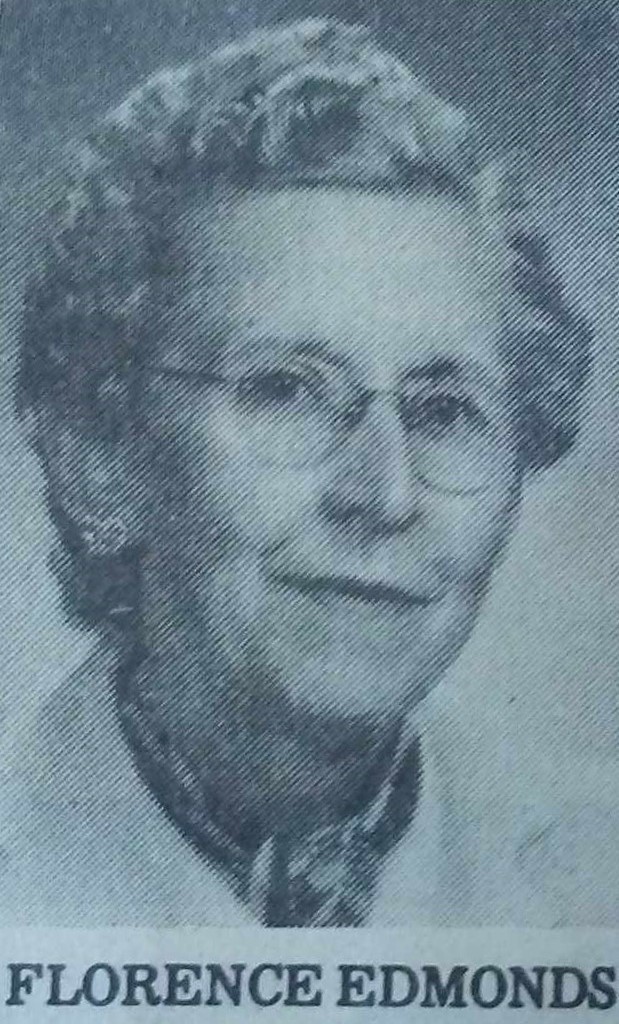
Gum Springs Barbeque
October 4, 2024
By Lola Guess
Gum Springs Barbeque was owned and operated by Clyde R. McDonald from approximately 1962 until sometime in the 1980s. Clyde was also known as “Pink” McDonald, although no one knows how he got that name. The restaurant, better known as “Pink’s Bar-B-Q,” was on Highway 453 next to Gum Springs and across from Friendship Baptist Church. As the signs show, Pink’s barbeque was the main feature either by the sandwich or pound. The menu included hamburgers, cheeseburgers, hot dogs, ice cream, drinks, candy, and chips. Pink cooked the meat in a pit beside the restaurant and created his special “secret recipe” barbeque sauce. The gas pumps were topped with a large sign stating that Standard Oil Products were sold there.
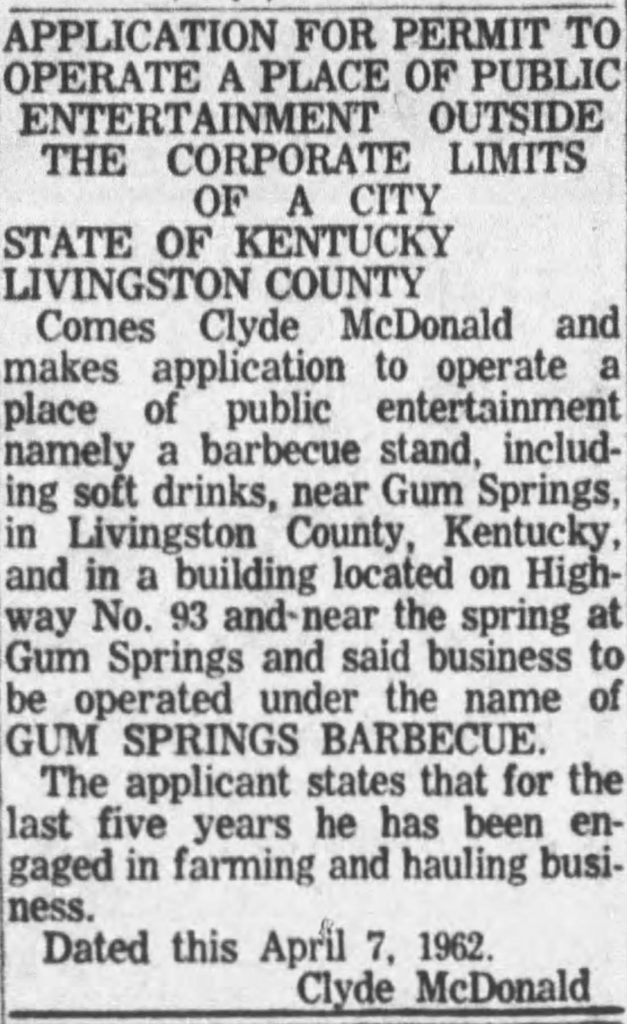
Paducah Sun newspaper article dated April 14, 1962.
Pink's Bar--B-Que
By the Sandwich or the Pound.

Clyde was born August 23, 1913, in Tiline, KY. He was the son of James F. and Eula (Charles) McDonald. He first married Opal J. Talley who died in 1939. He later married Carlene Burd.
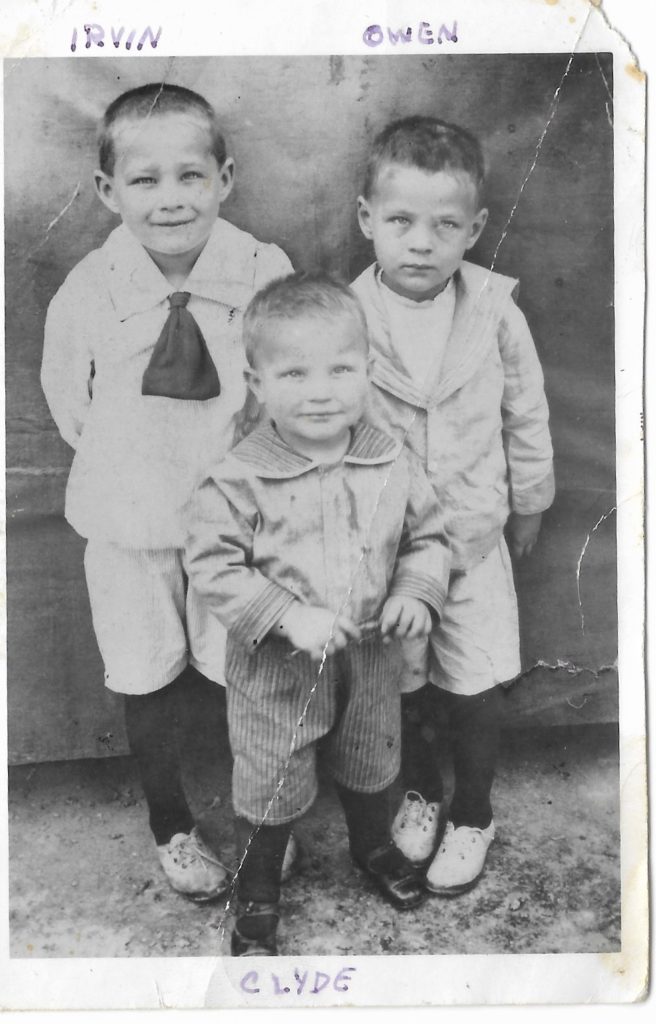
Irvin, Owen and Clyde McDonald
Pink’s hobby was coon hunting. He enjoyed waiting on customers in the restaurant and talking about last night’s hunt. They discussed whose dog treed first, how many coons were in the tree, and the next breed of coon dog they were planning to buy. They planned the next hunt, ate barbeque sandwiches, and carried on a “lively” conversation.
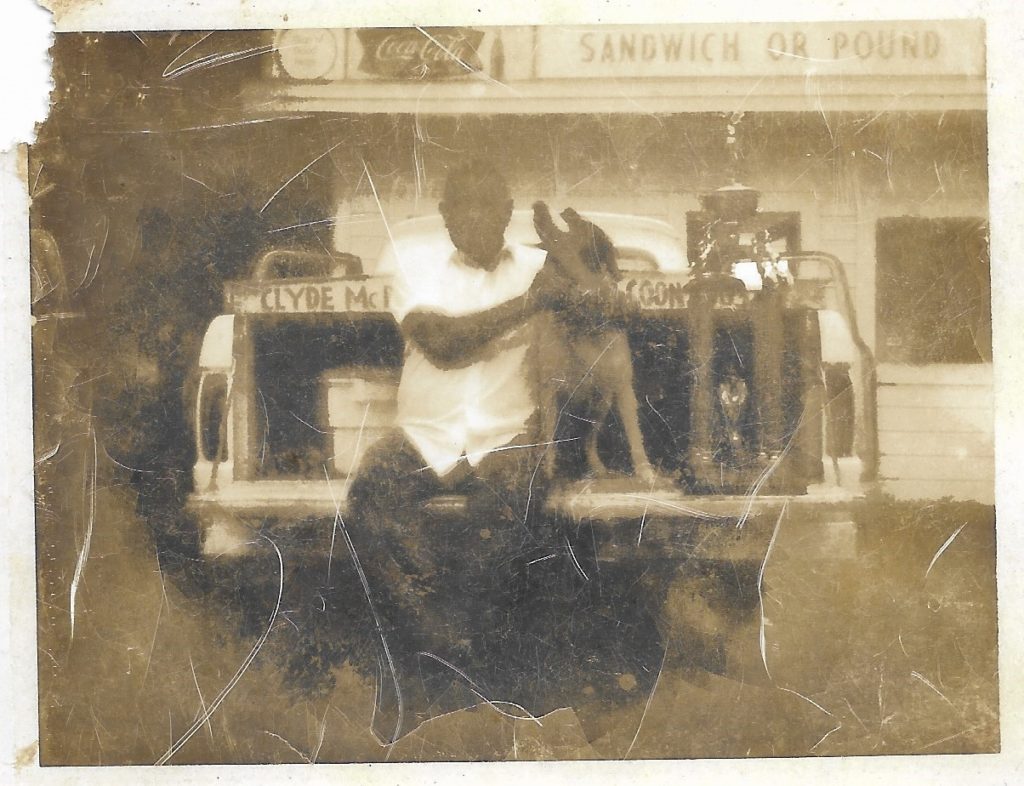
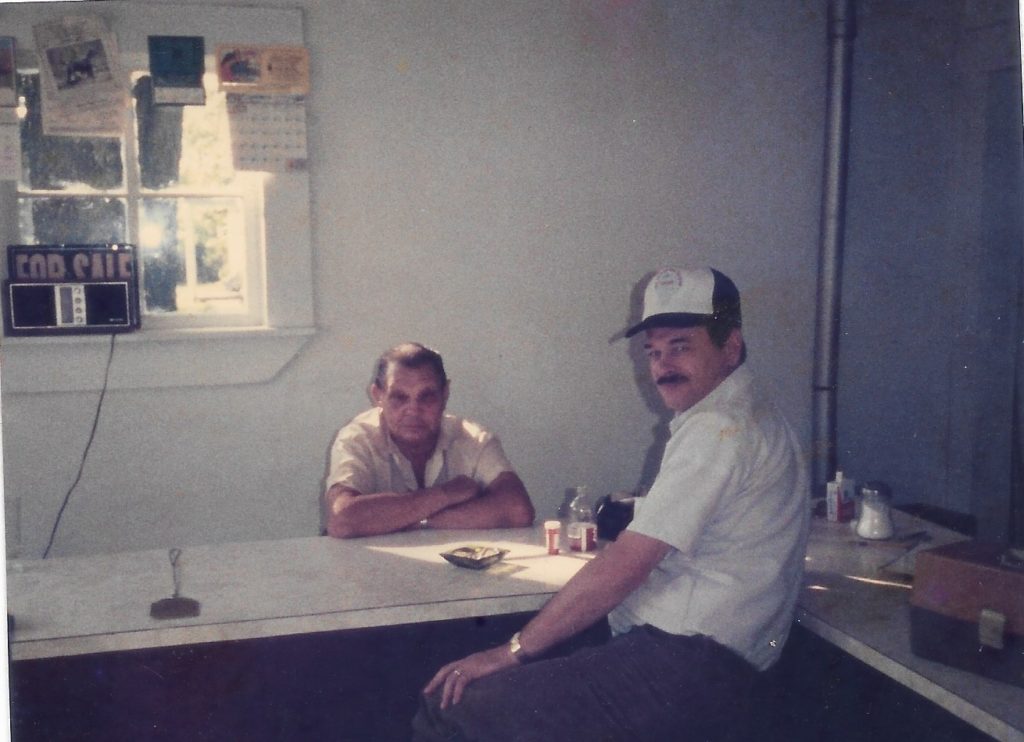
Since he lived next to Gum Springs, McDonald also ran another business named “Clyde McDonald Water Hauling.” Gum Springs is a limestone spring that flows year-round providing an unlimited supply of clean drinking water.
The legacy lives on in Clyde’s great-grandson, Chase Lant, who enjoys barbequing and experimenting with recipes handed down through the family. Clyde McDonald died on February 2, 1988, at the age of seventy-four at Western Baptist Hospital in Paducah. He is buried in Leeper Cemetery, Tiline, Kentucky.

Marquis de Lafayette
September 27, 2024
By Lola Guess (MHS Revolutionary War Era Article)
Born into a noble French family, Gilbert du Motier, Marquis de Lafayette, began his military career in 1771. Upon hearing reports of the rebellious Americans, he bought a ship and sailed for America. After he arrived in America in 1777, he soon earned an honorary commission as a major general in the Continental Army. He was devoted to General Washington who became his mentor and father figure. Lafayette’s courage on the battlefield and his successful pleas to France for material aid for the Americans established him as a hero. The fact that he left home to risk his life in a country not his own (and at his own expense) for the cause of liberty captured the imagination and admiration of Americans.
Received as a hero in his homeland upon his return, Lafayette played an important role in the political changes taking place in France. Appointed head of the Parisian Garde Nationale in 1789 after the storming of the Bastille, he ordered the prison leveled, and a few months later, sent the key to the Bastille to America as a tribute to Washington, his mentor, and the man he considered the father of liberty. Lafayette tried to steer a middle course through the French Revolution but was arrested and imprisoned for five years. He was released in 1797 and refused to work in Napoleon’s government. In 1814, he became a member of the Parliament of France. Lafayette died in 1834 and is buried in Paris under soil gathered from Bunker Hill.
Lafayette was invited to the United States as “The Nation’s Guest” and between August 1824 and September 1825, he toured all twenty-four states. Lafayette visited Smithland on May 6, 1825. The Historical Marker by the Gower House lists him as a guest. Beginning at 2:30 p.m. on October 6, 2024, the Lafayette Trail Historical Marker on the riverfront in Smithland, Kentucky, will be unveiled and dedicated. The program of events will be posted.
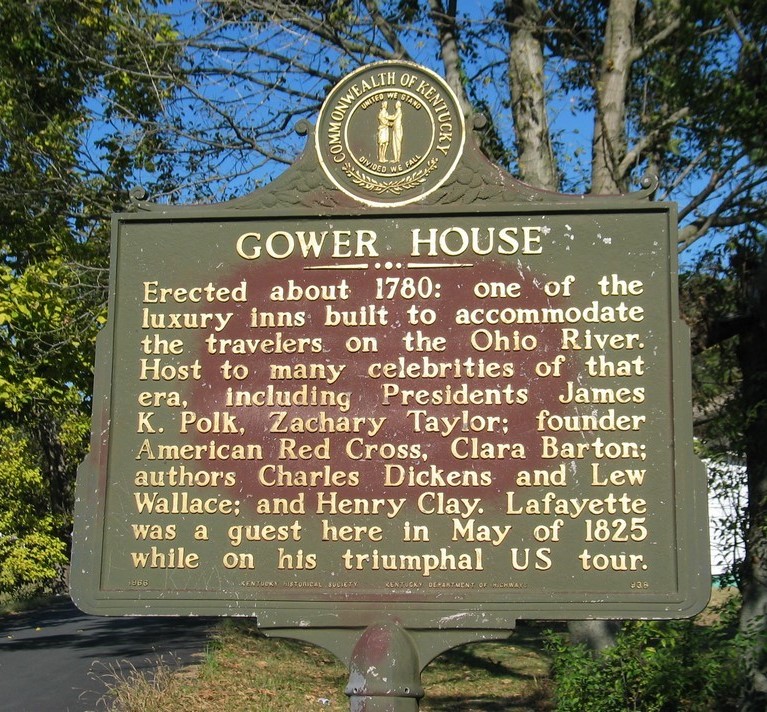

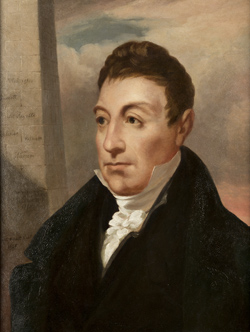
This portrait depicts Marie-Joseph Paul Yves Roch Gilbert du Motier, Marquis de Lafayette (1757-1834). It was created by Henry Cheever Pratt (1803-1880). It is dated at the time of laying the cornerstone of the Bunker Hill Monument in Boston, Massachusetts, in 1825.

The historic Smithland Riverfront where Lafayette visited on his visit in 1825.
Lick Skillet School
September 13, 2024
By Lola Guess
The Lick Skillet School was built about three miles northwest of Salem in the late nineteenth century on the Lick Skillet Road off Highway 133 or Lola Road. The elementary school was built on land acquired from the Barnett family (may have been Sam Barnett) and was originally named the Barnett School.
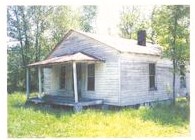
There are three versions of how the school became known as Lick Skillet. As school officials and parents searched for land to build the school, they stopped at a nearby house. A small child appeared in the doorway licking a skillet. His mother had made a batch of sorghum molasses candy, and the child enjoyed “cleaning up” the skillet. This version is a popular story and has been handed down through generations.
The second account is that visitors came to the neighborhood, ate a good lunch, and told others they were so hungry that they ate everything on the table and then licked the skillet. This narrative has been retold for years as well.
The third story is about a family of poor people who lived near the school. After the family had eaten all their food, they licked the skillet.
The school was consolidated with the Salem school in 1940-41. In the 1950s, the building was moved and converted into a residence. The building remained vacant in later years and eventually burned.
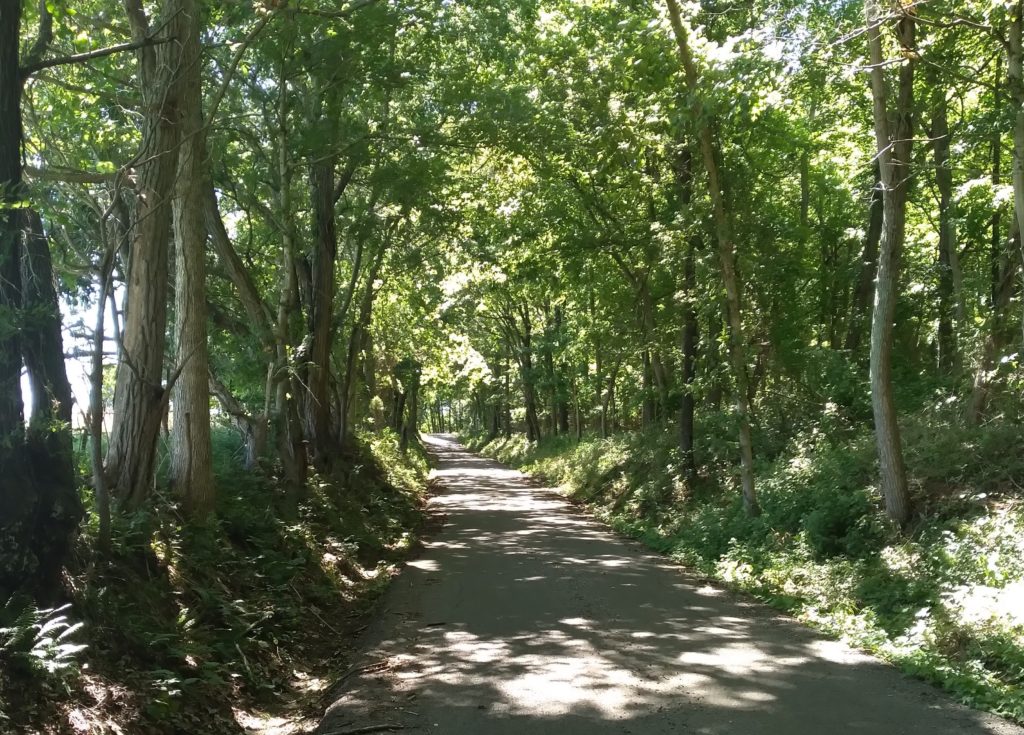
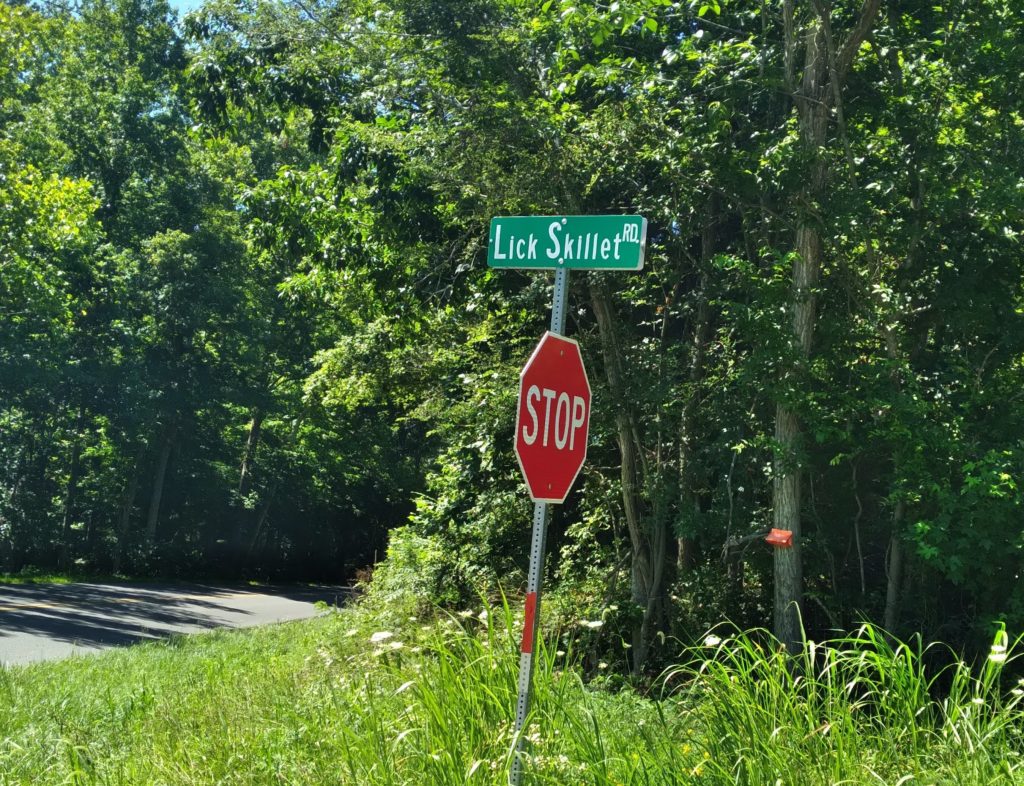
Estle & Lee Roy Crawford
Estle and Lee Roy Crawford
By Mary Lou Smith
September 6, 2024
Brothers, Estle and Lee Roy Crawford were killed instantly by lightning on July 18. 1917. They lived off the Cutoff Road below Smithland. Their parents were Samuel and Dulcina Crawford.
Roy was single and twenty-five years old. Estle was thirty-two years old and married to Ora Farmer on January 12, 1905. At the time of Estle’s death the family had already suffered the loss of two small children.
The brothers were members of the Woodmen of the World. They have large monuments that were erected by the Woodmen of the World at the Robertson Cemetery.
Well-known, Miss Maggie Crawford of Smithland was a sister to the brothers. Forty-seven years after their deaths, Estle’s wife, Ora Crawford, was buried beside him.
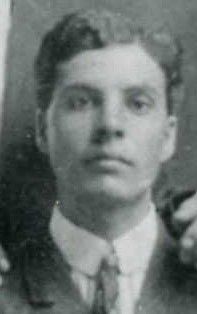
Estle Crawford

Lee Roy Crawford Monument at Robertson Cemetery
Mrs. Ora Crawford Dies – Rites Set
Mrs. Ora Crawford, 82 died at 6:15 p.m. at Rudolph Rest Home. She is survived by four daughters, Mrs. Clarice Buford, and Mrs. Lila Orr, both of Paducah, Mrs. Aline Poe of Hazel Park, Michigan, and Mrs. Willis Stroud of Reidland: 12 grandchildren and 21 great-grandchildren. Funeral services will be held at 2:00 p.m. at Kennedy Funeral Home with the Rev. John Stavely officiating. Burial will be in Robertson Cemetery in Livingston County. Grandsons will serve as pallbearers. (Tuesday, August 19, 1964)
Salem Movie Theater
By Lola Guess
August 23, 2024
In January in 1947, the Warner Movie Theater in Salem, Kentucky, provided residents with the opportunity to watch the newest movies featuring famous stars including Roy Rogers and Dale Evans, Ava Gardner, the Three Stooges, and everyone’s favorite, Bugs Bunny.
The theater was one of the best equipped facilities in Western Kentucky. The building was thirty-two by eighty-two feet located in downtown Salem on Highway 60. It was built by Linville Conyer at a cost of $40,000.00. The lobby contained a ticket booth, a business office, a refrigerated water fountain, restrooms, and a popcorn booth with an electric popcorn popper. There was a balcony which also housed the projection room. The auditorium had a seating capacity of three hundred and the balcony could accommodate up to fifty. The furnace room contained a stoker furnace and boiler which also furnished steam heat to the Salem Bank.
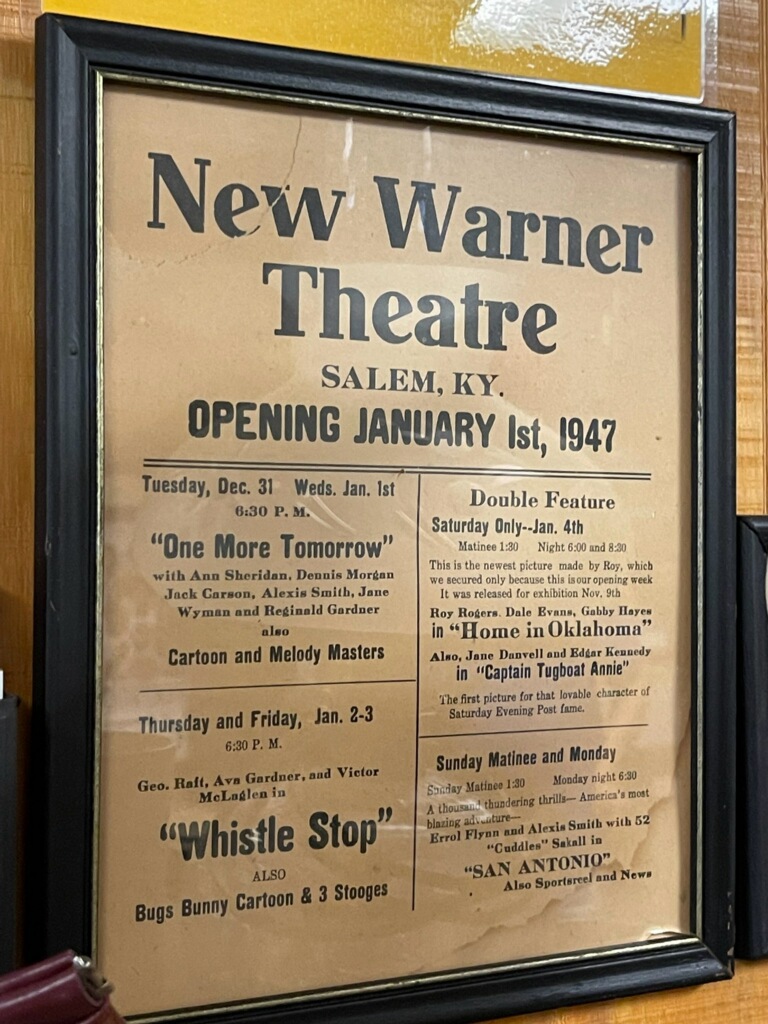
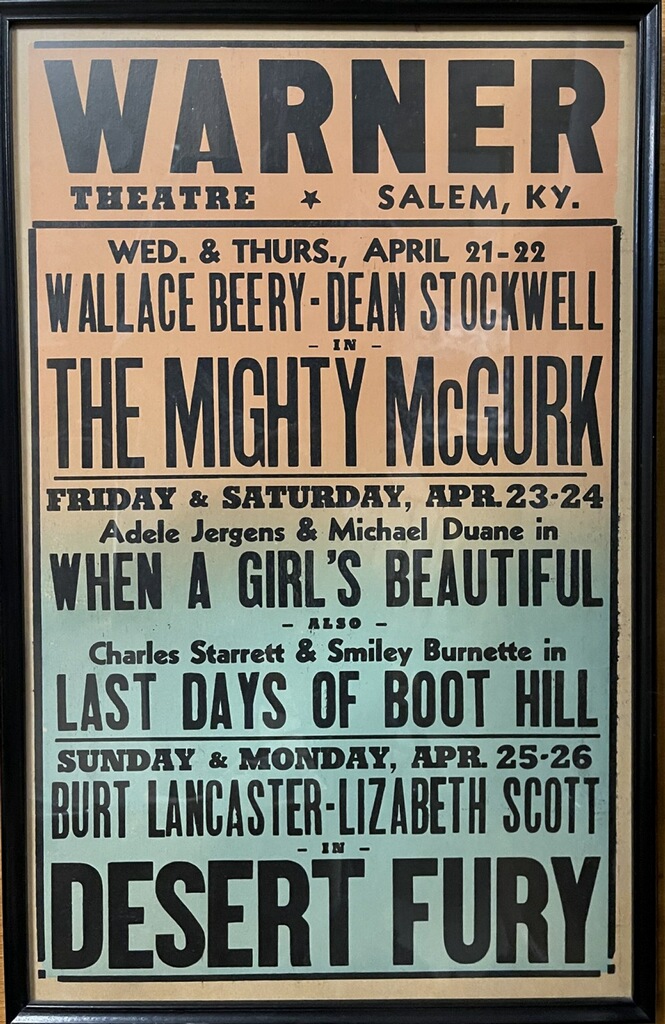
Mr. Conyer made sure the theater was comfortable by installing carpeting, red leather seats, and red velvet drapes. The latest sound system was installed with microphones in the stage area as well as in the projection room for announcements.
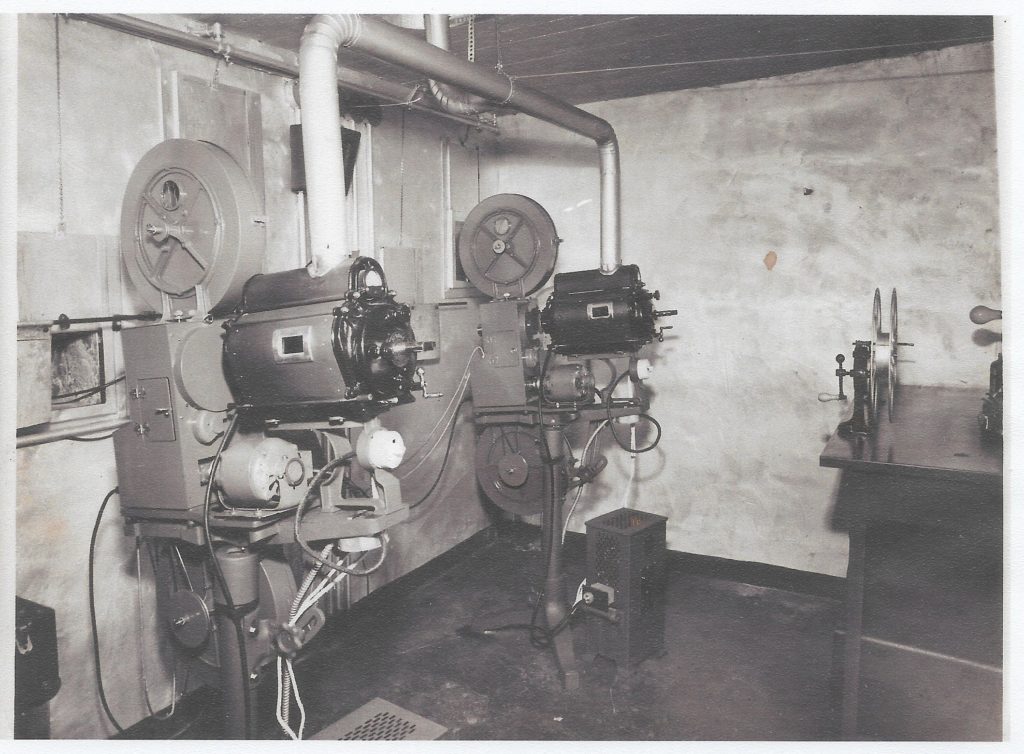
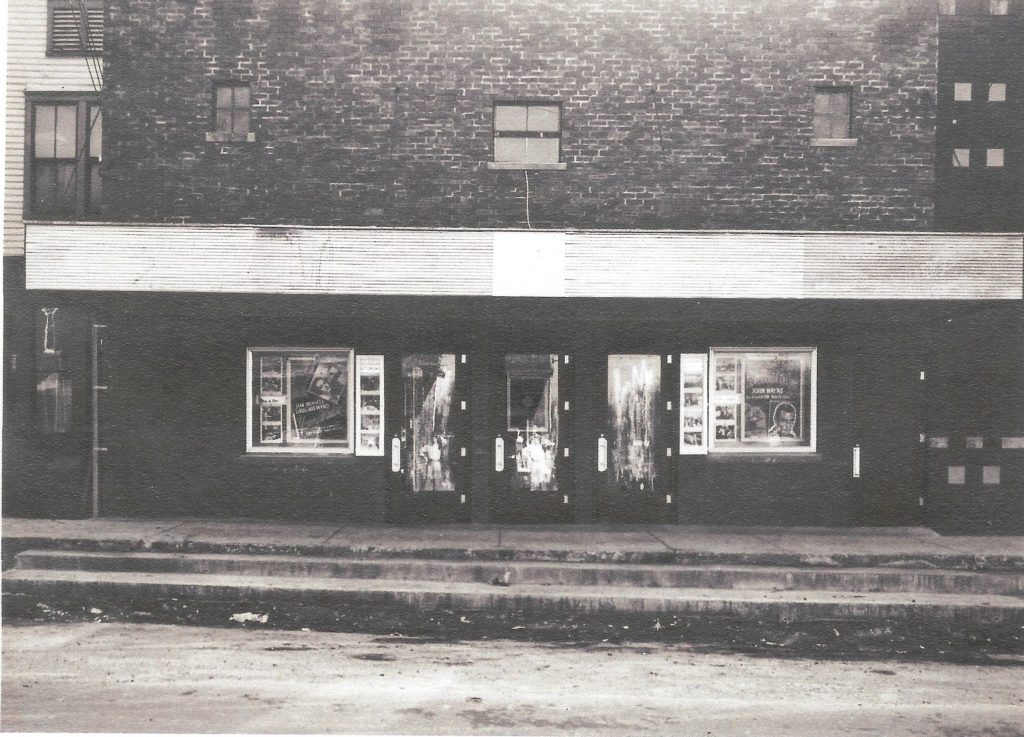
Outside of Building
Linville Conyer was born on January 28, 1903, and died at Salem Hospital on February 8, 1962, at the age of 59. He is buried in Salem Cemetery along with his wife, Rosa Nelle Conyer.

Three Mitchell Sisters
By Mary Lou Smith
August 15, 2024
There were three sisters who were born and lived in the Dyer Hill area. Catherine Angeline (Lina – January 12, 1877 – ?), Lyttle Amy (1887 – 1973), Ethel (June 27, 1881 – 1958), daughters of Martha Edwards and LaFayte Mitchell. They were well thought of in their time.
Angeline married C. H. Lloyd (Uncle Bud). They had three sons, Creed, Newman, and Freeman. Lyttle Amy married George Levan. They adopted a son, William Harlan. Ethel married William B. Jameson. They had Ralph, Jimmy, Wilford, Edward, Christine, Ruby, and Edna.
The sisters, their husbands, and most of their children are buried at Dyer Hill Cemetery.
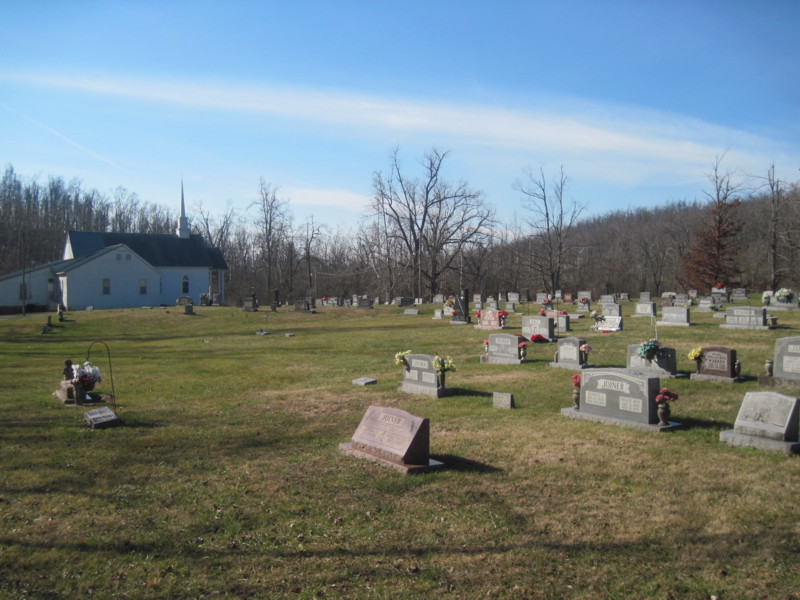
Dyer Hill Cemetery - Burna, Kentucky
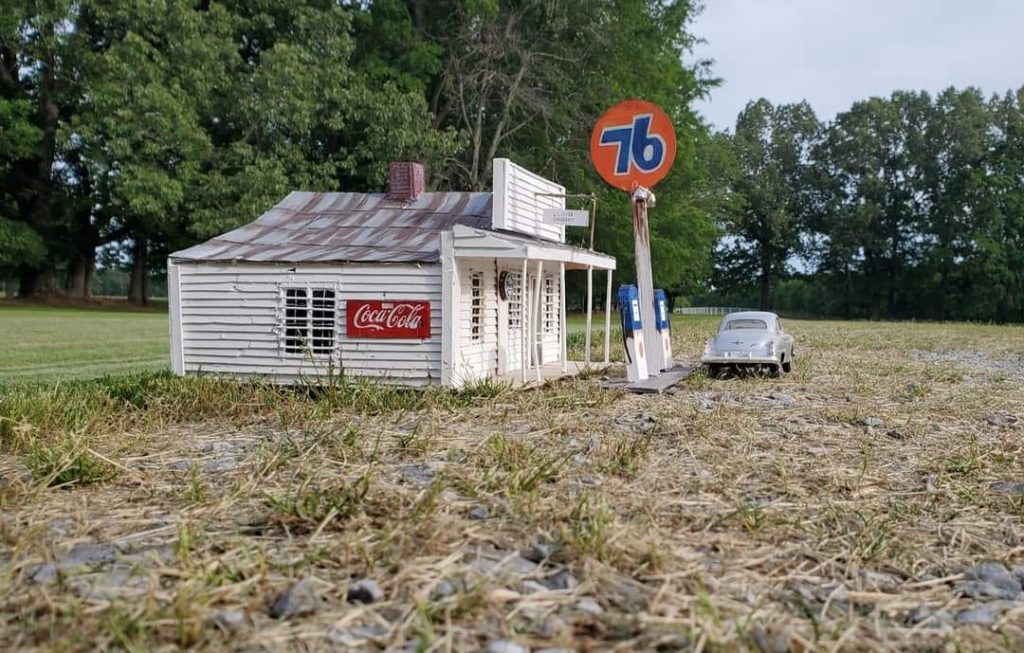
Uncle Bud's Store
This is a miniature of Uncle Bud’s Store made by Artist Mark Trail. The replica is on display at the Courthouse Museum in Smithland.
Jackson Henson
August 9, 2024
Thank you letter from Jackson Henson, recipient of the Acoam Carroll Scholarship Award for 2024.
My name is Jackson Henson. I am so thankful for the Scholarship that the Historical Society is giving to me. This will be such a wonderful help in my process of continuing education.
I will be attending Union University in the Fall to begin my bachelor’s degree in Greek and Hebrew with a focus in Biblical Translation and Theology. Union is a Baptist University with a wonderful track record of Biblical authenticity. In addition, Union is also a very rigorous school that requires its students to dig deep into their gifting and work hard to hone those gifts during their time at the University.
I have not yet chosen a minor, but I anticipate that it will be in either business or history.
This Scholarship along with several others will help my family and I handle the nearly $60,000 per year education.
Eventually, I believe that I will be a pastor helping lead the people of a strong church to positively influence a community very similar to Smithland. I may even have the opportunity to come back to Western Kentucky at some point. I know I certainly hope that I will.
Please express my appreciation to anyone involved in this decision and provision.
My appreciation, Jackson Henson.
Jackson Henson
Livingston Central High School Graduating Class of 2024
Jackson Henson and his mother, Stephanie Henson
The Poor House or Almshouse
Researched and written by Mary Lou Smith
August 2, 2024
The Livingston County Court, on October 3, 1865, met and ordered J. I Handlin, J. H. Davis and C. G. Halstead be and hereby appointed Commissioners with instructions and authority to purchase a tract of land not more than six miles from Smithland for the purpose of establishing a home for the poor, that they be authorized to erect buildings and prepare the same for the reception of the poor by the next court of claims and that they be authorized to pledge the credit of the county for the same. (Order M-313)
October 25, 1866, John Cochran, and wife Nancy sold to the Livingston County Court for the use of a poor house and for $2,700.00 and being 135 acres.
F.M. Fletcher may have been the first Supt. for the poor house, as allowed by committee by the court amounting to $234.35 on November 4, 1867.
November 4, 1867, the court ordered that R. W. Coleman be allowed the sum of $34.75 for hauling rails for the poor house.
It was ordered that D. H. Hurley, W. H. Mitchell, and S. C. Jones be allowed one dollar each for their services as Poor House Commissioners to be paid out of County levy. (Nov. 4, 1867)
November 4, 1868, F. M. Fletcher was paid $177.40 for keeping the poor house.
To be a manager, one put in a bid to the court and they were made manager for four years. Some did not stay four years for different reasons.
Thoms Leeper was manager of the poor house in 1870. He was 44 years old and had a wife Margaret and three children of his own, and ten paupers living there. Prior to keeping the poor house, Leeper was jailor at the county jail. (1870 Livingston County Census)
Some of the managers were as follows: Oct. 1, 1877, M. M. (Madison) Hill was allowed $262.25 for keeping the poor house for one year.
M.M. Hill was keeper of the poor house and had five paupers living there in the 1880 Census.
October, 1883, J. W. Durham was allowed by court to be the keeper until October, 1884. He agreed to be paid $84.00 per person, per year. After 1884, he was allowed two more years and at $84.00 per person, per year.
It was ordered by the court that J. W. Durham be and is hereby allowed $12.00 for lumber and hearths for poor house. The court also ordered that J. W. Durham be allowed $12.00 for building a chimney to the poor house in 1895. (Order R-350)
It is not known when George Jarrett started as keeper, but he was there in the 1900 census, with his large family and twelve paupers. Jarrett’s daughter, Bettie married George Lytton, and their first baby, Heater was born while living with her parents, August 8, 1903. The Lytton family had memories of a Black man who lived there. This was probably Brock Landrum, as he was in the 1910 census with Gilmore Durham, who was the keeper then and his family and “inmates as they were sometimes called.” One was a man, LeRoy Amick. He died in 1911 and is buried at the Ross Cemetery.
W. H. Durham was the keeper in the 1920 census, along with his wife, Pearl, the family and four paupers. Brock Landrum was still living at that time.
On Oct. 13, 1924, the court met pursuant to adjustment, present Honorable J. M. Montgomery, Judge. Upon a motion, it is now ordered that Brantley Rudd be allowed to keep poor pauper county levy for the year 1924. September 13, to October 10, 1924, the sum of $72.00 payable.
On August 10, 1925, on motion by the court it is ordered that Brantley Rudd be allowed $96.00.
The Livingston County Court sold the farm at Vicksburg to J. D. Conn for $1,300.00 on December 1, 1926. (Deed Book 51-295) Brantley Rudd was thought to be caring for the poor farm when the county sold it.
There has been a total of six generations of the Conn family living on the farm since 1926. J. D. raised his family there. Then his son, Bill, and his family of four children lived there until the house was worn out from age. The house had a “dog trot” which today may have been called a “breezeway.” It was made of logs and in later years had some kind of siding. Bill Sr. destroyed the house about 1957, all except the large chimney. Bill Jr. moved to the farm in the 1980’s. His daughter Jennifer Conn Smith, and husband Kenton, built a house where the poor house once was. The old chimney stood there until the new home was built.
On a hill behind the Smith’s house is a cemetery for the poor and homeless.
In the 1930 census, Ellison T. Ledbetter was keeper of a poor house. No document was found as to where this was located.
Glendon Nelson Harvey
By Mary Lou Smith
July 26, 2024
Glendon Nelson Harvey was born to Cecil and Ethel Nelson Harvey (1939-1968). Glendon had an older brother, Cecil Wayne (1934-2018).
Glendon was fun to be with. He had a lot of friends throughout his life, as he went to school in Smithland. He graduated from the new and the first graduating class at Burna High School in 1958. At class night, he acted as Elvis Presley with his guitar. The auditorium was in a roar.
He soon started dating Phyllis Jean Lytton and they were married in September 1959. They lived in St. Louis, Missouri, and worked at McDonald’s Aircraft. He went into the Armed Forces in 1961 and came home in 1963.
He went to work at Paducah at Modine Manufacturing.
On Memorial Day in 1968, as he was coming from Paducah, he was killed instantly in a one-car accident in front of the Ledbetter Livestock Auction Barn.
Burial was in Ferguson Cemetery with the rest of the Harvey’s.
Glendon died without issue and he and Wayne were the last of the Harvey’s to carry on the name. He was loved by many.
Come With me on a Short Visit to Lola, Kentucky
Roger Dale Lynch
July 12, 2024
By Lola Guess
Deputy Roger Dale Lynch was killed when he responded to a domestic dispute on June 2, 2005, in Ledbetter, Kentucky. According to the state police, the 911 call came in at approximately 11:30 p.m. from Candice Calendar who reported that her parents were fighting. Both Deputy Lynch, age 51, and Joseph Calendar, age 48, were shot and killed when the two exchanged gunfire at Calendar’s home.

Deputy Roger Dale Lynch
End of Watch - June 2, 2005
Badge #3
Deputy Lynch had been on the job for five years and was considered a dependable and dedicated deputy. The community was stunned. Roger was from Tiline, Kentucky, and was the son of Thomas and Edith Lynch. He was born on May 30, 1954. Roger married Debbie Grimmitt in 1973 and had two children, David, and Amanda. He was an army veteran serving in the Vietnam War and a member of the American Legion Post 217.
Deputy’s Lynch’s funeral service was held at the Potter House and he was buried at Vicksburg in the Ross Cemetery. Attending the funeral were more than 700 family members, friends, police officers, members of the emergency services, and fire departments from across the state. The Kentucky state police, along with the Louisville Metro Police, Lexington Metro Police, and Jefferson County Sheriff’s department provided honor guards. Firefighters lined the route from the church along Highway 60 and Highway 70 to the burial site. There was a 21-gun salute along with other ceremonial events at the funeral and at the cemetery.
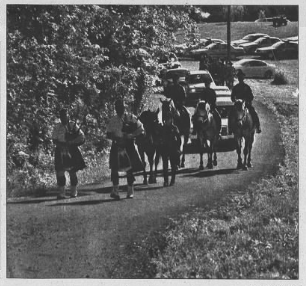
Louisville Metrol Police Honor Guard
A rider-less horse leads the procession on Ross Cemetery Road.
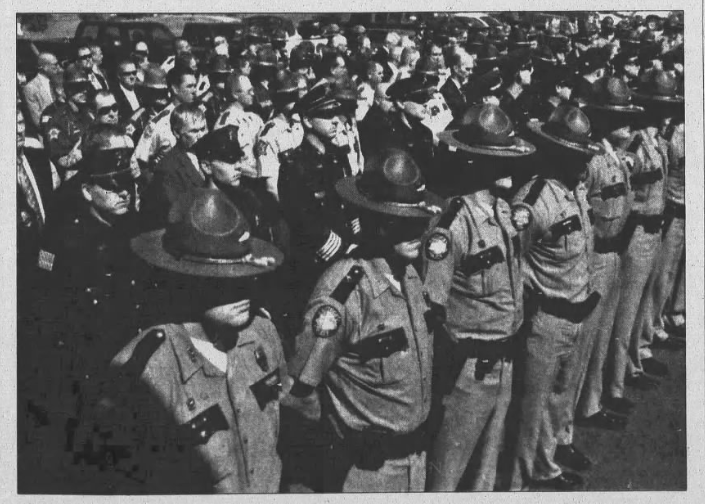
Hundreds of law enforcement officials attended the funeral.
Roger was well-liked in his hometown and was described as a very good man. He had a big smile and was easy to get along with. Sheriff Tommy Williams, Deputy Lynch’s boss described him as having a sense of humor and a willingness to help others. “He was a good old county boy with a heart the size of Texas,” said Williams.
A monument was erected beside the Livingston Couty Courthouse Museum in 2023 honoring those who were slain the line of duty. Deputy Lynch’s name is listed among others who served and gave the ultimate sacrifice.
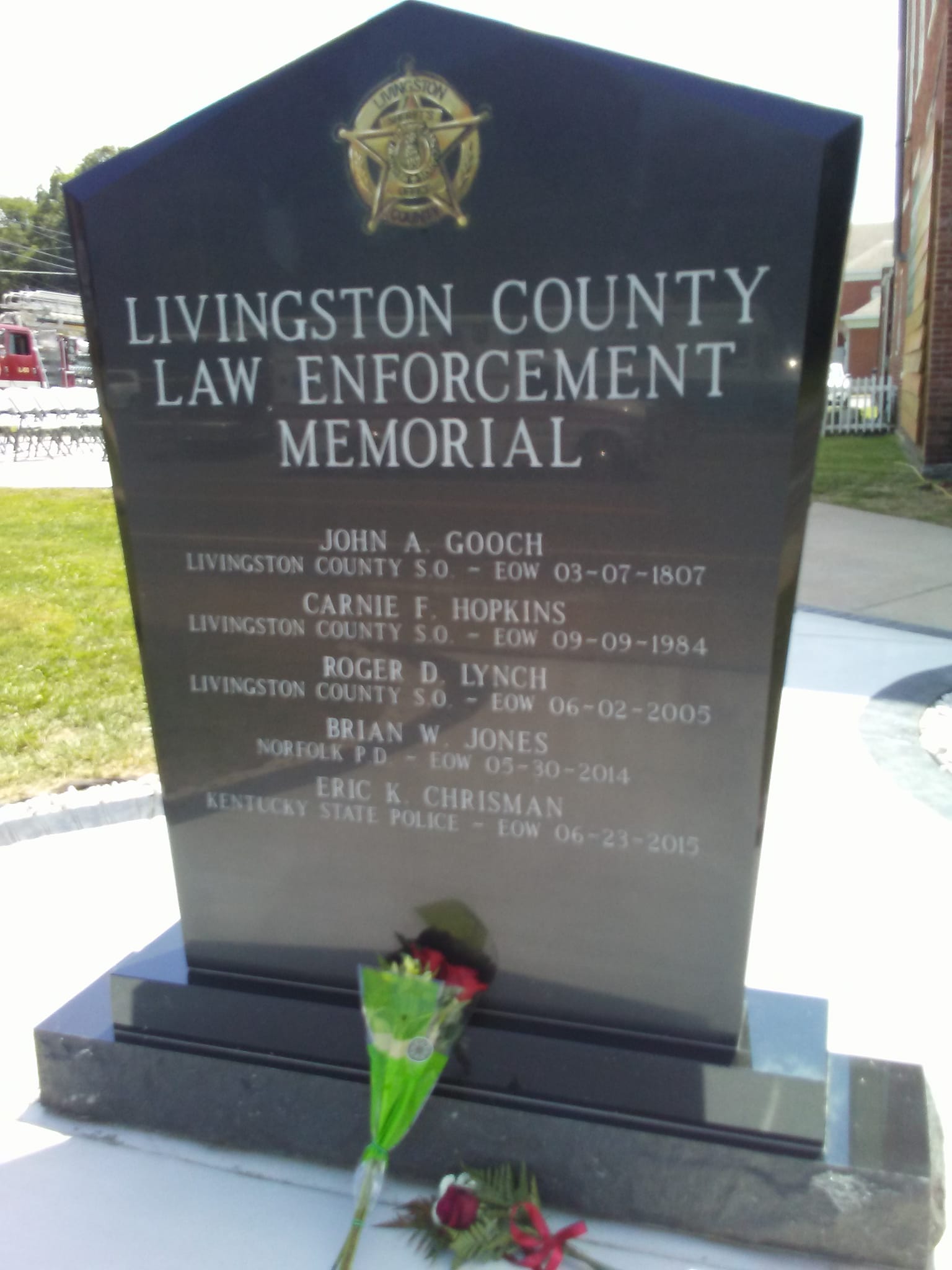
"1974 - Looking Back"
June 28, 2024
By Lola Guess
In 1974, Livingston County held a Bicentennial Celebration from July 4th thru the 7th. This was the same year that President Richard Nixon resigned the presidency. A postage stamp was priced at 10 cents, a loaf of bread cost 28 cents, a gallon of gas sold for 53 cents, and a new car set a person back approximately $3,500.00. “All in the Family” was one of the top TV shows and the famous “Rumble in the Jungle” boxing match between Ali and Foreman was at the top of the sporting events. Wendell Ford was Governor, Julian Carroll was Lieutenant Governor, and Carroll Hubbard was the state representative.
The theme for the County celebration was “Come Home in 1974.” Smithland was the site of the first festivities. A barbeque, bands, street dancing, displays and contests were held on Court Street. The parade in Smithland included floats, old cars, horse-drawn vehicles and paraders in costume. Awards were given for the best costume of the 1700’s and for the best beard. Fines were levied against anyone not in costume with proceeds going to the Livingston Bicentennial Committee. Contests included sack races, tug-of-war, pie eating, pipe smoking, horse racing, greased pig and greased pole contests, and a king and queen was chosen. The evening ended with a fireworks display on the riverfront sponsored by David Hoy.
The next day the celebrations continued with a square dance featuring Stanly Walker at Grand Rivers. A horse show was held with sixteen classes with trophies awarded in each category.
The final event was a joint church service on July 7th at the fair barn. All of the county’s churches were invited to participate with a potluck picnic following the service to end the 175th Anniversary Celebration of Livingston County.
In 2024, fifty years later, we are celebrating the 225th Anniversary of our County. As we continue to move forward, we can be proud of our heritage and continue to work toward a rewarding future.



"Dear Son"
June 21, 2024
From an article in the Livingston Ledger named “Jo’s Jottings”
Dear Son,
I am writing this slow cause I know you can’t read fast. We don’t live where we did when you left. Your dad read in the paper where most accidents happen within twenty miles of home so we moved. I won’t be able to send out the address as the last Kentucky family that lived here took the numbers with them for their next house, so they wouldn’t have to change their address. This place has a washing machine. The first day I put four shirts in it, pulled the chain and I ain’t seem ‘em since. It only rained twice this week, three days the first time and four days the second time. The coat you wanted me to send you, your Aunt Sue said it would be too heavy to send in the mail with them heavy buttons, so we cut them off and put them in the pockets. We got a bill from the funeral home, said if we didn’t make the last payment on grandma’s funeral, up she comes. About your father, he has a lovely new job. He has over 500 men under him. He is cutting grass at the cemetery.

About your sister, she had a baby this morning, I haven’t found out if it is a boy or a girl, so I don’t know if you are an aunt or uncle. Your Uncle John fell in the whiskey vat. Some men tried to pull him out but he fought them off and he burned for three days. Three of your friends went off the bridge in a pickup. One was driving, the other two were in the back. The driver got out. He rolled the window down and swam to safety. The other two drowned. They couldn’t get the tail gate down. Not much news this time, nothing much has happened.
Write more often. Love, Mom
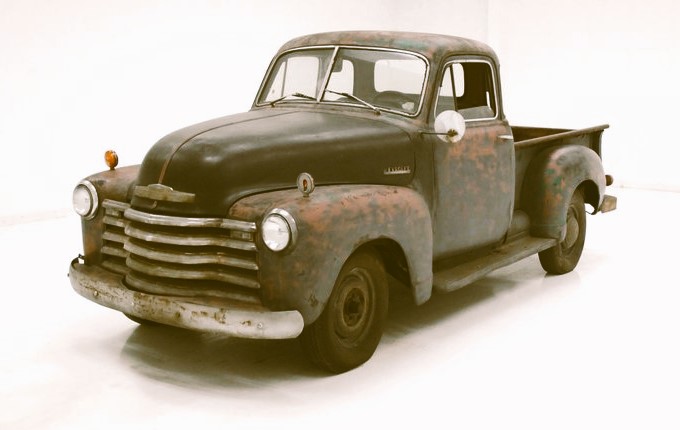
Blanche Brown - Livingston County's Nurse
June 14, 2024
By Lola Guess
Sarah Blanche Lenn was born on December 18, 1895, in Vanderburgh County, Indiana. She graduated from Deaconess Hospital School of Nursing in 1921. She became Blanche Brown in May of 1924 when she married J. Harold Brown in Evansville, Indiana. The Brown’s moved to a farm they had purchased in Bayou in Livingston County in 1944. In July of 1945, Blanche became Livingston County’s first public health nurse. She remained in this position until 1968.
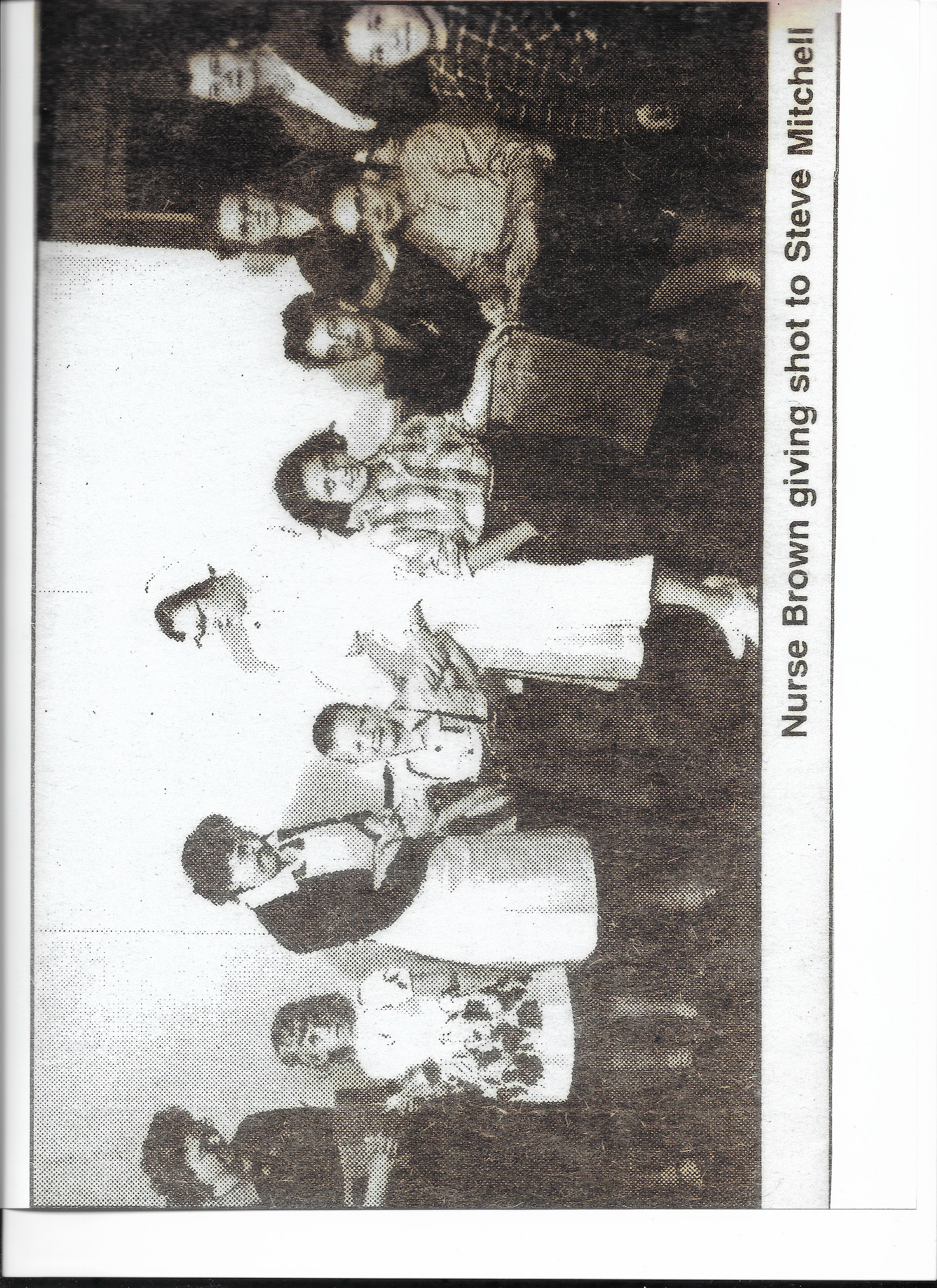
Mrs. Brown and her husband were active in the community and the Smithland Methodist Church. Blanche served on committees such as President of the American Legion, President of the Woman’s Club, and was named a Kentucky Colonel, and a Duchess of Paducah. She was active in fund raising for the Diabetes Association and the Cancer Society.
In researching Mrs. Brown, I found this article in the “Response” Booklet Vol 1, 1988, from the Livingston Central High School written by Jimmi Mullins. It is entitled “She Needled the County for Years.” The following are excerpts from the article that portrays Mrs. Brown’s life in Livingston County.
“There was no road too rough or no person too poor that Mrs. Brown did not see that they got a fair chance for health improvement, even if it meant begging for money or dipping into her own pocket for that extra bit.
Livingston County had only one good road – Highway 60. Mrs. Brown drove her Packard or a Jeep, if the roads were too rough, to the one-room schools in the county. She gave students shots and DIC tests for diphtheria. She gave the first polio shot in Livingston County. Sometimes she had to contend with parents who did not want the shots for their children.
Mrs. Brown became the subject of a laugh or two when she helped with births. She loved hats and would occasionally buy a new one with the $150.00 monthly salary she received. Instead of throwing away the strings around her new hat boxes, Mrs. Brown carried them in her pockets. When a baby was born and a string was needed to tie the umbilical cord, she would reach into her pocket for a hat box string, dip it into a jar of alcohol, and use it for that purpose. “There are no more stings left on balance Brown’s hat boxes,” was commonly heard throughout the county.
Mrs. Brown remembers when Ledbetter had an outbreak of Typhoid Fever. She said she gave over two hundred shots in one day. Mrs. Brown knew practically everyone in the county. No one was safe from her needle. She says she must have given every person in Livingston County a shot at one time or another.”
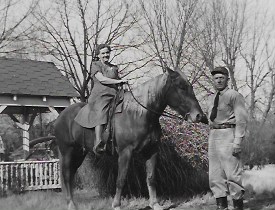
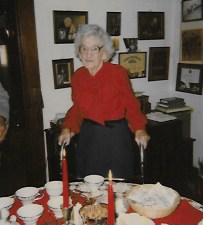
Blanche Brown passed away at her home in November of 1996 at the age of one hundred. She is buried alongside her husband in Pythian Ridge Cemetery in Sturgis, Kentucky.
"In the Presence of Spirits"
June 7, 2024
By Lola Guess (From a Paducah Sun Article by Bobbie Foust dated 7/25/1996)
Every year Carroll Walker of Tiline made a sentimental excursion to Mantle Rock along with four of his friends. Bruce Varvell of Ledbetter, Johnny Dunbar of Benton, Rick Frazier of Ohio, and Linda Dunbar made the journey with Carroll Walker to the place where hundreds of their Cherokee ancestors perished on the Trail of Tears.
These five friends felt this is a sacred place and should be treated with respect such as being in a cemetery where loved ones are laid to rest. Rick Frazier felt the spirits of his ancestors still dwelled there and he came to commune with them.
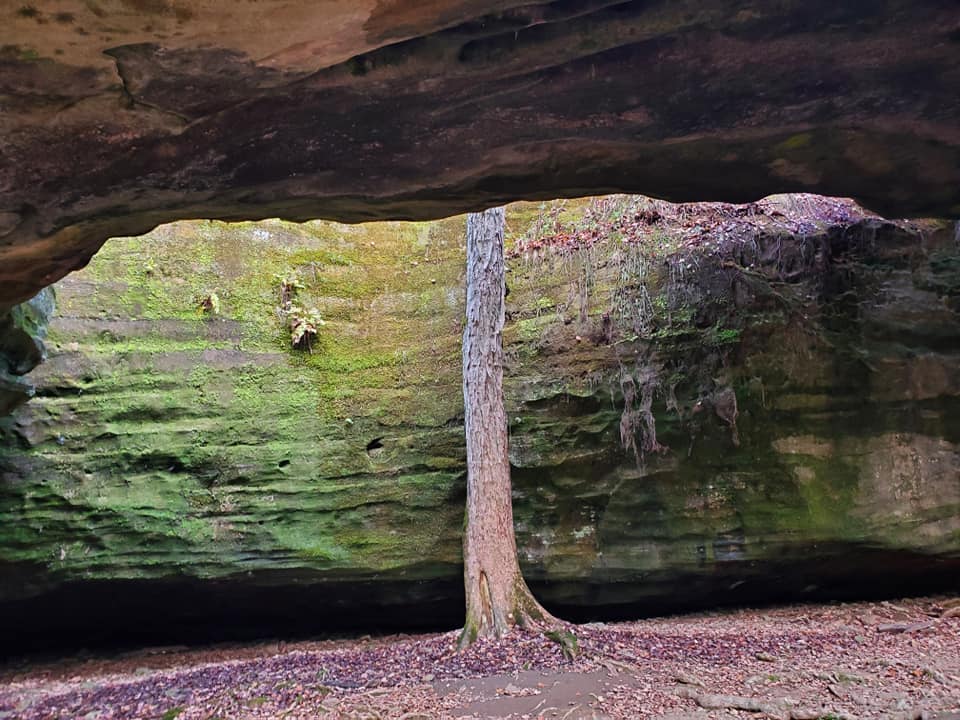
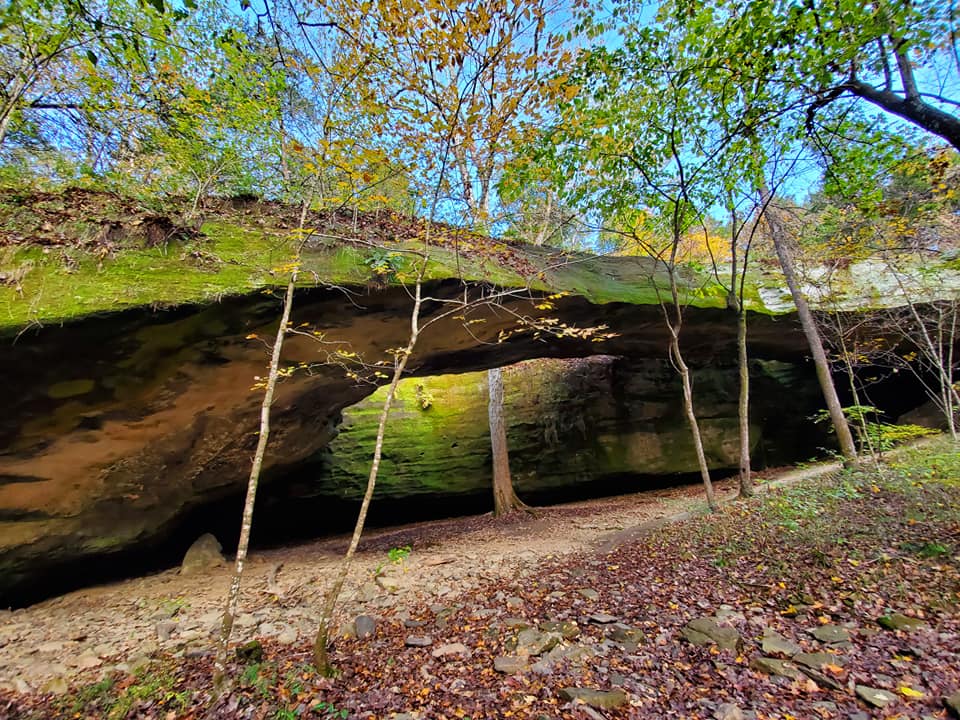
In 2004, the National Park Service recognized the nature preserve as a certified site on the Trail of Tears National Historic Trail and worthy of representation in the National Register of Historic Places. The Nature Conservancy now owns the 191-acre tract.

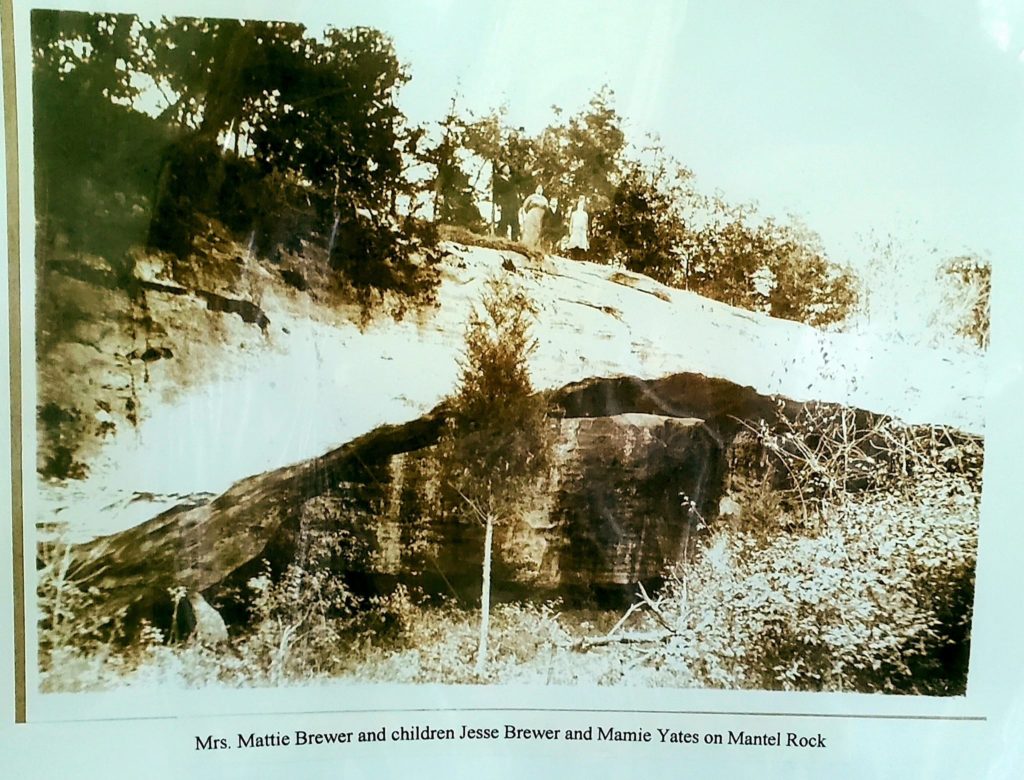
You can hike a portion of the Trail of Tears at The Nature Conservancy’s Mantle Rock Preserve in Livingston County, Kentucky.
The Cicadas Are Here!
May 17, 2024
By Lola Guess
In 1803, President Thomas Jefferson authorized the Louisiana Purchase with a price tag of $15 million dollars. The President then sent Lewis & Clark on an expedition to chart land, rivers, and mountains in the west. Sacagawea, a Shoshone born in what is now Idaho, joined them along the way. Closer to home, Kentucky had been a state for four years and Eddyville was the county seat of Livingston County. Something else happened that same year that has not repeated itself until now and that is two species of cicadas emerging at the same time.
For the first time since 1803, two species of cicadas have come out of the ground simultaneously in different areas of the country. Brood XIII emerged on a seventeen-year cycle and Brook XIX emerged on a thirteen-year cycle. This occurrence will not happen again until the year 2245 which is once in every 221 years. Living underground and feeding off tree roots, the cicadas emerge when the soil reaches sixty-four degrees Fahrenheit at the dept of eight inches. They will eat, mate, lay eggs, sing, and die. They are considered harmless because they do not bite, sting, or carry diseases. Scientists observe that these cicadas are natural tree gardeners and are important to the ecosystem which is a good thing because there is estimated to be billions of these “singing” insects.
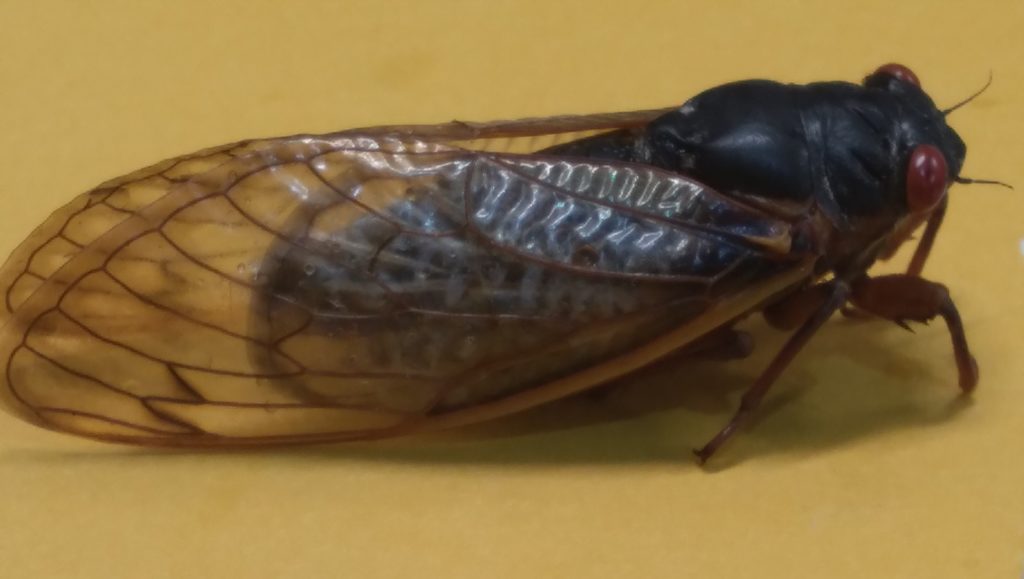

So far in 2024, we have witnessed an eclipse, seen the rare occurrence of the Northern Lights (Aurora Borealis) in this part of the United States, and now we are experiencing the singing of millions of cicadas. Livingston County is a wonderful place to live!
Mary Lou Smith
May 10, 2024
By Lola Guess (compiled from various articles)
Mary Lou Smith knows as much about the history of Livingston County and its people than anyone living today. Around here when inquiring minds want to know—we all say, “ask Mary Lou.”
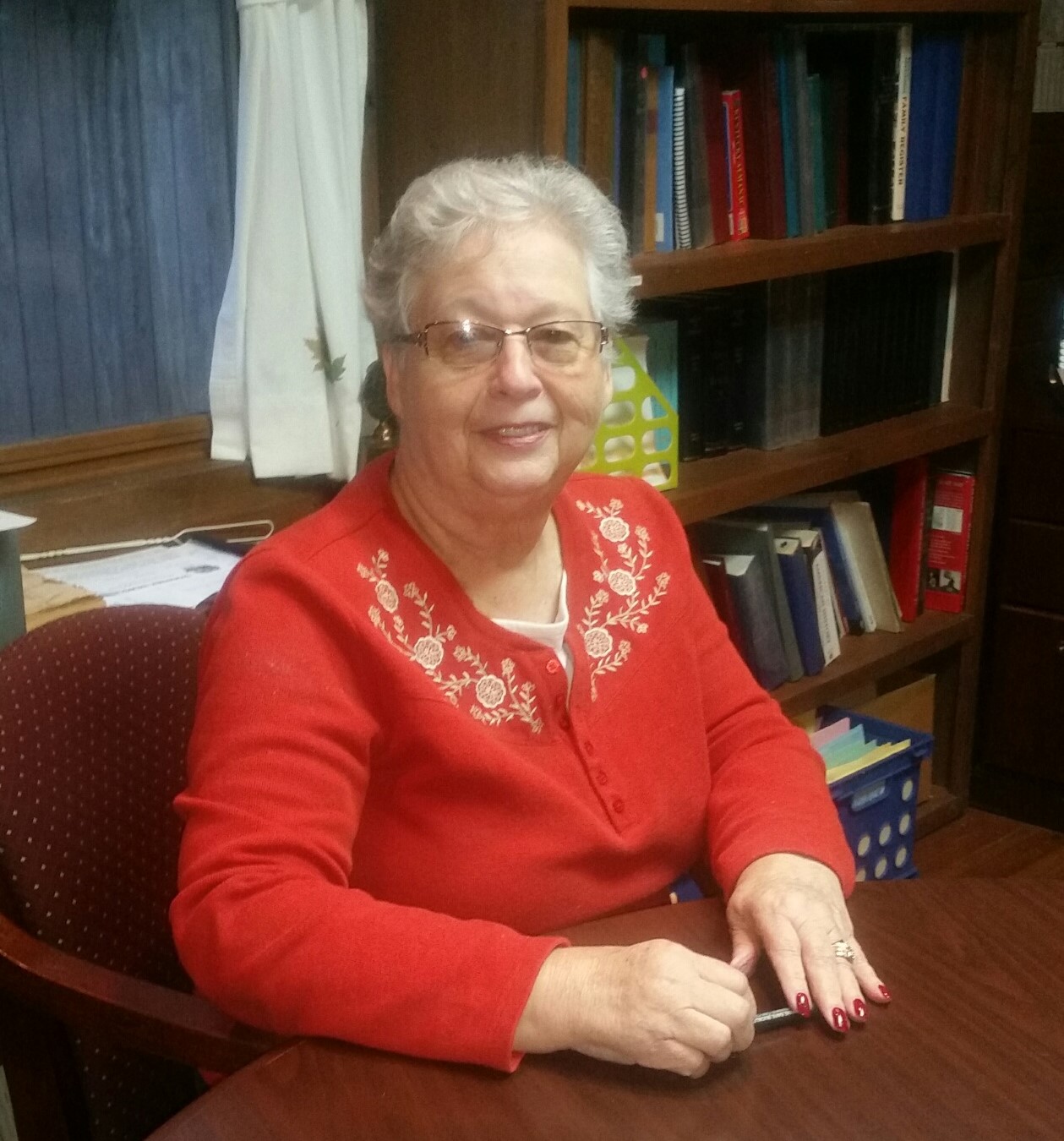
Mary Lou at the Livingston County Historical Society Log Cabin.
Mary Lou Lytton Smith was born on February 4, 1939 and is a lifelong resident of Livingston County, Kentucky. She married Glenn Allen Smith in Corinth, Mississippi, on January 12, 1957. Their daughter, Darlene, was born in 1958 and their son, Jeffery, was born in 1962. She is an active member of the Livingston County Historical Society and has been for over 30 years.
Mary Lou is considered the Society’s “ in house” genealogist and has spent many hours researching family histories and documents. There are twelve file drawers to prove it. She has corresponded with people all over the United States who were seeking information about lost relatives, deeds, wills, court orders, births, deaths, marriages, and miscellaneous documentation. These searches often required Mary Lou to dig through musty county records and files.
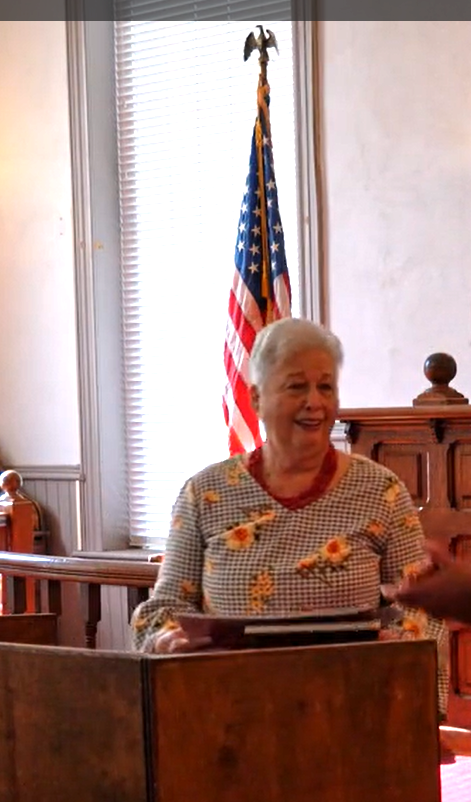
She has also served as secretary and/or corresponding secretary for the Society for over 20 years. She assembled, typed, and mailed a quarterly Society Newsletter in which she compiled and researched most of the items herself. Some stories were sad, funny, and were always noteworthy events that gave a glimpse into the history of Livingston County.
Mary Lou was influential in publishing two volumes on families and the history of Livingston County. In addition to typing and proofreading these books, she contacted and encouraged people to contribute their family stories. Mary Lou Smith is listed in Who’s Who in Kentucky Genealogy and is a Kentucky Colonel. She has been cited by authors and writers as a source for help in authenticating information in their publications.
Mary Lou Smith deserves recognition for her contribution to the preservation of the history of Livingston County.
Thank you Mary Lou!
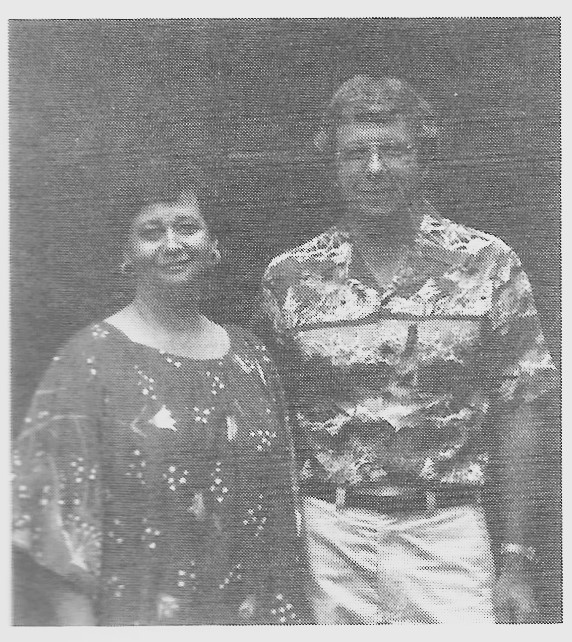
Mary Lou & Glenn Allen “Rusty” Smith
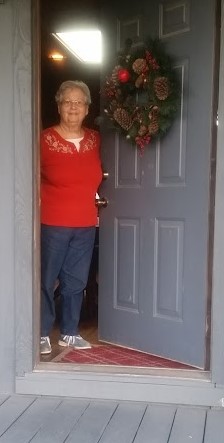
Robert "Bobby" Smith - He didn't come home.
April 26, 2024
By Lola Guess (Information from an article by Charles Lay)
“Smitty was in the foxhole next to mine. I am pretty sure that we were both on the same chopper that took us out of a hot LZ. He was not alive and for some reason I was. Smitty and I were in the same squad. He is one of the few guys I remember.” This is part of a statement posted by a fellow serviceman describing the fateful day Robert Lewis Smith was killed by enemy fire during the Vietnam War.
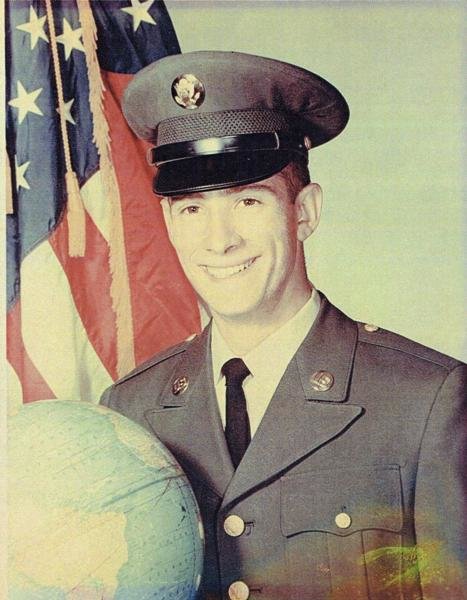
PFC Robert Lewis Smith
Bobby enlisted in the Army on October 19, 1967. He was soon sent to the Republic of South Vietnam and started his tour on March 28, 1968, in Military Zone 1, in the Quang Tri Province. Quang Tri was the site of some of the fiercest ground fighting and was subjected to the heaviest bombing in the history of the world.
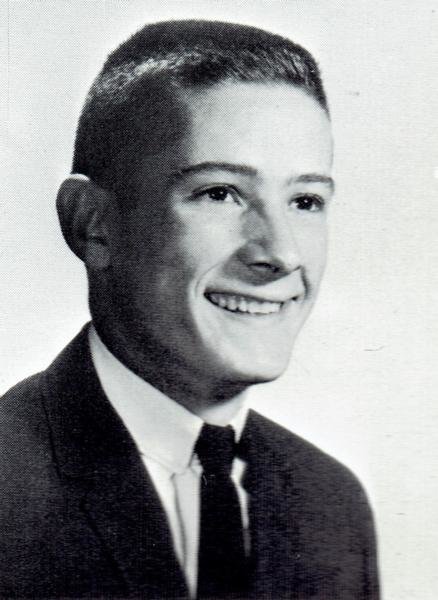

Medals awarded to Bobby
Vietnam Veterans Memorial in Washington, D.C.

PFC Smith was killed by artillery/mortar/rocket fire on Thursday, June 6, 1968. This attack occurred just 70 days after his arrival in Vietnam. He was only 20 years old.
Bobby was the son of Chester and Ruby Smith. He was born on April 5, 1948, in Livingston County. His family included a sister, Judy, and brothers, Terry, and Timothy. He was a 1966 graduate of Livingston Central High School. Bobby’s funeral was held at Livingston Chapel United Methodist Church on June 20, 1968, with burial in Ferguson Cemetery.

Photo by Teresa Bragg Rice
JOY GROCERY STORE
April 19, 2024
By Lola Guess
In the early morning hours on Wednesday, June 21, 1996, Carrsville resident, Virginia McDonald Quertermous’s phone started to ring. When the owner of the Joy Grocery Store answered the phone, she was shocked to learn the store was on fire. Virginia hurried to the scene to find the grocery store burning to the ground.
When Burna Assistant Fire Chief J. L. Culver arrived at 2:45 a.m., he stated that the store was already engulfed in flames and there wasn’t anything the fifteen volunteer firefighters could do.
Henry Myrick was the first person to own a store in Joy. Bill Kiebler was also an early storekeeper. In fact, this was the second time a store had burned at Joy.
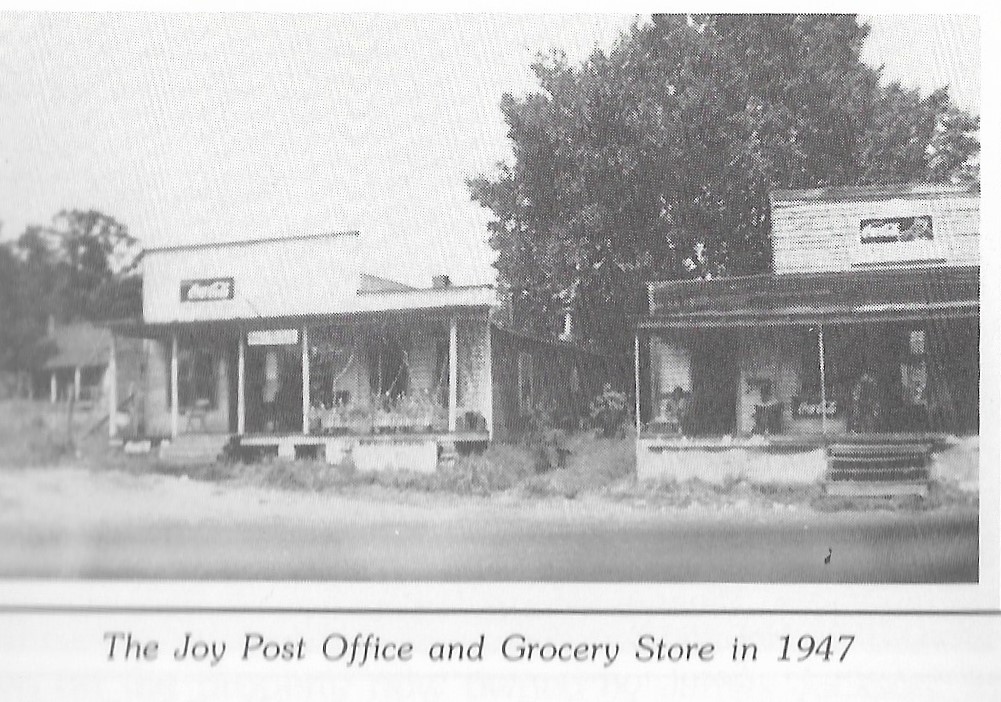
In 1996, Virginia Quertermous had been the owner for the past eleven years. As in most small towns, the general store was more than a place to buy groceries. It was a meeting place where people gathered daily around the stove for sandwiches, a cold drink, or just to talk and tell “tall tales.” Virginia rented videos, had a tanning bed, ran the deer check station in hunting season, and began cooking breakfast for the hunters before daylight. Motorcycle groups passed through Joy following the route of the “Trail of Tears” and often stopped there for lunch.
Virginia served full plate lunches including pizza, chicken and dumplings, chicken and dressing, pies, cakes, soups, and cornbread. A bowl of soup and a slice of cornbread was $2.75 and drinks were fifty cents.
Without delay, the store was rebuilt and opened again for business in November 1996, the same year it was destroyed. Although Virginia worked long hours, she stated she has wonderful memories of the Joy residents and the people that came from far and near to Joy.
Two years after the fire, Virginia was ready to retire for the time being. She sold the store and it stayed open for business until 1999 when the Joy Grocery finally closed its doors.
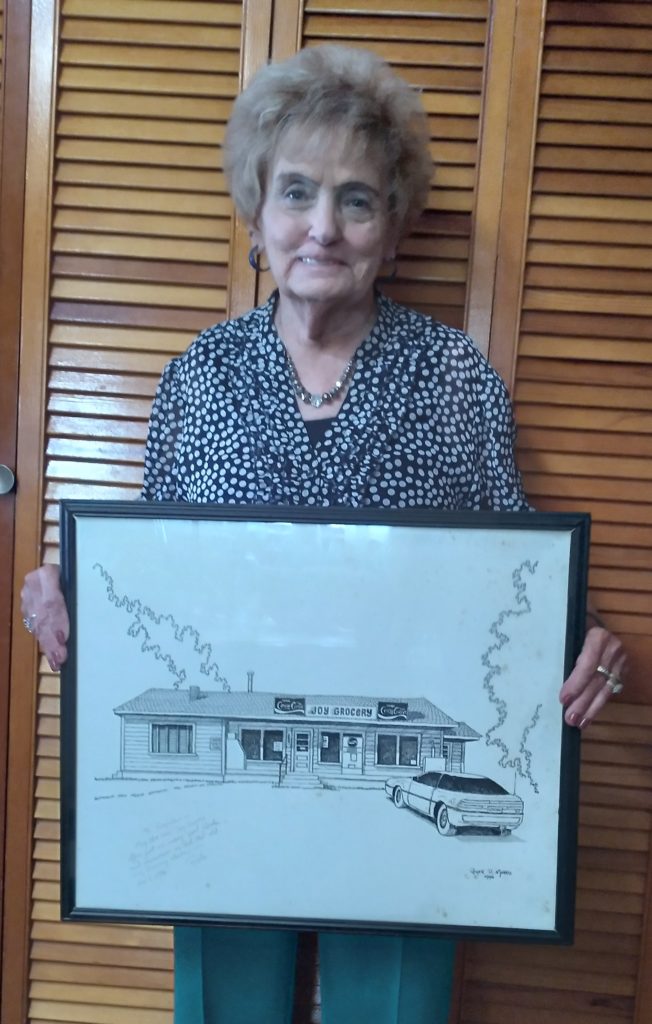
Virginia treasures the drawing of the original store a local artist, Roger Morris, gifted to her.
The Rock Room
April 12, 2024
By Lola Guess
The Livingston County Historical Courthouse Museum is open for the 2024 season. Please check the Museum page for dates and information. We have a lot of things planned at the Museum and at the Historical Society for this year. We will be making announcements soon. There is so much to see, experience, and learn at the Courthouse Museum.
The mining industry in Livingston County was at its peak in the early 1900’s. The “Rock Room” in the Museum showcases this era with information about the mines, rocks, minerals found in and around Livingston County. The beautiful rocks and minerals on display includes fluorspar, calcite, fluorite, iron ore slag and many other categories. The pictures below feature specimens that fluoresce under a black light. This makes these already fascinating rocks stand out even more.

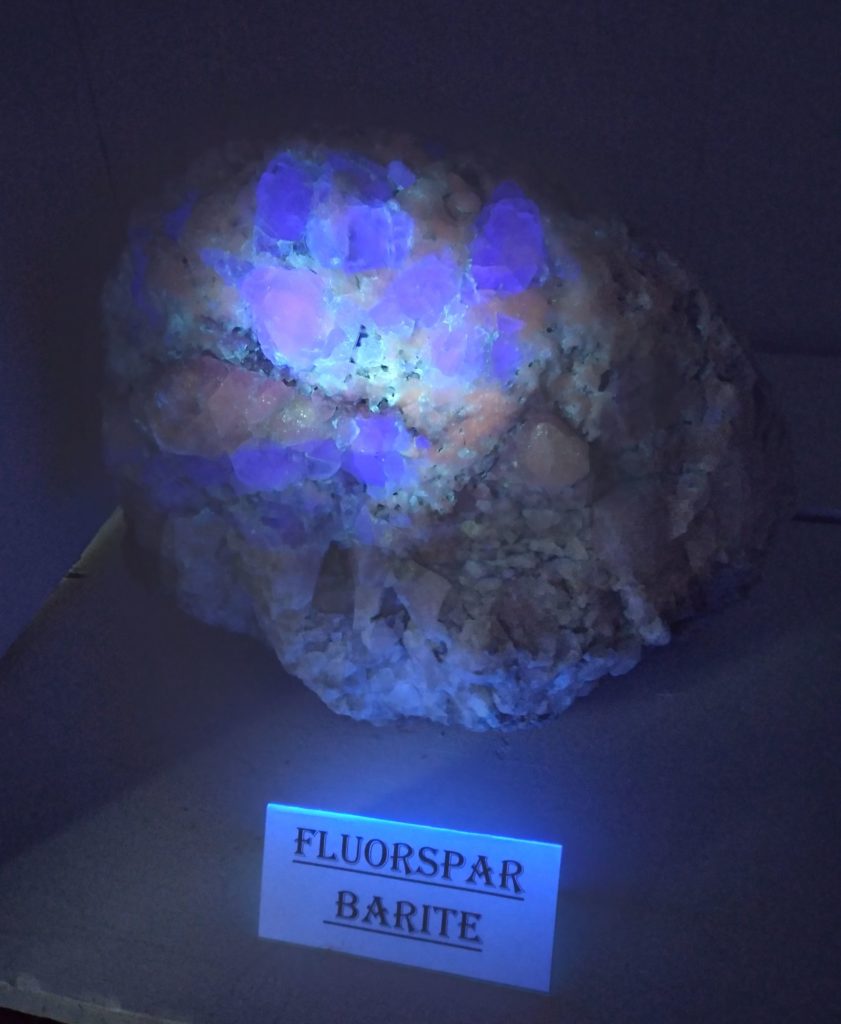
Frank Boyce Moodie IV and his wife, Terri Moodie, have been instrumental in making our displays come to life and giving us the knowledge and background on the specimens. The Moodie family has been in mining for generations and we appreciate their professionalism and the information they have shared with the Historical Society. The generations of mining began with Frances Berrien Moodie who came to Livingston County in the 1870’s. He would scout the county for mineral formations and buy mineral leases. His son, F. B. Moodie Sr. (1874-1955) followed in his father’s footsteps. They were both interested in geology and owned fluorspar mineral mines scattered around the county including the Royal Silver Mine which was the oldest mine in Livingston County. The Klondike Mine, also owned by the Moodie’s, employed 500 people during the Great Depression. F. B. Moodie Jr. (1907-1979) continued in the family business and passed the mining legacy to his son. He was described in a Paducah Sun article as “maybe the most independent man in his county and if you know Livingston County, that’s saying something.”
Frank Boyce Moodie III, the fourth-generation operator in the Western Kentucky and Southern Illinois fluorspar industry was born in 1935 and passed away in 2018. His tombstone reflects his dedication to the family business. It reads “Rock Star – The rocks spoke to me, and I understood.”
We look forward to your visit at the Museum in 2024!
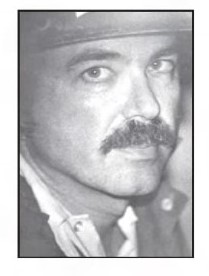
Boyce Moodie III in the 1970’s
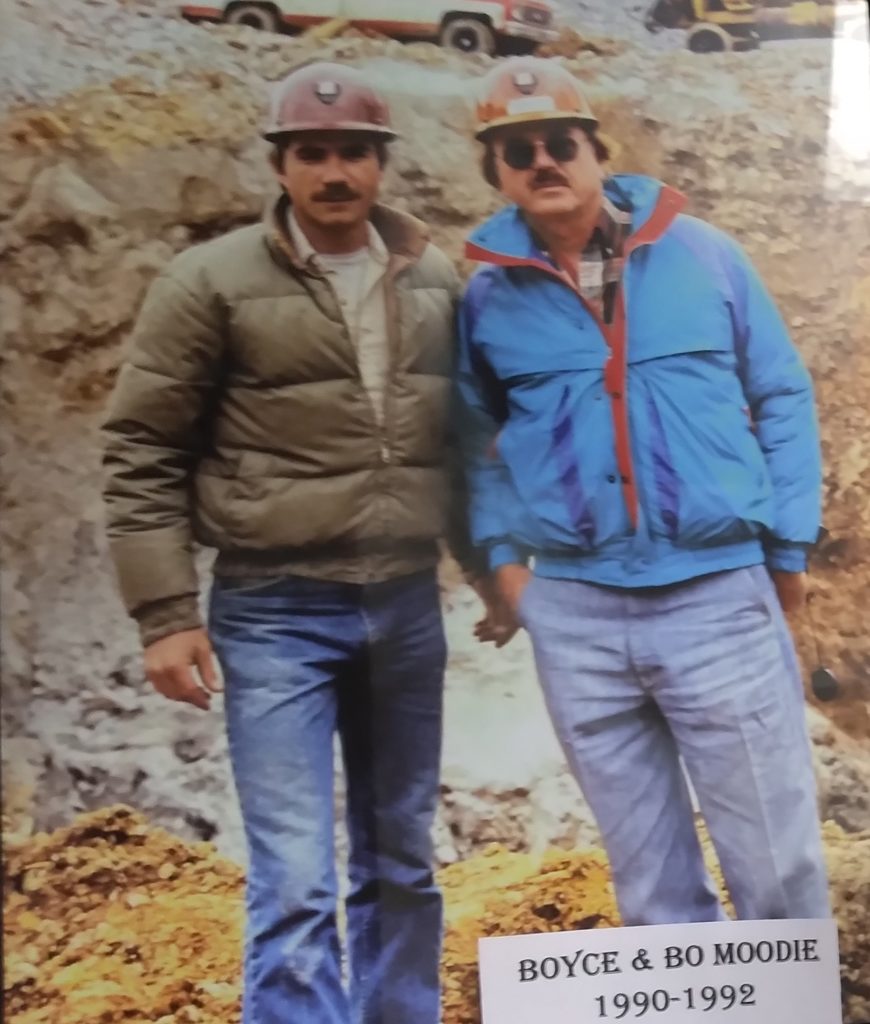
DANA KOLB
March 22,2024
By Lola Guess
If you have never seen any of Dana Kolb’s murals, it should be on your bucket list! The large murals she painted in the Courthouse Museum are amazing. She also has a mural in the entrance of the Justice Center in Smithland, Kentucky. In Providence, Kentucky, Dana was commissioned to paint an outdoor mural depicting the coal mining industry, a mural is in the Senior Citizens Center in Smithland, and various other places as well.
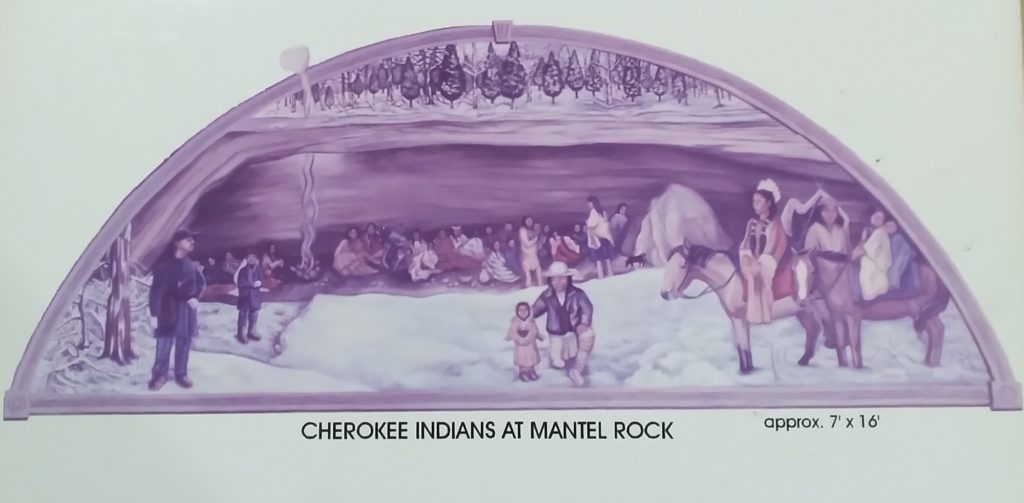
Dana has been featured in newspaper articles, magazines, art shows, and has received awards for her paintings. She not only paints – she also works in textiles, clay, mixed media, grows flowers, grows a vegetable garden, and keeps busy with other diverse talents.

The Livingston County Historical Society is privileged to have Dana’s expertise and expert abilities to create displays in the Museum. Not only are her murals a prominent piece of the Society’s collections, but she has also created mannequins or statues in the Museum that are detailed and lifelike.
Dana Kolb is a gifted artist, a devoted grandmother, and a loving family member. She lives in Tiline, Kentucky, with her husband, Freddie Kolb. Dana can be contacted on her Facebook page, through the Historical Society, or at (270) 963-0977

“Dahlias” by Dana Kolb

A portrait of Dana’s grandfather, “Freeman Guess”

“Gina Guess Croft” portrait by Dana Kolb
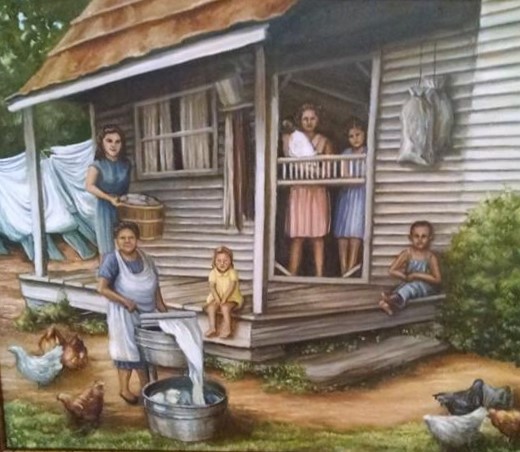
“Wash Day” by Dana Kolb


SALEM HOSPITAL AUXILIARY
March 15, 2024
By Lola Guess
On July 18, 1975, the Salem Hospital Auxiliary was launched. The non-profit organization was composed of twenty charter members from all parts of the county. These women worked in two-hour shifts volunteering their services to the hospital and patients.
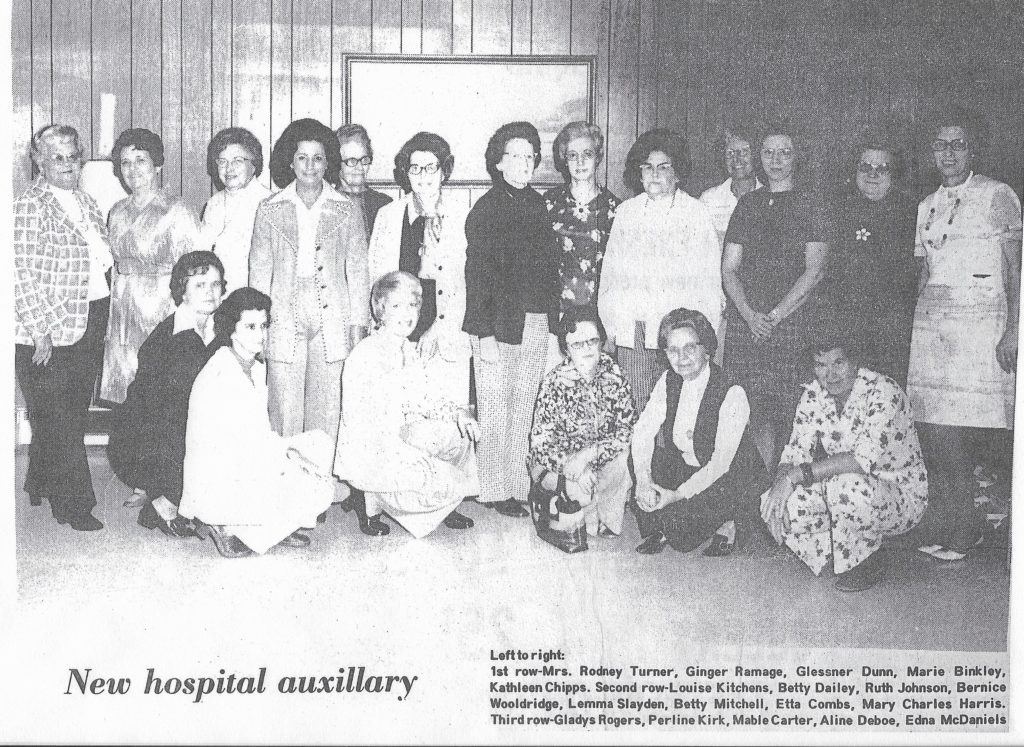
Their first step was to place a reception desk in the lobby where they directed visitors to patient’s rooms. The volunteers delivered mail, read to the patients, fed them, and performed many other useful deeds for patients as well as staff members.
The auxiliary members filled rolling gift carts with useful items such as Kleenex, toothpaste, snacks, and other “goodies” some of which were handmade by the volunteers. They rolled the carts from room to room and provided these items for sale in the lobby to visitors who had friends or relatives in the hospital. This service was provided before a permanent gift shop was established at the hospital.
Fund raising activities through the years have included the Annual Easter Egg Hunt, bake sales, Christmas Bazaars, and various other activities. The money raised goes toward a scholarship program, medical equipment, and items for patient’s rooms such as recliners, wheelchairs, and televisions.
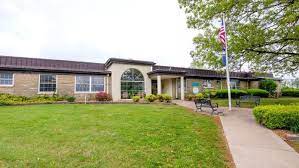
The Womanless Wedding
March 7, 2024
By Lola Guess
A “womanless wedding” was sometimes held as a community fundraiser and involved men of the community dressed up in bridal outfits for a mock wedding ceremony. Men in gowns and dresses played the roles of everyone in a wedding party including bridesmaids, flower girls and the mother of the bride. Brides sometimes had beards or moustaches and flower girls were portrayed by grown men. Such an event was held in 1946 in Salem by the Lions Club of Livingston County.
“Sue Ann Little,” bride at this event, was none other than Smithland Attorney Raymond Dycus.
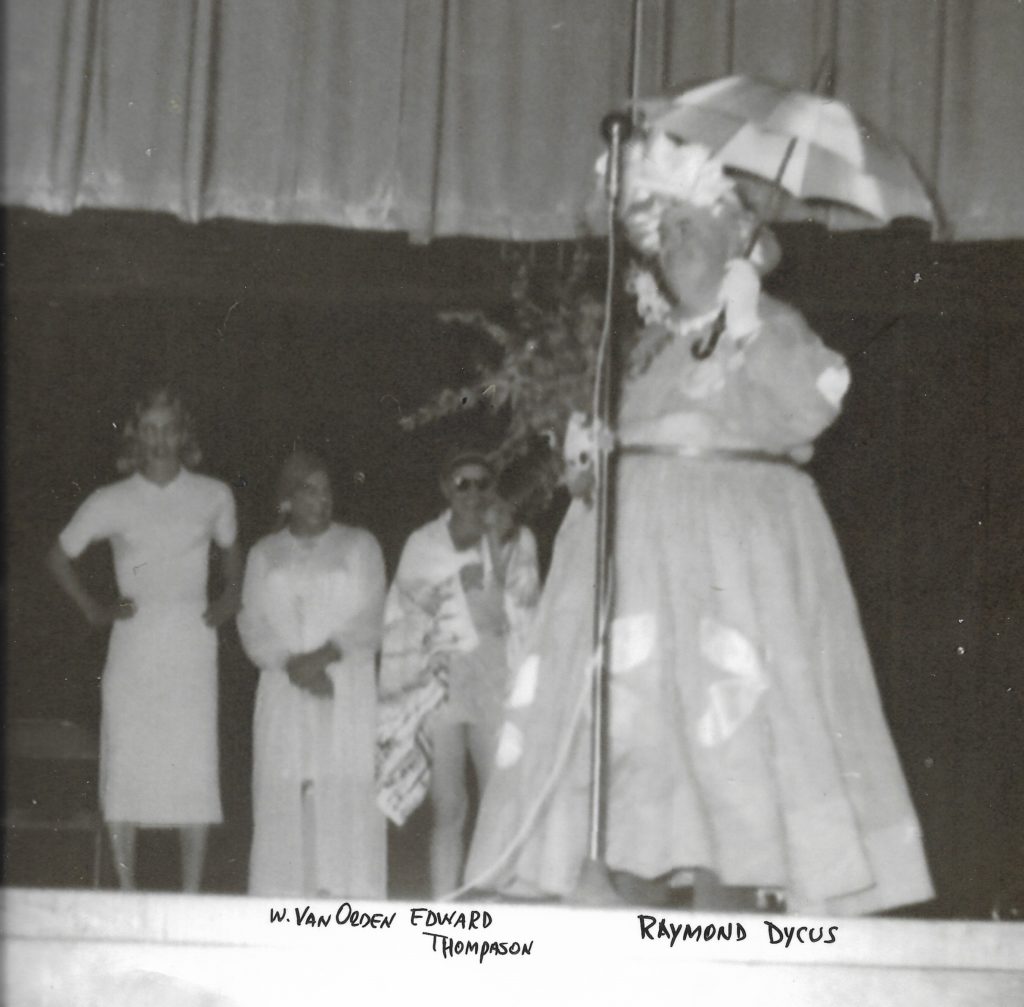

This picture of Attorney Raymond Dycus is on display at the Historical Courthouse Museum in Smithland, Ky.
Ralph Smith Judge - Sheriff
March 1, 2024
By Lola Guess – Condensed from Newspapers
Ralph L. Smith was born in Tiline, Kentucky, on March 19, 1924, to the late John K. and Clara Wolfe Smith. After he moved to Iuka when he was four years old, he told folks he began politicking. During his youth, he enjoyed riding the ferry across the river. The ferry man would give him a nickel and he would buy a soft drink.
He graduated from Livingston County High School in 1943 and began his lifelong pursuit of farming and raising cattle. Even when he lived in a nursing home, his faithful driver took him out to visit his black angus cattle and “count heads.”
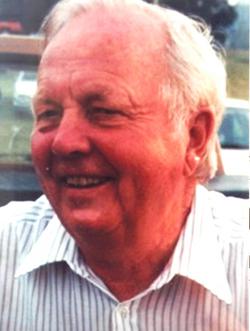
Ralph operated the Smith-Land Stables where he owned and trained many winners in harness racing in the 1980s. In 2006, he was proud to see his grandson’s filly win the Lexington Breeders’ Classic and the Kentucky Sires Stakes at the Red Mile in Lexington, Kentucky.
He rode on the 1988 Trail of Tears Wagon Train in remembrance of the Cherokee Indians who were driven from their homeland and relocated to Oklahoma. Always adventuresome, Hiram and Ann Smith and he, participated in the annual South Texas Trail Ride, a horse and wagon trail ride from Corpus Christi to San Antonio, Texas.
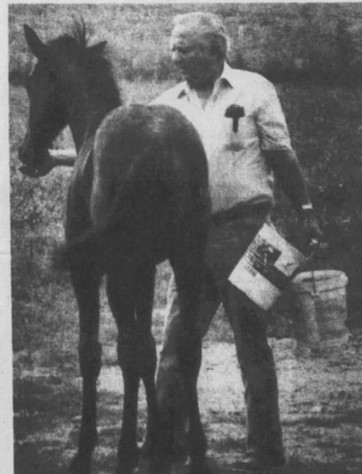
Ralph Smith was sincerely dedicated to public service and to the people of his county. At one time, he was the youngest sheriff in Kentucky, however, when he retired, he was the oldest county judge in Kentucky. Smith’s first term as sheriff was in 1954, with a salary of $400 a month and from that amount he had to hire his own deputy and use his personal vehicle. Because there was a provision in the Kentucky Constitution that prohibited succession, he would go back and forth between the office of sheriff and county judge. When the law changed regarding succession, he was elected County Judge-Executive in 1982 and held that office until he retired in 1999. For years, he held an annual barbeque with horse races on Labor Day for the people of Livingston County. He was also a charter member of the Kentucky Sheriffs’ Association.
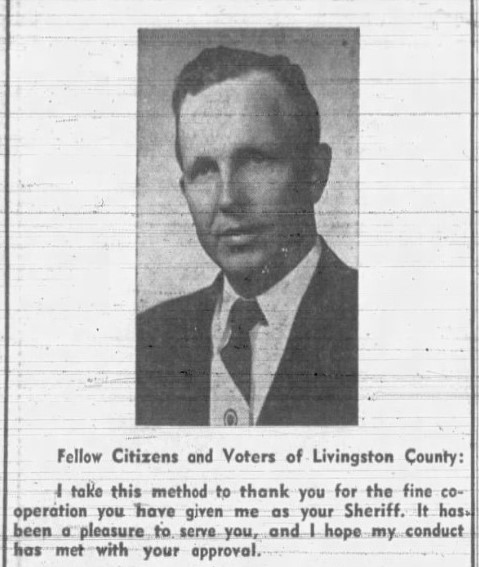
1957 - Campaign Ad
He was honored when the I-24 Cumberland River Bridge which connects Lyon and Livingston County was renamed the Ralph Smith Bridge. In all, he spent 16 years as sheriff and 25 years as the county judge-executive. During his career span of 41 years, he served under twelve governors, but what truly set him apart as a county official was his sincere love of Livingston County residents.
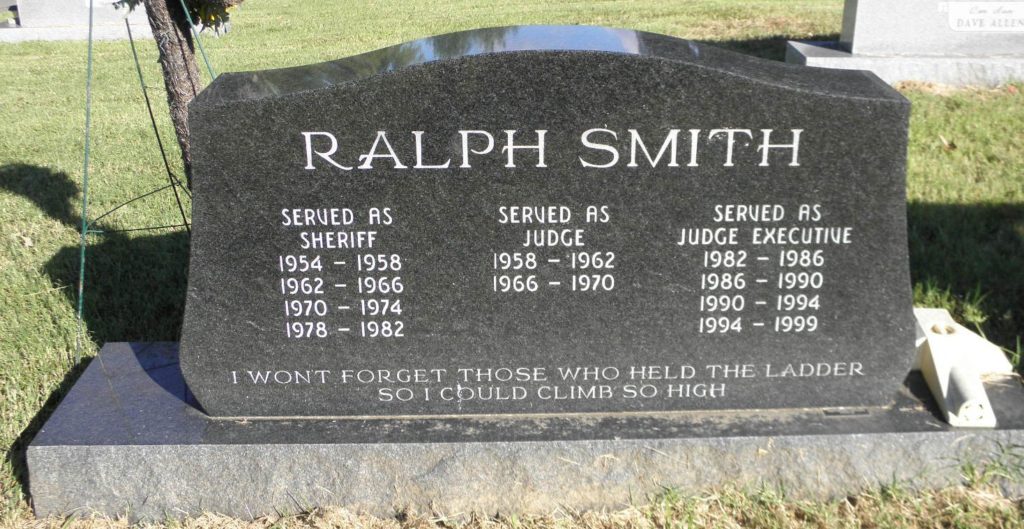
Andy & Marcy Fox - Their Historic Home
February 23, 2024
By Lola Guess
Andrew Scott Fox and his wife, Marcy Loveless Fox, live in Salem, Kentucky, in an historic home. Andy is Vice-President and co-owner of Boyd Funeral Directors. The Boyd Funeral Home was established over 104 years ago in Carrsville, Kentucky. Andrew S. Fox, son of Charles and Alberta Fox, joined the funeral home as a licensed funeral director and embalmer in 1999. Andrew graduated from the John A. Gupton School of Mortuary Science.


Robert and Mary Lou Hollowell also lived in this house beginning in the early 1900s. The house has had other owners through the years and has undergone more than one renovation. Mary Lou Hollowell is described as the person that ended the Night Rider era. In the early morning hours in May of 1907, a band of armed Night Riders wearing masks and on horseback surrounded Robert and Mary Lou’s house shot Mary Lou in the face with bird shot and knocked her unconscious. Robert was beaten and whipped. Their twelve-year-old son, Price Hollowell, witnessed the attack. The shooting was in retaliation because she had testified against the Night Riders who had burned the tobacco warehouses in Princeton. She went to court and eventually was awarded a settlement of $35,000.00. Other details about the Night Rider events and Mary Lou’s involvement is another story for another time.
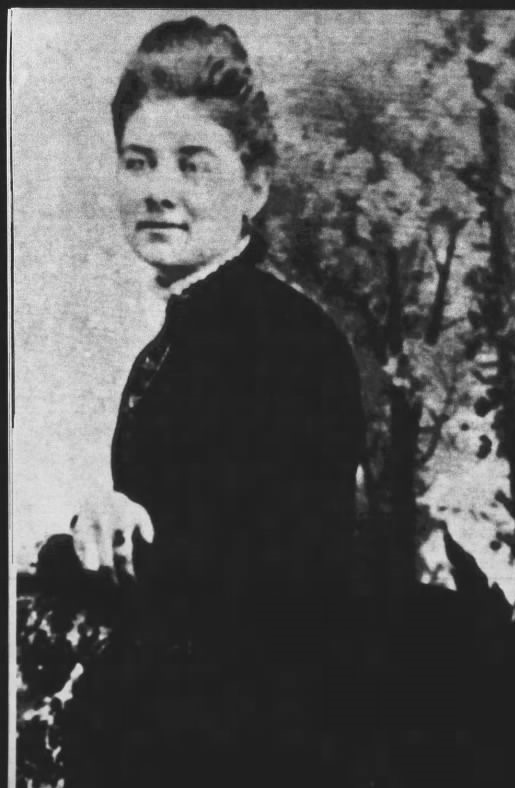
Mary Lou Hollowell
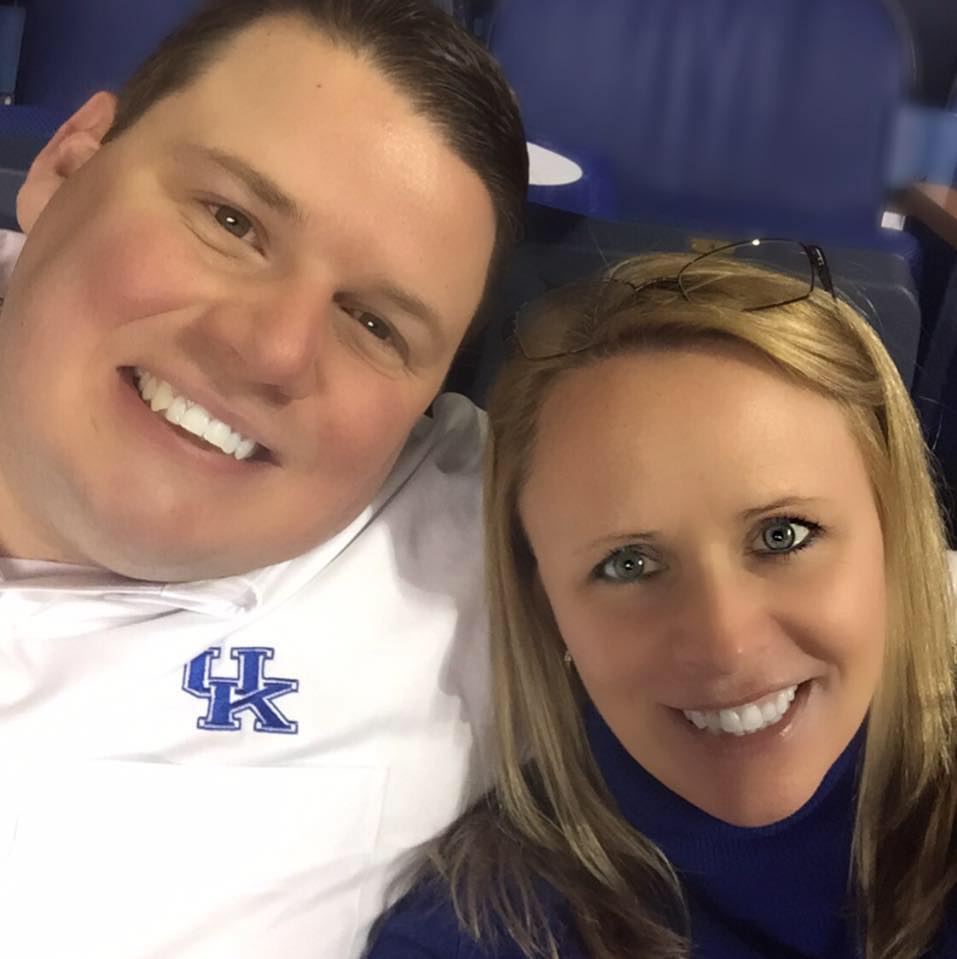
Kenneth C. Crotser
Joy, Kentucky
1932 - 2000
February 16, 2024
By Lola Guess
Frank and Virginia Crotser had two sons named Maurice and Kenneth. The family made their home in the town of Joy, Kentucky. Maurice married Rose Sledd and lived in Reidland, Kentucky. Kenneth, the younger brother by about eleven years, wanted to pursue an education.
At the age of seventeen, Kenneth became a “teacher” before he was a teacher. There was a teacher shortage at the Carrsville Grade School and Kenneth being a knowledgeable person was given the task of teaching the other students. This was in the late 1940s.
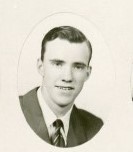
Kenneth Crotser graduated from Salem High School in1950 and from Murray State University in 1964. Governor Ed Breathitt spoke at the graduation ceremony when Kenneth received his M.A. degree.
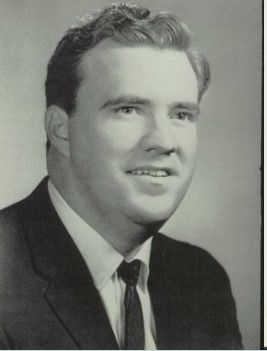
With a degree in hand, Kenneth was soon employed by the Livingston County School System. He taught American History at Livingston Central High School for approximately twenty years and was also Assistant Principal retiring in1985.
Kenneth passed away at the age of sixty-seven on July 25, 2000, at Lourdes Hospital in Paducah and is buried in Bethel Cemetery in Joy where he spent much of his life. Kenneth Crotser was loved by the students and fellow teachers. One of his colleagues remarked that she loved to listen to Mr. Crotser in his classroom teaching history.
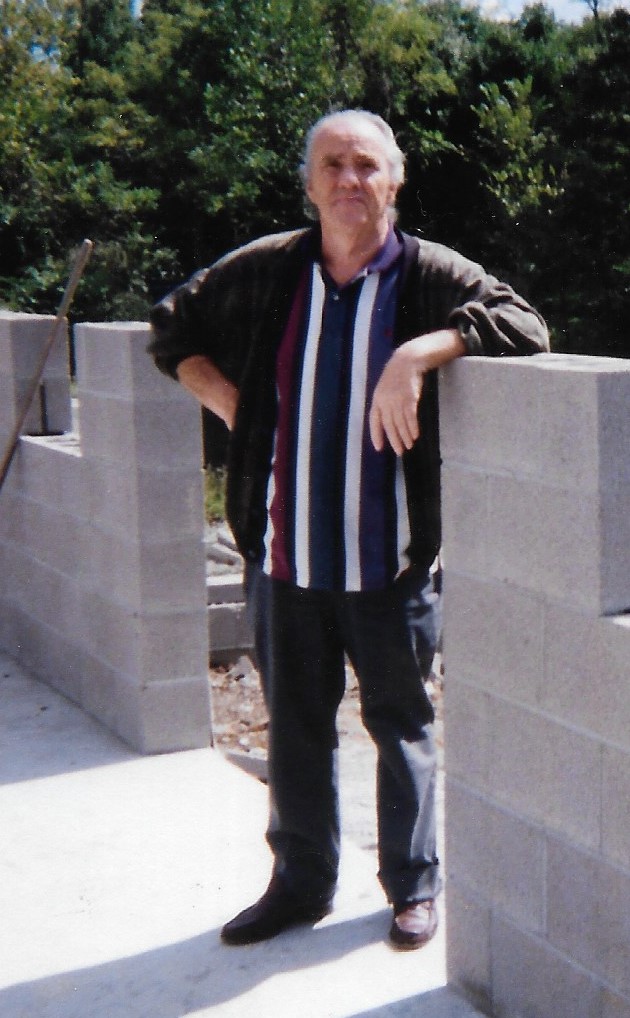
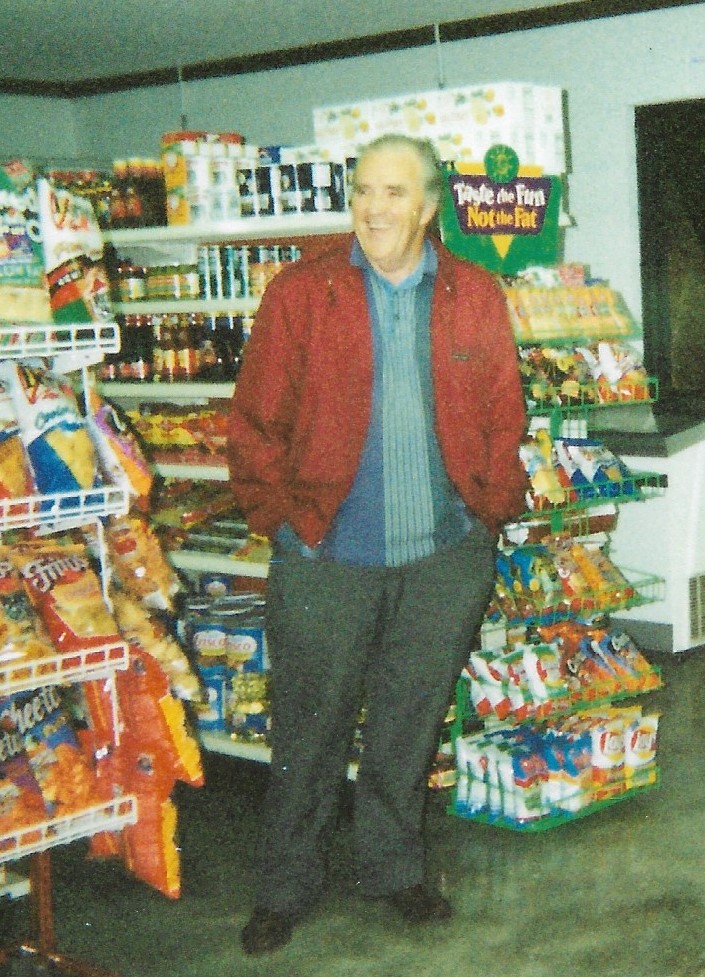
George Washington had Several!
February 8, 2024
By Lola Guess
We have all driven down roads and found crumbling houses from another time with a small vine covered tiny wooden dilapidated structure a few yards away in the back of the house. These are what most people called “outhouses.” And yes George Washington’s home at Mt. Vernon on the Potomac River had several. His own personal “necessary” as it was called by President Washington was a three-seater which was not the norm in rural areas. Were other dignitaries invited to accompany George? Did the President and other founding fathers hold discussions about the future of America in this three-seater?
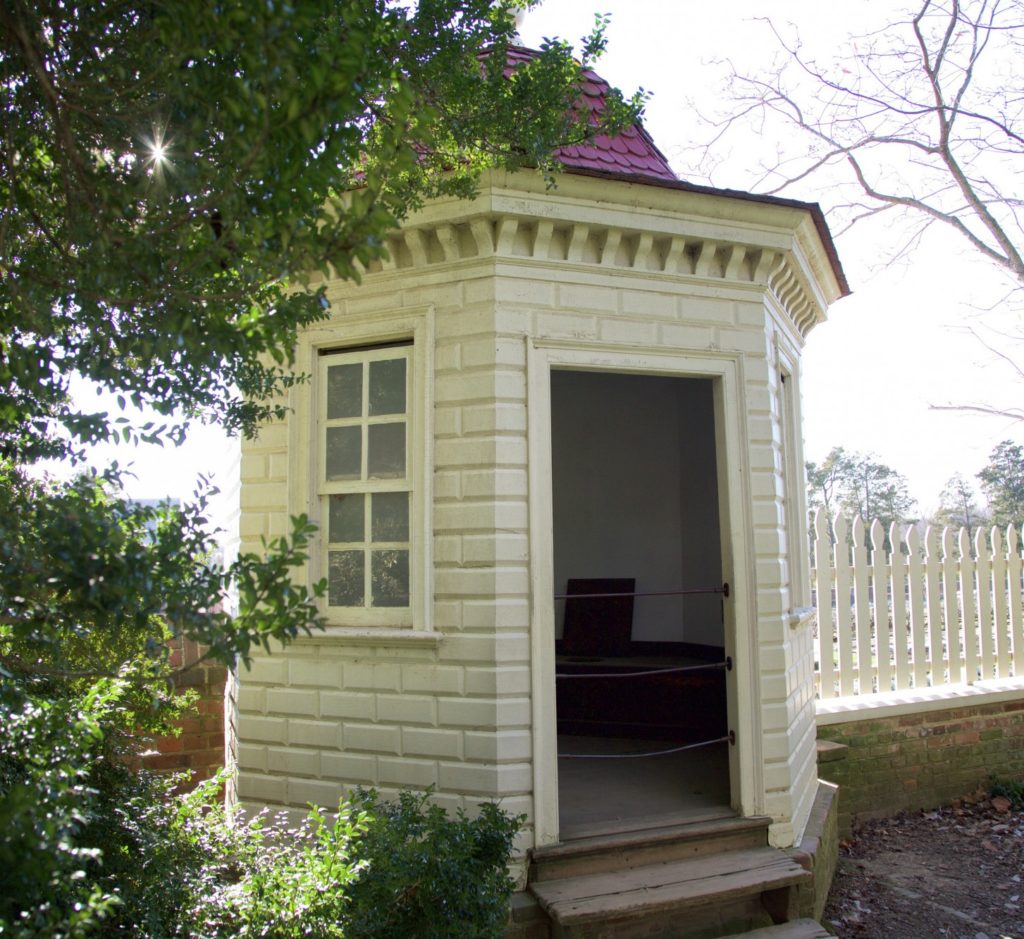
The restored “necessary” at Mt. Vernon.
George Washington’s “necessary.”
Outhouses commonly had a crescent moon or a star carved out at the top of the door. A star indicated a male outhouse and a crescent moon was for female visitors. If there was only one “privy” it usually had a moon symbol. These cutouts also allowed light to get in. If there were two seats, one might be bigger for adults and a second smaller seat would be for children.
The Sears and Roebuck catalog and corn cobs were the next important part of living with outdoor facilities. Upon receiving the Sears Catalog every year, families would pour over the pages for weeks deciding on Christmas wishes and practical needs for the household. When the catalog was outdated, it was moved to the “john” with pages ripped out as needed until it was gone. A sack of corn cobs was used for the same purpose as well as leaves, but the user better be sure there were no poison ivy leaves. Don’t forget the problem of wasps in the summer and the bitter cold in the wintertime.
Outhouses are actually illegal now in Kentucky as well as other states. Some still exist of course. The sport of outhouse racing became popular in Gravel Switch, Kentucky, in 1993. Participants in the races built replicas of outhouses, set them on wheels and raced through the streets trying to win the trophy. There was the “sport” of tipping over outhouses which usually occurred on Halloween night by groups of teenagers. Their favorite target seemed to be the “schoolhouse outhouse” which is also a famous phrase in the hit song “Nutbush” by the late rock star Tina Turner. Last but not least was the fun practical joke of locking the door from the outside when the outhouse was occupied.
There are outhouses still in use today. In these modern times, we have upgraded to the term “porta potties.” Thankfully, the difference now is they are moved away when full or when the event is over.
Hazel Demery
February 2, 2024
By Lola Guess
Not many people can say they stayed in the same job for fifty-eight years. That is exactly what Hazel Demery did. Hazel began working for Reed Crushed Stone as a nurse in 1951 and continued until her retirement in 2009 at the age of eighty-five. She began her nursing career at the Old Blytheville City Hospital School of Nursing in Blytheville, Arkansas, where her parents lived at the time. Hazel graduated in 1941 and worked as a nurse in Arkansas, Tennessee, and other towns in Kentucky until finally accepting the position as the industrial nurse for Reed Crushed Stone when she and her husband, James, moved to this area. When the quarry was sold to Vulcan Materials in 1990, she continued in the same position.
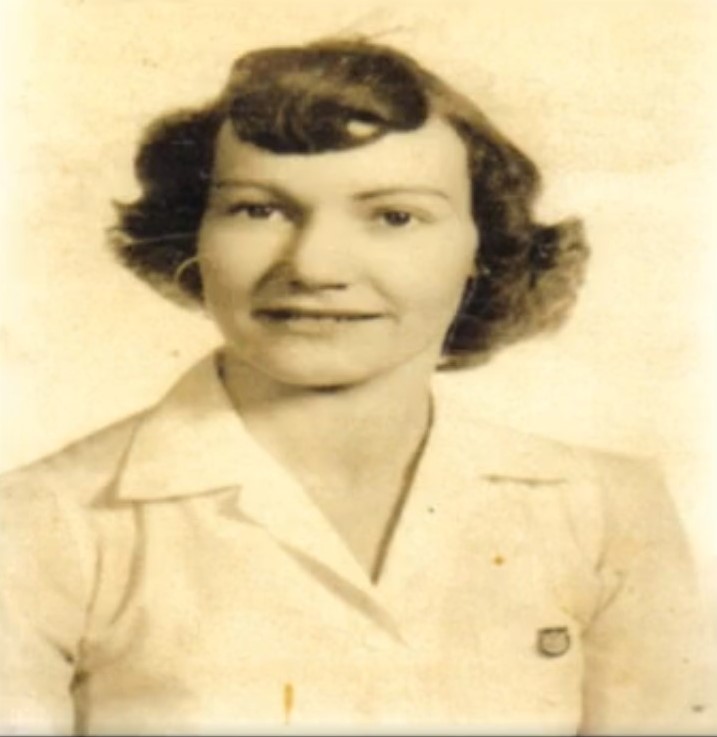
For over sixty years, Hazel Demery was the Red Cross Bloodmobile Chairman for Livingston County. She spearheaded too many blood drives to count. She was there to set up the Red Cross locations and worked tirelessly to ensure the success of these events.
Hazel was the recipient of numerous awards. She received awards and recognition from various political organizations for her work in Livingston County as well as on the national level. She was a Kentucky Colonel, a Kentucky Admiral, and a Duchess of Paducah. She served on the Pennyrile Area Development District Board of Directors for twenty years. Mrs. Demery received the Distinguished Service Citation from the Office of Kentucky Attorney General. Also add to this list the fact that she was a Deputy Sheriff in Livingston County during her career.
Another honor bestowed on Hazel by the city of Grand Rivers occurred when a street in Grand Rivers was named “Hazel Demery Boulevard.” She was chosen as the 1982 Grand Marshall of the Grand Rivers Hunter’s Moon Festival. Hazel held the honor of christening a boat bearing her name. In 2012, Vulcan Materials purchased a tugboat naming it the “Hazel Demery.”
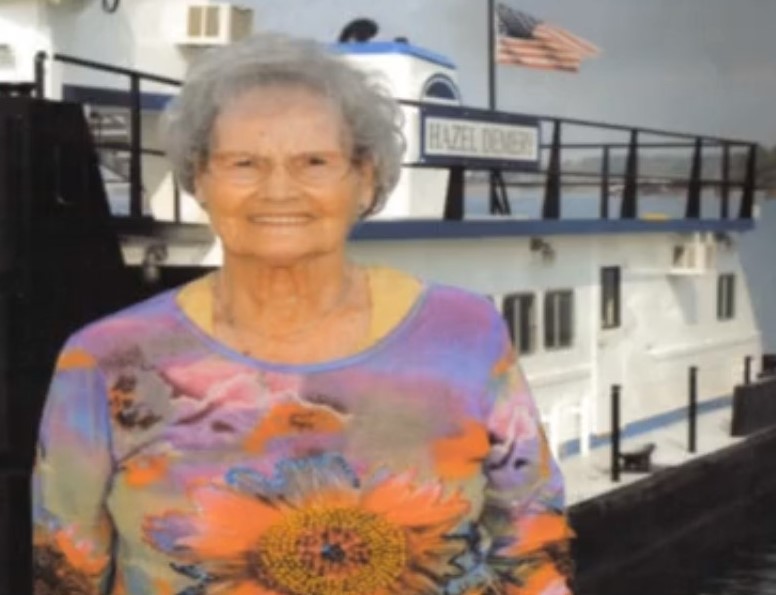
Being active in political events led Mrs. Demery to the national conventions. She was a delegate at the 1996 Democratic Convention at the United Center in Chicago, Illinois, and the 2000 Convention at the Staples Center in Los Angeles, California. The Los Angeles Times featured this picture of Hazel in August of 2000.
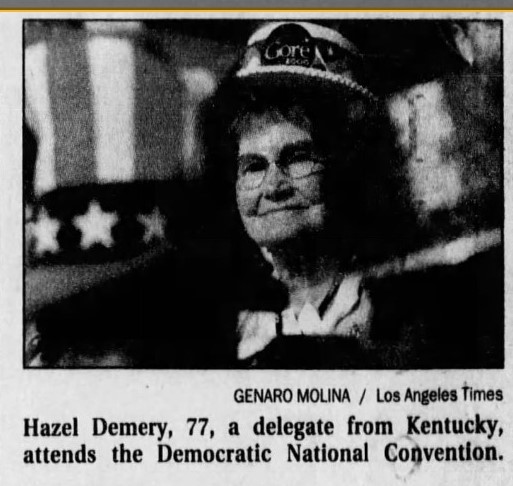
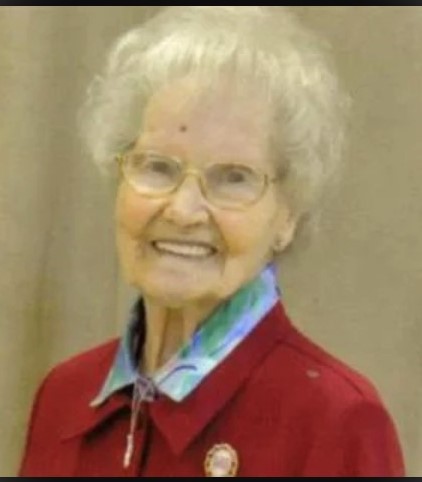
Mark Trail - Artist

January 26, 2024
By Lola Guess
Mark Trail is a loving son, photographer, artist, painter, animal lover, researcher, designer, and diligent worker. There are many sides to Mark and he excels in all of them. The first picture is an example of his awe-inspiring photography skills. He has hundreds of photos that he has taken of historic sites, nature scenes, and events that come to his attention. Could Mark have captured a scene on the right that was experienced by the Cherokee in the winter of 1838-1839 when they were stranded at Mantle Rock on the Trail of Tears?


Mark restores vintage bicycles, license plates, and rescues other historical objects such as clocks with precise workmanship. He rides miles and miles around the county (taking pictures as he goes) and sells these antique bikes to collectors. He does meticulous work as you can see.

The multi-talented Mark paints beautiful scenery and buildings. Along with acrylics, he also creates pencil drawings in black and white.

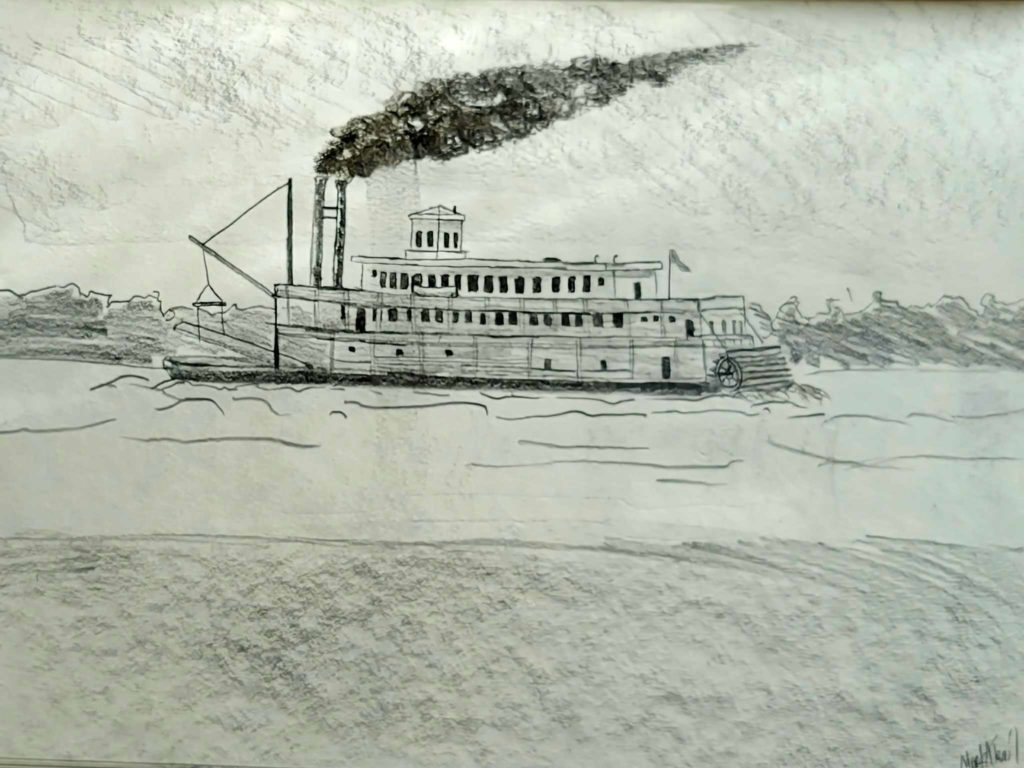
If that isn’t enough, he constructs amazing miniatures of historic buildings. His miniatures are accurate and detailed. Mark has also built a steamboat replica. The Museum is enormously proud to have a collection of these recreations on display for the public to enjoy.
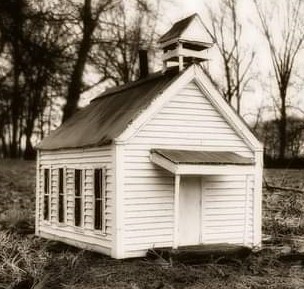

Mark is an avid researcher. He has a wealth of historic information stored in his files. Mention a subject and Mark can show you a picture and is willing to share the facts he has uncovered. He is always there at the Historical Society if work needs to be done. He has moved boxes, created displays, painted, arranged collections, ran errands, and helped on countless other projects. Because he is knowledgeable in the history of Livingston County and with his creative imagination and talent, Mark is a valuable and generous member of the Historical Society. His artistic abilities were showcased in a Crittenden Press newspaper article dated March of 2023.
Mark Trail was born on December 28, 1990. His parents are David and Wanda Trail. The family resides in Ledbetter, Kentucky. Another hobby Mark takes pleasure in is a family of Guinea pigs he keeps. Three of them are named Mr. Reesie, Chief, and Queen Rosie. If you see Mark Trail around Livingston County or somewhere on a bicycle, you can be assured he is doing something productive with his day.


Orville & Elsie Cox
January 19, 2024
By Lola Guess
There was a jail in Livingston County in Smithland for 159 years. Records show that the first jail was built in 1846. In 1892, the jail pictured below was built with the outer shell added in 1950. Jailer James Allen Martin and his son are shown on the right. In the picture on the left, the people are unidentified.. The picture is believed to have been taken in 1931.

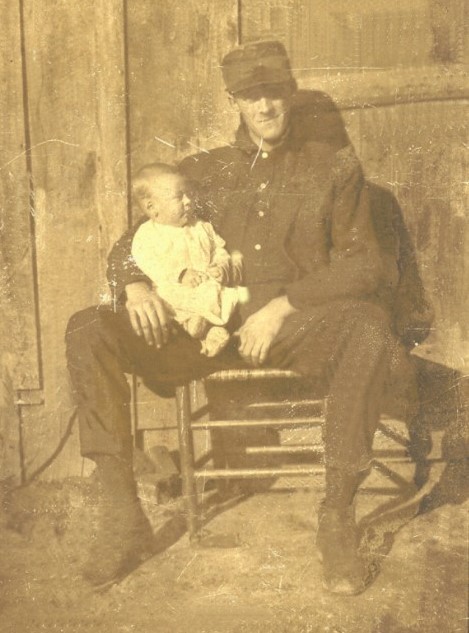
This is a list of jailers posted on the Livingston County Jail website:
Benjamin Guill • 2003 – Present
Lannie Hall • 1982 – 2002
Orville Cox • 1966 – 1981
Spurlin Taylor • 1958 – 1965
G.W. Hosick • 1950 – 1957
W.J. Woodyard • 1946 – 1949
Eugene Myrick • 1942 – 1945
C.B. Scarborough • 1938 – 1941
Jim Martin • 1930 – 1933
C.N. Stringer • 1926 – 1929
J.S. Bennett • 1922 – 1925
Felix B. McGrew • 1914 – 1921
Fred Hardy • 1910 – 1913
L.T Worten • 1906 – 1909
There is no information shown before 1906. From 1910 to 1914, from 1922 to 1926,and
from 1933 to 1938, there are three gaps where no jailer is listed.
Jailer Orville Cox was elected to four terms. He and his wife, Elsie, took care of 4,902 prisoners. Elsie prepared approximately 15,500 meals and raised a garden to provide food for the incarcerated. Two escapes were made during his term in office and in one the prisoner knocked Orville to the ground and he came up shooting.
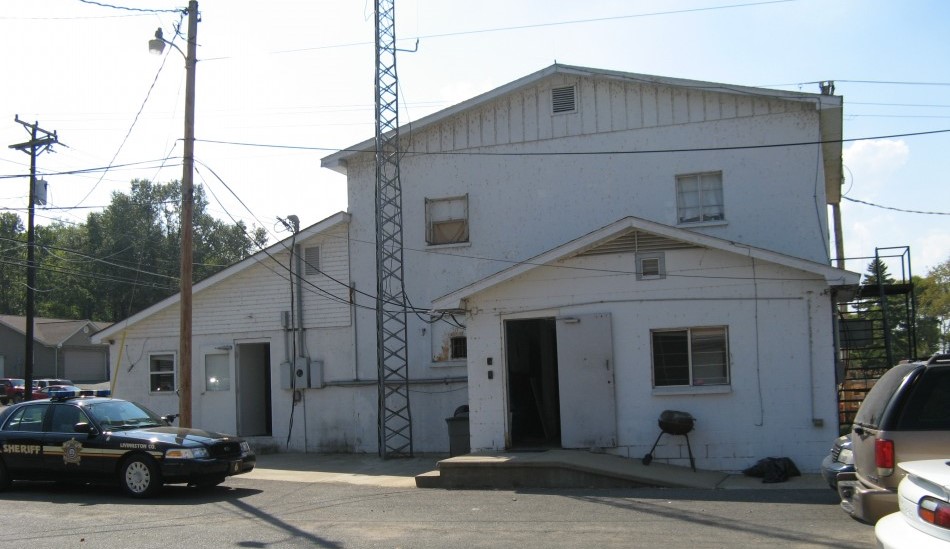
Livingston County Jail – Smithland, Kentucky
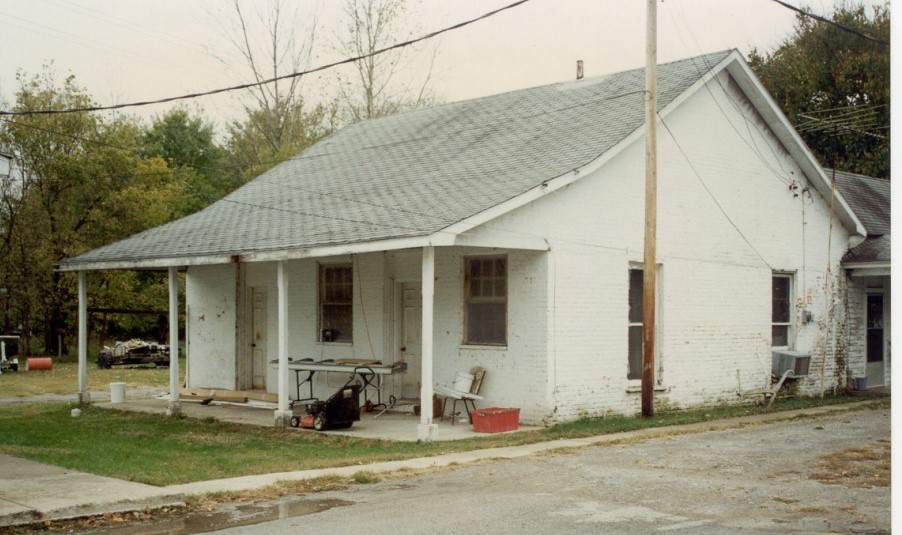
Jailer’s House – Smithland, Kentucky
Despite only having one arm, Orville was considered to be a capable as well as a fair jailer. He lost his left arm in an accident in the spar mines before being elected. The Cox family also provided meals and a place to stay in the jail for people who didn’t have a place to go. Eventually, the state stopped allowing persons who were not prisoners to stay overnight.
Sadly in 1983, the State declared the jail “too small and too old and unfit for human habitation.” County Court Clerk Gabe McCandless stated that “We’ve had a right good jail for a county of this size, in my opinion. We can’t put prisoners up like they were in the Holiday Inn.”
The jail was finally closed on May 16, 2005. Jailer Benji Guill began transporting inmates to other facilities and is responsible for bringing them back and forth to court dates.
Orville and Elsie were married in 1930 in Marion, Kentucky. They had four daughters named Louise, Hazel, Kaye, and Faye. Orville Paul Cox died at the age of 77 (1909-1986). Elsie Wright Cox was 87 at the time of her death (1913-2000). Both are buried in Tyner’s Chapel Cemetery in Crittenden County, Kentucky.
The Historical Society has two of the barred doors from the old jail. They will be on display in the Courthouse Museum.
Bid Southern
January 12, 2024
By Lola Guess
The family farm near Scotts Chapel on the Cumberland River has been in the Southern family for generations. Bid Southern was born on December 26, 1896. He married Edna Mae Cowan in September of 1917. By the age of 21, Bid had never been to Tiline which was only nine miles from the farm. After only eleven months of marriage, the quiet life in Scotts Chapel was interrupted by World War I. Four months shy of his 22nd birthday, Bid was drafted into the Army in August of 1918. He had eighty cents in his pocket when he traveled to Paducah, boarded a train, and was sent to West Point, Kentucky, for training.
This was the beginning of the four months that Bid Southern remained in the Army. After two months of training, Southern was admitted to the hospital with influenza. The 1918 influenza pandemic took the lives of many enlisted in the armed services. Bid was transferred to Camp Knox where he contracted measles. Eight days later he was sent to Camp Taylor Hospital with pneumonia. His condition did not improve and finally was put in a ward reserved for the dying.
Bid Southern was not dead of course, but the hospital help decided that he was deceased since he was unable to speak or move. The hospital moved him to the morgue and attached a card to his toe stating where to ship the body. Bid stayed there waiting for shipment. The hospital was overwhelmed by the number of influenza patients and was unable to properly care for the soldiers.
Fate intervened and Bid was saved from being buried alive by an alert attendant who noticed Bid’s eyelid flickering. The attendant immediately called a doctor, and Bid was soon back in the hospital ward. Recovery was slow and by the end of four months, Southern returned to Livingston County. His 80 cents had grown to $128.00. He had earned $18 by washing clothes for other soldiers, had saved $30 from his Army pay, and Mae had saved $80 of the money the Army had sent to her.
Bid lived a long and productive life in the Scotts Chapel Community. He passed away in 1988 at the age of 91. Mae died in 1993 at the age of 93. They are buried in Scotts Chapel Cemetery.
Hershel Southern was born in 1928 and married Patricia Vick. They had two children, Charlotte, and Charles Lynn. Herschel passed away in 2018 at the age of 90. Charlotte married Thomas E. Barnett and Charles married Dawn Crass.
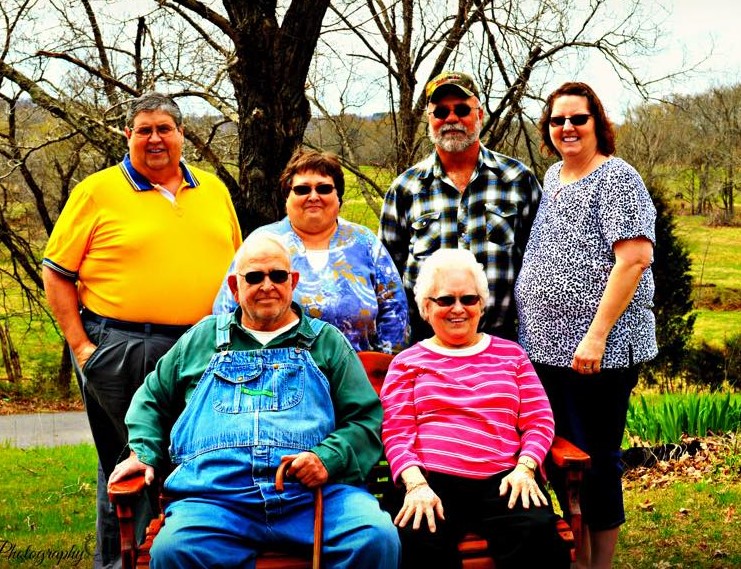
Front: Herschel & Patricia Southern
Back: Thomas & Charlotte Barnett, Charles Lynn & Dawn Southern
Charles and Dawn have two children, Kayla (Derek) Curnel, and Klay (Emily) Southern. The Southern family has continued to live on the farm until this day. Patricia Southern is 90 years old. Along with running the farm, Klay was elected Livingston County Magistrate in 2018 for the Fourth District and is currently serving his second term.
The Southern family has been generous in donating historical artifacts to the History Society. In 2023, Thomas Barnett published a book entitled “Smiles & Tears from Bizzell Bluff.”
The Next Generation

Klay, Emily & Kallie Southern
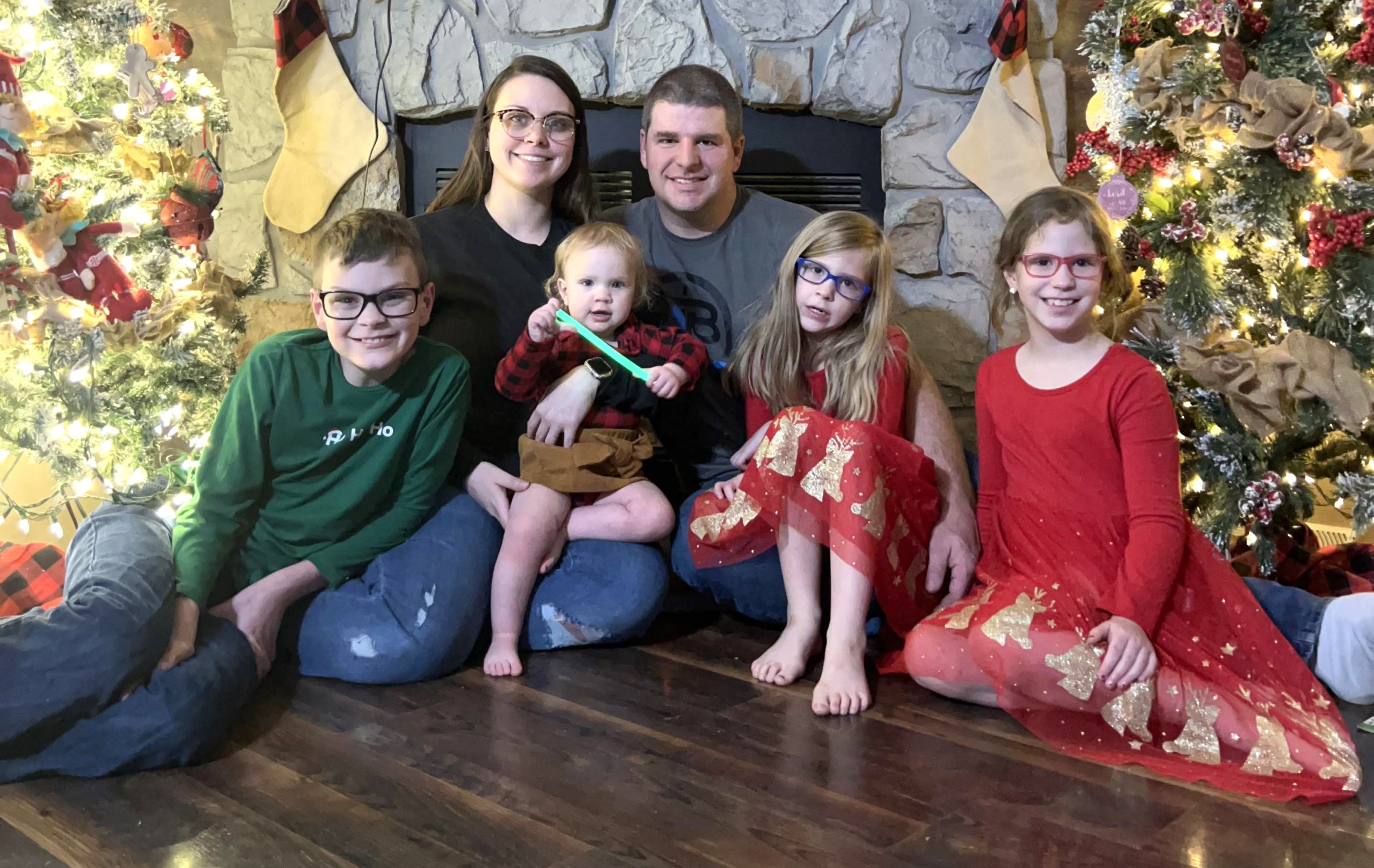
Front: Bryan, Brixlee, Bryza & Brylee
Back: Kayla & Derek Curnel
The 1959 State Basketball Team
January 5, 2024
By Lola Guess
The following is a picture of the 1959 Kentucky State Second Region Championship Team. This is the only team that has played in the Sweet Sixteen at the Kentucky State Basketball Tournament. The team was led by #44 Don Ringstaff who graduated in 1959, had 1,838 career points, and went on to coach the Livingston Central Cardinals from 1966 until 1986.
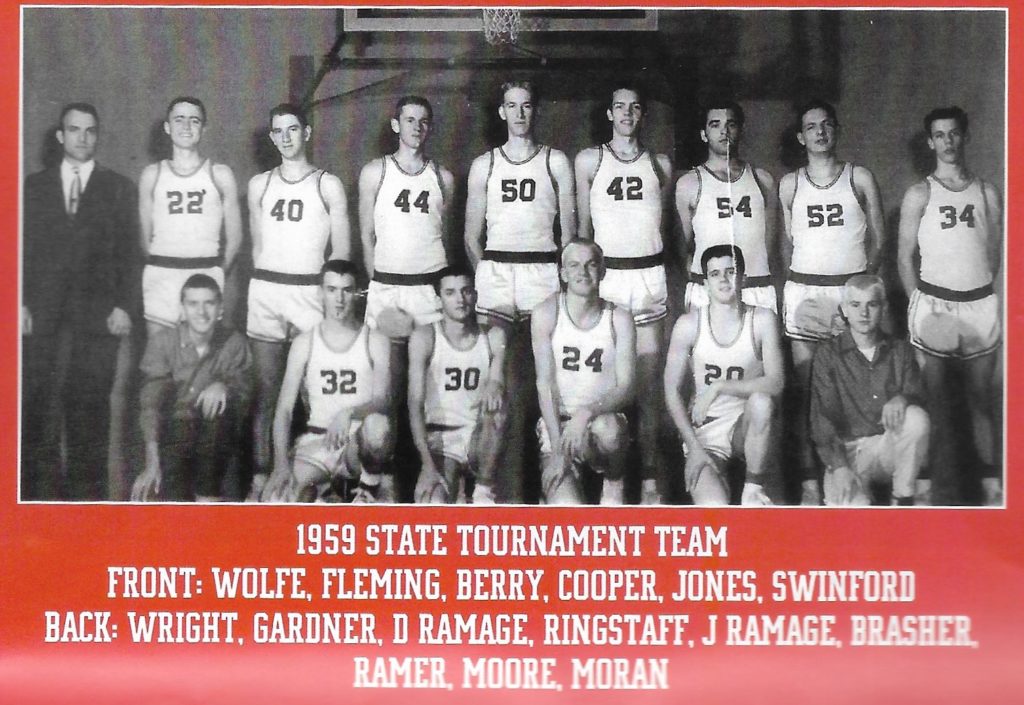
This is how the Cardinals got to the state tournament.
Livingston Central began the road to the state tournament by beating Crittenden County in the first game of the Fifth District Championship. In the second game against Lyon County, C.C. Brasher led the scoring with 26 points followed by Don Ringstaff with 17. On March 7, 1959, the third and final game of the district tournament, Livingston beat Trigg County by 5 points.
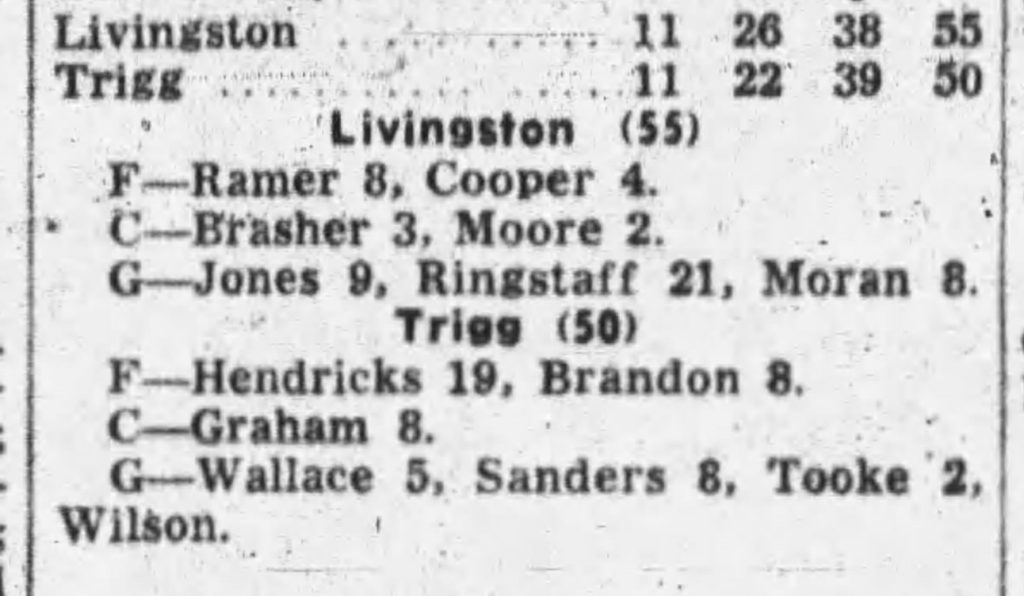
The Regional Championship began on March 12th with Livingston winning against Todd County by a score of 70 to 61. In the second game, Don Ringstaff led the scoring again with a win over Dawson Springs by only one point. And finally, the Cardinals beat Crofton by four points to earn the Regional Championship trophy.
The State Tournament- Thursday, March 18th, 1959, at 10:45 a.m. – Memorial Coliseum, Lexington, Kentucky Livingston Central Versus Olive Hill
The newly consolidated school’s team was considered a dark horse and was not given much of a chance against the 16th region’s powerful team from Olive Hill. The Redbirds arrived in Lexington late Wednesday night after a practice in Elizabethtown. The players stayed at the Phoenix Hotel in Lexington (the hotel closed in 1977). Coach Frank Wright had led the team to a season 22-12 record. “Wright indicated he would go down the line with his usual starting lineup. Versatile Don Ringstaff will get the nod at a guard position along with hustling Lee Jones. Big Charley Brasher will open in the pivot slot with Pat Cooper and Ed Ramer getting the call at the forwards,” as quoted in the Paducah Sun.
The Olive Hill Comets were described as tough and a top-bracket favorite. They had a 34-2 record for the season. Livingston stayed in the game for the first three quarters and then in the last half of the fourth quarter, the team was described as finally running out of gas. “Ringstaff turned in a crowd-pleasing performance that should have earned the 6-2 blond all-tournament honors…Little Freddie Moran, who had a big hand in getting the Cardinals to the big show, turned in a standout game as a substitute. The game is probably the swansong for Coach Frank Wright. The personable Wright turned in his resignation before the district tournament opened.” (The Paducah Sun, March 19th, 1959.) In the end, Livington Central lost to Olive Hill by a score of 88-78. Although no other Cardinal team has made it to the Sweet Sixteen, we are proud of all the Livingston Central sports teams and support them to the fullest.
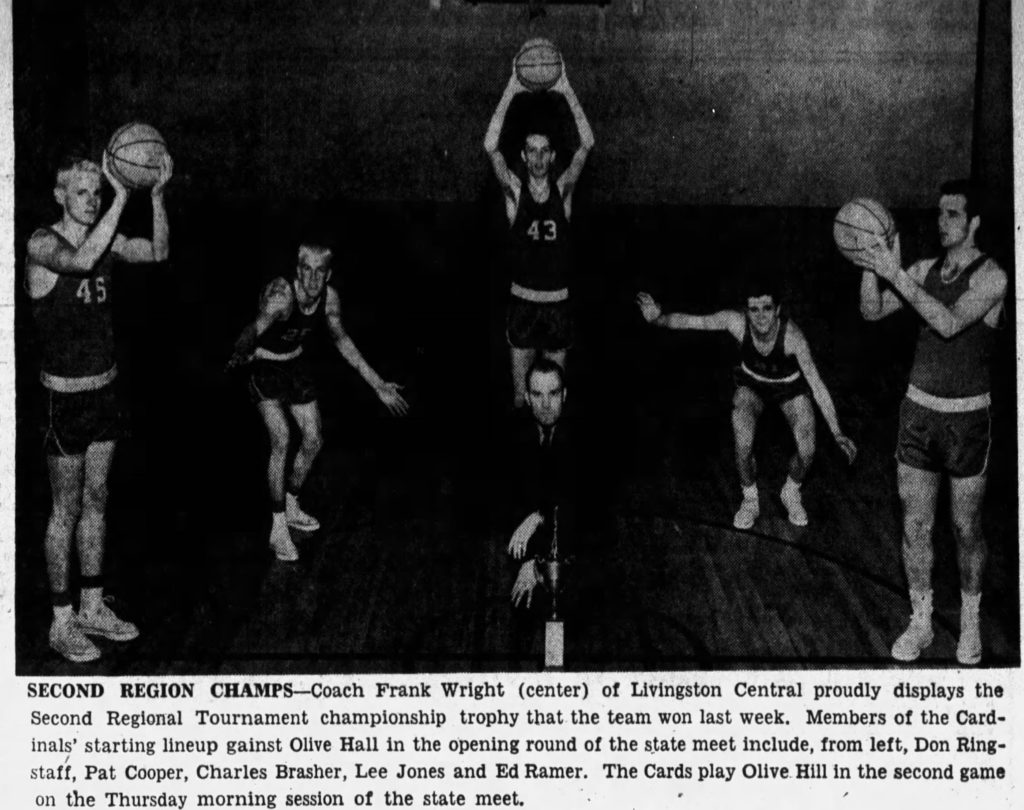
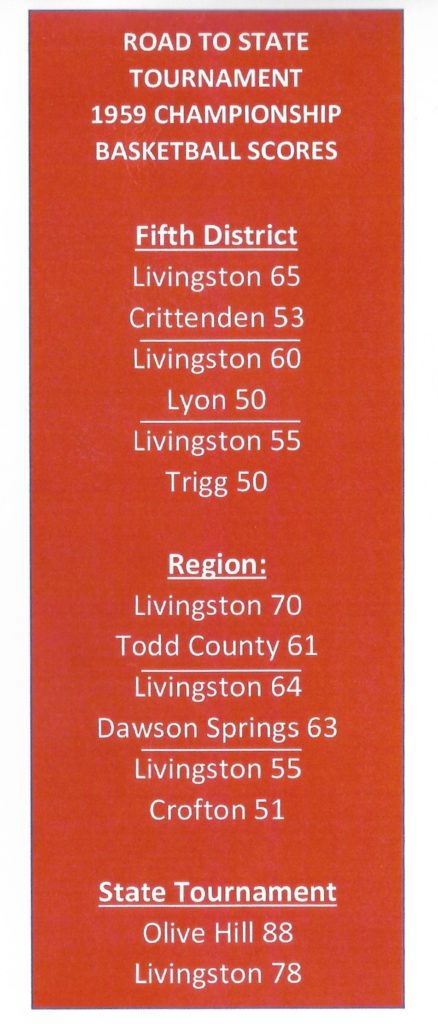
Christmas in the Courtyard
Smithland, Kentucky - December 3, 2023
December 9, 2023
By Roger McGrew
The Preacher & the Song Leader
December 1, 2023
Author Unknown
There was a church where the preacher and the song leader were not getting along. As time went by, this began to spill over into the worship service. The first week the preacher preached on commitment and how we all should dedicate ourselves to the service of God. The song leader led the song “I Shall Not be Moved.” The second week the preacher preached on tithing and how we all should gladly give to the work of the Lord. The song leader lead the song “Jesus Paid it All.” The third week the preacher preached on gossiping and how we should all watch our tongues. The song leader led the song “I Love to Tell the Story.” With all this going on, the preacher became very disgusted over the situation and the following Sunday told the congregation that he was considering resigning. The song leader lead the song “Oh Why Not Tonight?” As it came to pass, the preacher did indeed resign. The next week he informed the church that it was Jesus who led him there and it was Jesus who was taking him away. The song leader lead the song “What a Friend We Have in Jesus.”
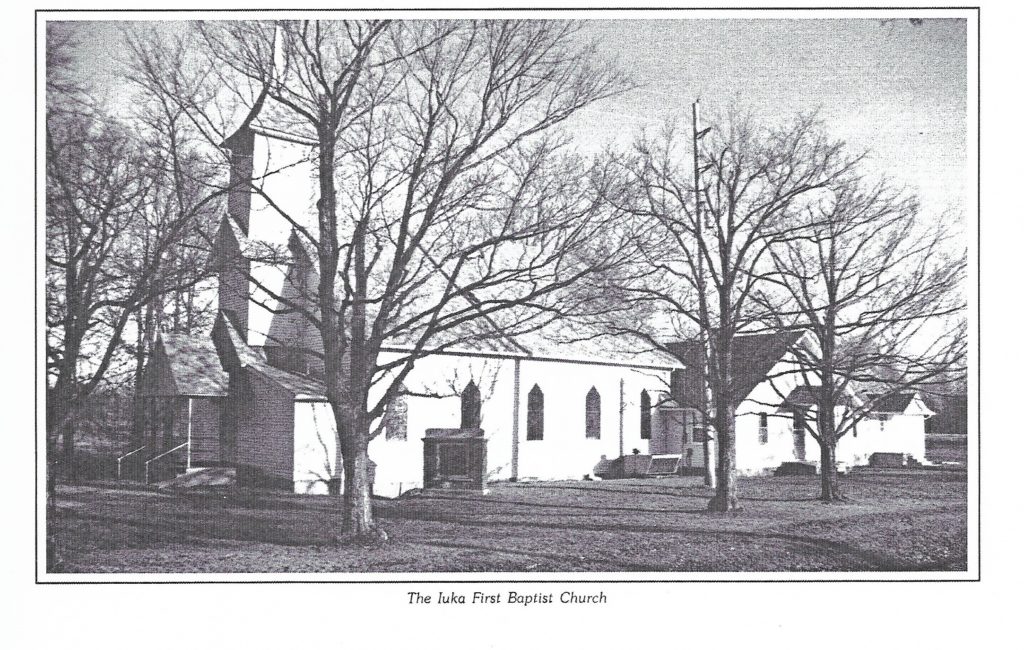
This church has nothing to do with the story. I just like the picture!
Muriel Dickerson - Interview
November 22, 2023
Every Piece of Land Has a Story
Medicinal Water Discovered Near Birdsville
November 17, 2023
By Lola Guess
In the year 1914, rain was hard to come by in Livingston County. Wells dried up, ponds and creeks ran dry. Such was the case on the farm of Mr. Edward V. Calvert which was two miles east of Birdsville and a mile and a half back from the Ohio River. Mr. Calvert was born in1858. His parents were N. B. Calvert and Sarah Reynolds Calvert. Edward and his wife Rosie were listed in Dyer Hill District 4 of the 1910 census. Ed’s occupation was listed as being a farmer.
Because of the drought in this area, Ed and Rosie Calvert needed to find a new source of water for their family and the livestock. Ed thought about the two springs only about seventy-five yards from his house that still had running water, but he needed a bigger flow. He placed dynamite in the larger spring and blew a hole that soon filled with water.
Mr. Calvert began using the water from the spring and soon began to notice that it had a laxative effect. When horses and cattle went to drink, they would turn away and only sip it. Ed had been told that the water no doubt had medicinal properties. Dr. Barney Markey told him to have the water tested. Ed sent a sample to the Kentucky Agricultural Experiment Station. The report listed the mineral contents and stated that it “was magnesium water and doubtless had laxative properties.”
Ed was elated. He felt the water was good for kidney and liver troubles because he had already benefited from drinking the water. He stated that others in his neighborhood had benefited as well. It was believed at the time that mineral water was good for torpid liver, biliousness, a purgative, sick headache, rheumatism, indigestion, and other ailments. The news spread and on one particular day there were fifty or more visitors at Mr. Calvert’s farm. Ed sold the water in jars and talked about blasting the spring again, building a hotel there, and opening a resort for the benefit of the county, state and elsewhere. The spring on the Calvert farm was said to be in a valley with high hills on both sides. The water ran over rocks and was clear.
I could not find any other articles about the spring other than the one dated August of 1914. Mr. Calvert died at the age of ninety-one and is buried in the Jameson Cemetery-1 in Burna, Kentucky.
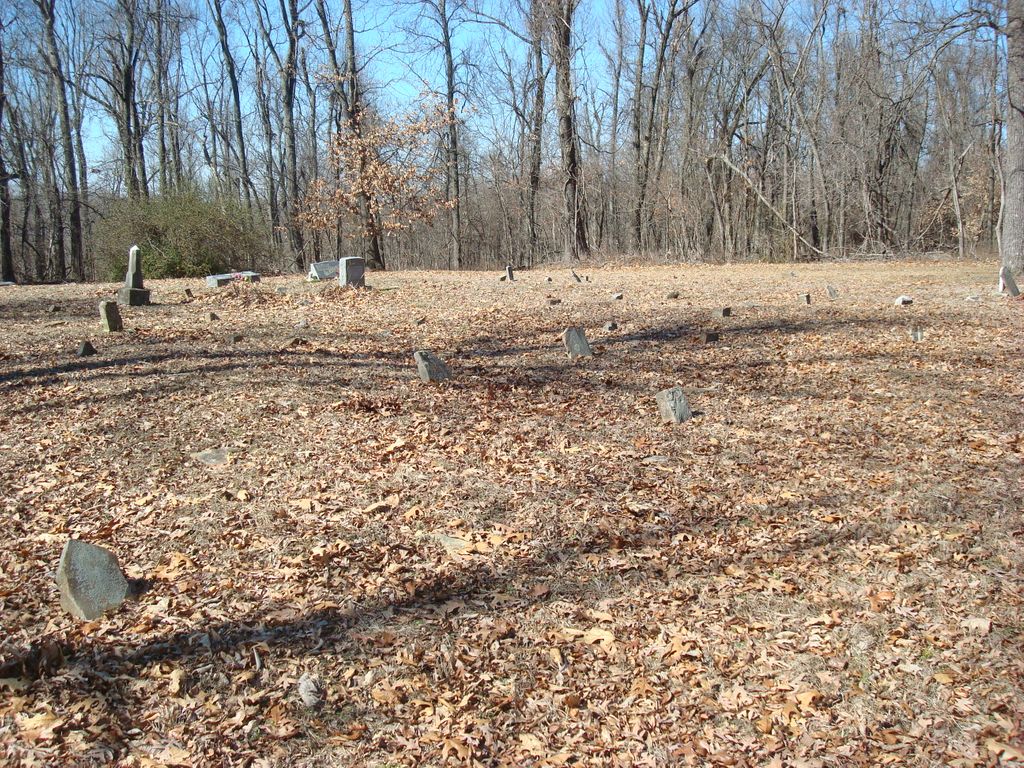
Dickie & Connie Berry
“Memories of Growing Up in Smithland, Kentucky”
By Dickie Berry
November 10, 2023
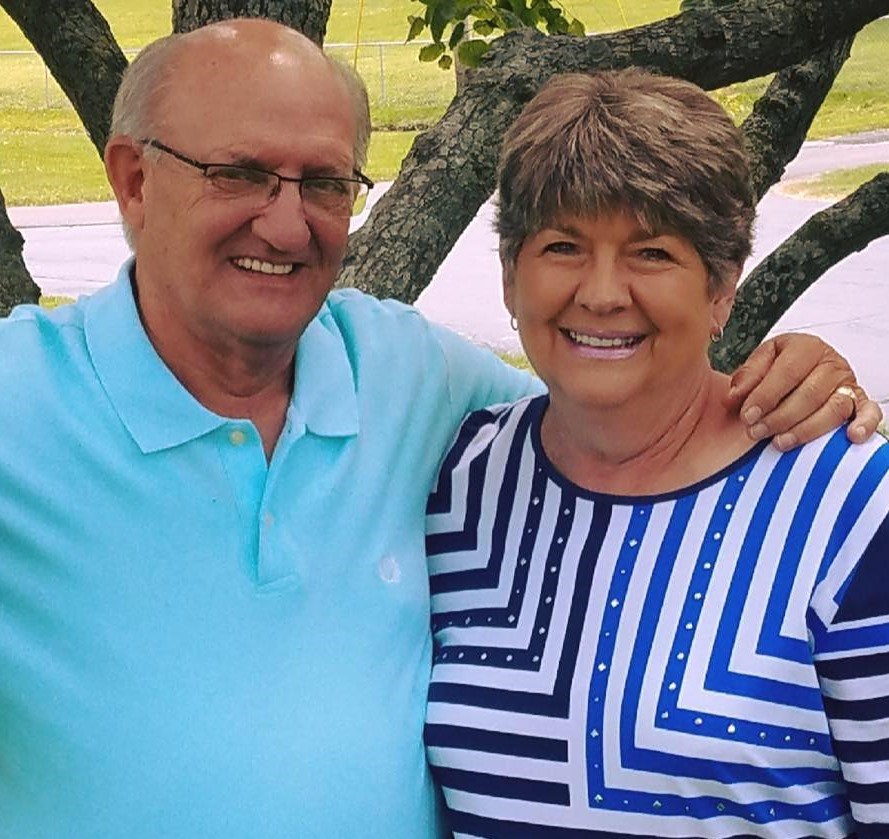

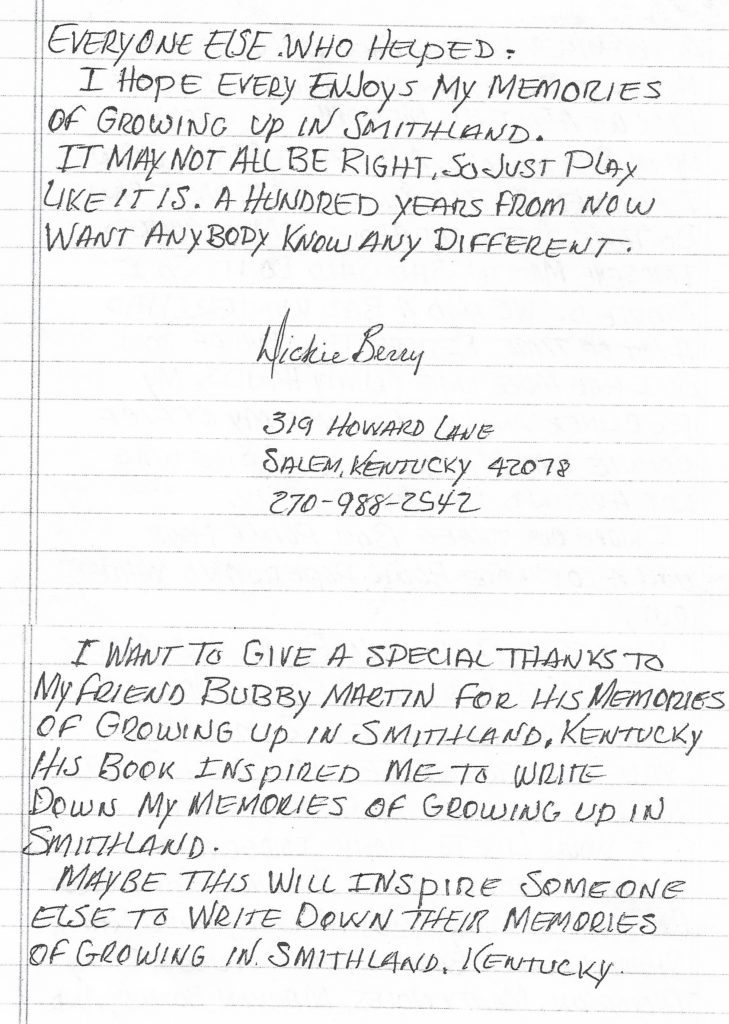
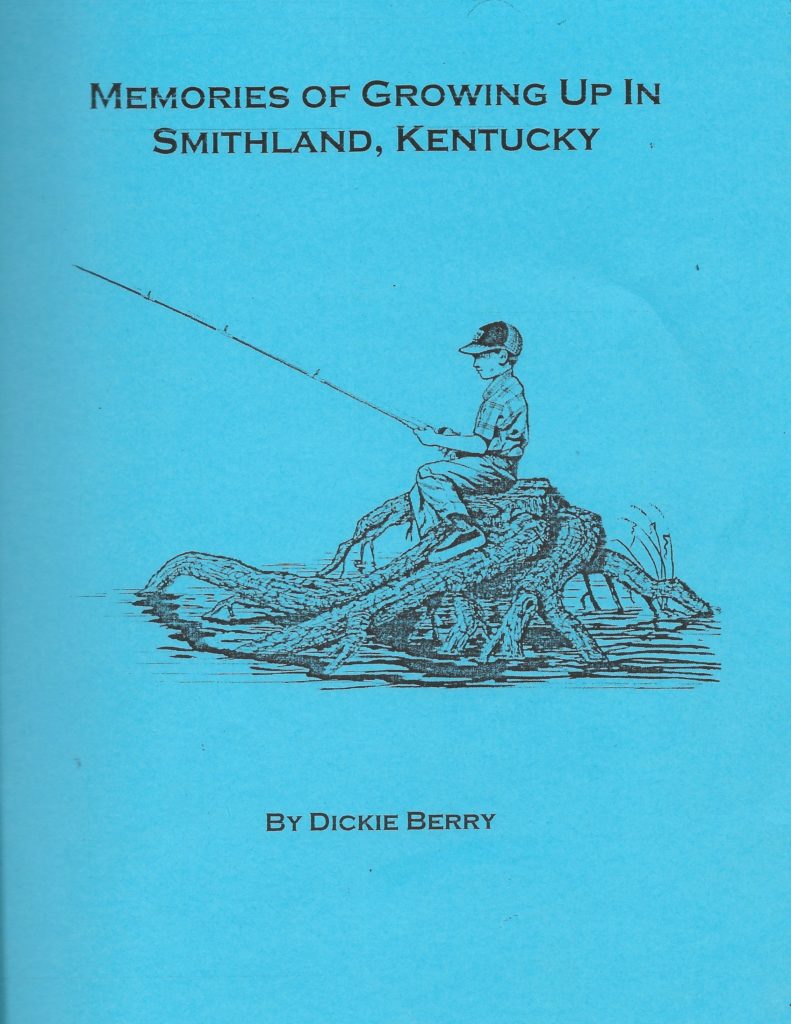
Contact the Livingston County Historical Society for your copy. Price $10.00
Sop it up with your biscuit!
Sop it up with your biscuit!
November 3, 2023
By Lola Guess
“Sop it up with your biscuit” is a term not heard much anymore. First of all, who has time to make biscuits and gravy in the mornings. Especially the big cathead biscuits that our grandmothers made. They were called cathead biscuits because they were as big as a cat’s head. After you finished eating, if there was any gravy left on your plate, it was perfectly acceptable to take your biscuit and “sop” up the rest of it. But then, if you wanted to add some sorghum and maybe a little home churned butter for a sweet treat at the end of breakfast, that was guaranteed to keep you full until dinner time.

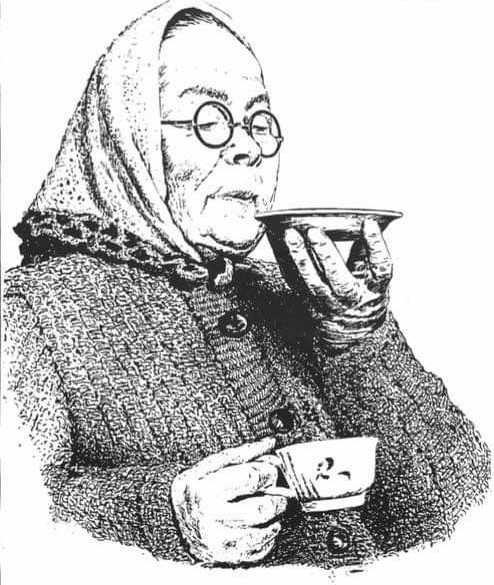

Then, there is the matter of drinking hot coffee. Did you ever see your grandparents pour a little coffee in the saucer, and blow on it and then “slurp” it up? That was perfectly acceptable too. First of all, who uses saucers now-a-days, and secondly now, it probably would be considered bad manners to slurp at the breakfast table.
When it was time for dinner (lunch now) you might sit down to a poke (polk) salad and crackling cornbread. Poke weed grows wild. It was cooked like any other greens. If there was no poke to be found, there might be some leaf lettuce ready in the garden. This was made into wilted lettuce which consisted of vinegar, salt, pepper, onions, and sometimes radishes with hot bacon grease poured over it until it was “wilted.” Crackling cornbread and wilted lettuce was the perfect combination. Cracklings are pieces of fatback that are cooked and crumbed into the cornbread mixture to give it a flavorful bacon taste. Dinner would be completed with beans and ham hock.



A glass or a mason jar full of buttermilk mixed with crumbled crackling cornbread might be all you would need for supper especially if relatives or neighbors were coming over to sit on the porch, pitch horseshoes, and make homemade ice cream. Although it took a while to hand crank the freezer long enough to freeze the ice cream, it was well worth it. When dark finally came, it was time for the kids to catch lightning bugs and finish up the day.

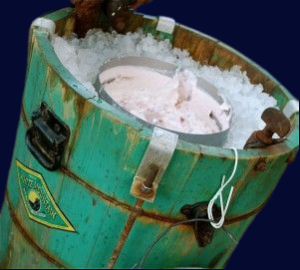

What memories do you have of food or entertainment back in the day? Going blackberry picking to make a cobbler? Shelling bushels of purple hull peas? Picking up hickory nuts to make a pie? Singing around the wood stove? Playing checkers?
McGrew Farms: 150 Years of Tilling the Land
October 27, 2023
By: Colton McGrew & Roger McGrew
The McGrew Family has a long history in Livingston County, dating back over 150 years. The Family arrived in America as part of the Scots Irish migration from Northern Ireland when Robert and Isabella McGrew stepped off a ship in Philadelphia in 1722. Over the course of the next century and a half, the McGrew’s moved around the back country of Pennsylvania and Kentucky before settling into Northern Kentucky in the years before the Civil War.
In 1871, George Newton “G.N.” McGrew and his wife Mary Elizabeth Rogers decided it was time for a change. The couple left their home in Spencer County and moved to Livingston County. Settling in Carrsville for a year, they were soon followed by G.N.’s brother Permanus McGrew, who became a banker in Carrsville. In 1872, G.N. and Mary decided to take up farming, moving a few miles down the river to a farm on the bluff above Bayou, then a prosperous port on the Ohio River known as Bayou Mills. Their newly begun farming operation produced cattle, wheat, and even an apple orchard. Continuing in the family tradition of innovation, G.N. employed the newest in farming techniques, eventually earning a place on the Kentucky Board of Agriculture.
After establishing their place in Livingston County, the couple soon welcomed three new additions to the family: their children Miller Almer, Joseph, and Georgia. Georgia eventually married Gus Edwards, a First World War veteran and Paducah businessman, and became a prominent local artist. Miller continued the family tradition, farming the family land and eventually moving into the family’s home upon G.N.’s death.
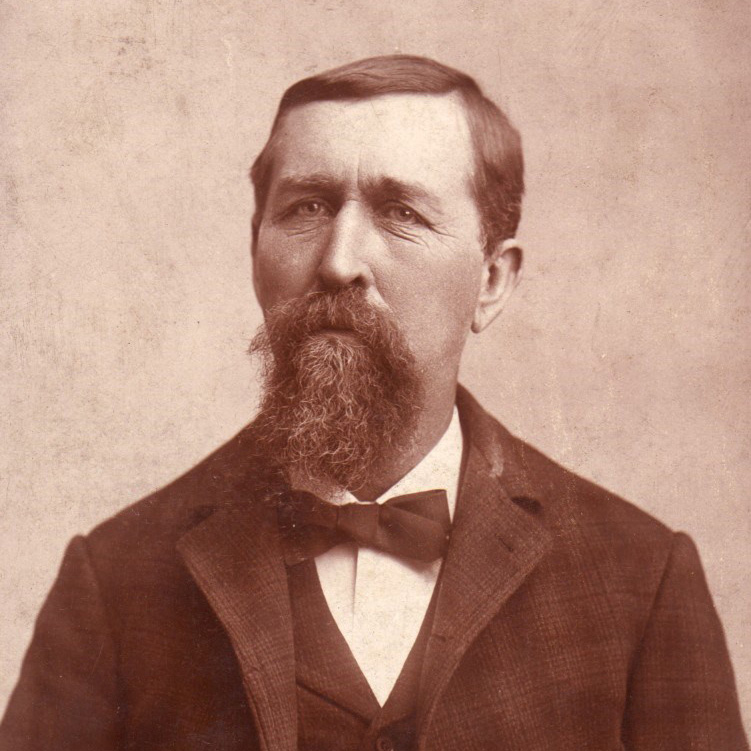
George Newton McGrew
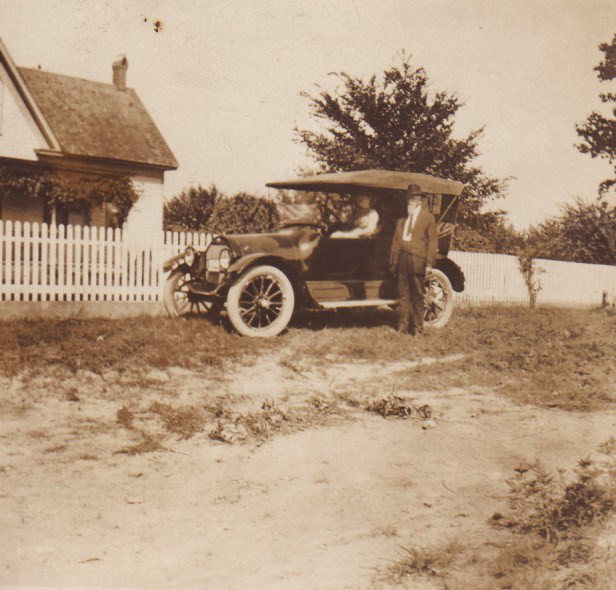
G. N. & Mary Elizabeth Rogers McGrew

Farm Service Agency Photo - Taken in the 1930's
In the 150 years since the McGrew’s arrival to Livingston County, the family has continued to farm the land, expanding the farm, and continued to innovate employing the latest in agricultural science. Miller eventually married Linnie Belle Nelson, bringing three more children into the family: George Nelson, Mark, and James “Jimmie.” All three of the boys spent their childhoods on the farm before serving in the Second World War. After the war, each pursued their own paths in life. Mark, always a wild character, eventually bought a Piper Airplane and taught himself to fly. George and Jimmie stayed on the farm and carried on the traditional career of the family.
George would have one son, Roger, who embarked on a career in computer technology before retiring to return to Paducah. Jimmie would have two children: Carolyn, born about the same time as Roger, and Jeff, born later in 1960. Jeff had a successful career ranging from general contracting right out of high school, to a businessman operating a farm store in Smithland, and finally taking up the family tradition farming the land. After Jeff married Patty Croft, the fifth generation would arrive at the turn of the century: Colton and Masa.

Miller & Linnie Belle Nelson McGrew
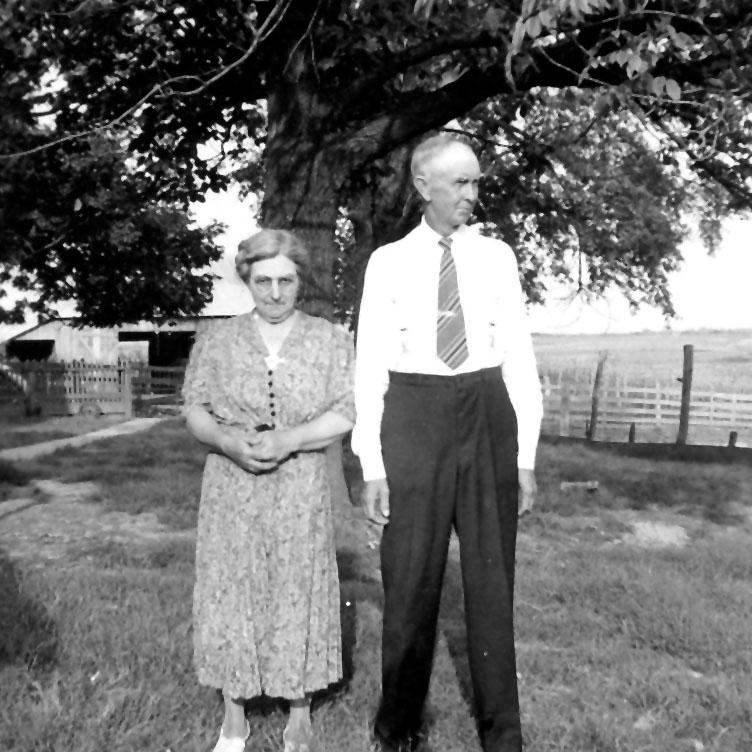
Linnie Belle Nelson & Miller McGrew
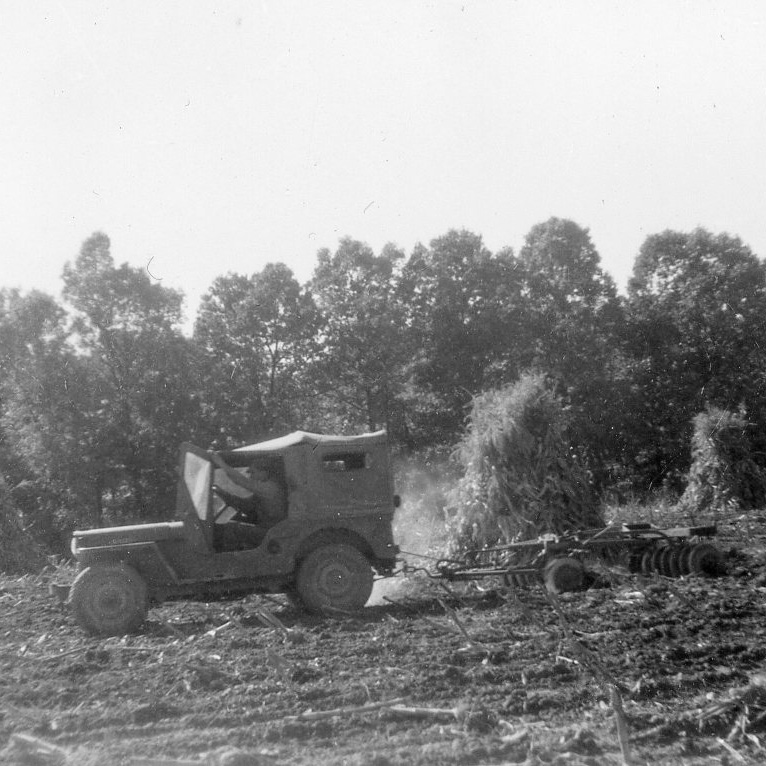
Disking with Jeep
Today, Jeff and Patty continue the old profession of the family, raising corn, soybeans, wheat, and hay on the family farm. Masa and her husband, Taylor Champion, raise cattle with Jeff and Patty. Colton is currently pursuing a law degree in Nashville, Tennessee. Roger and Carolyn live in Paducah and frequently visit the old family lands.
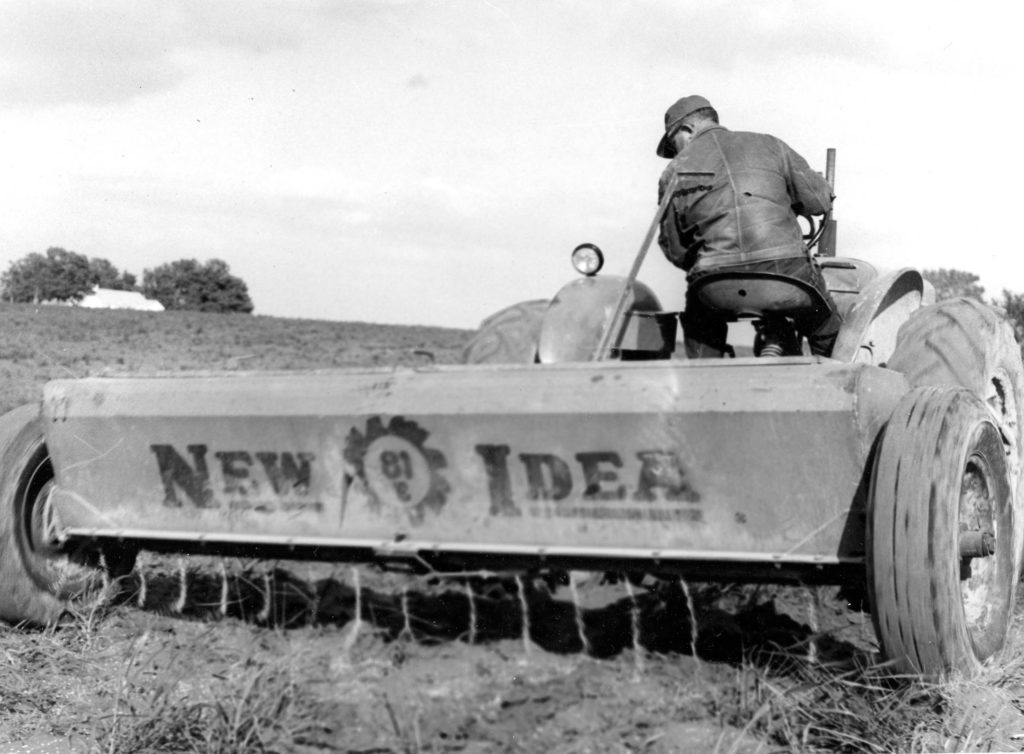
George Nelson McGrew
Eugene Trimble
October 20, 2023
By Lola Guess
Recently, the Historical Society was honored to have Mr. Gary Trimble visit the Historical Society and tour the museum as well as other places in Livingston County. Mr. Trimble and his wife are both attorneys living in Las Vegas, Nevada. Gary’s father is Mr. Eugene Trimble of McKinney, Texas.
Eugene Trimble was born on April 28, 1922, in a log cabin near Joy, Kentucky. His parents were Foster Oliver and Lura Ellen Shouse Trimble. Both are buried in the Bethel Cemetery in Joy. The family also included a brother, Glenn Allen, and a sister, Lou Ellen. When Eugene was thirteen years old, the family moved to Smithland. Eugene graduated from Livingston High School in 1940 (picture on Facebook with his graduating class) and later attended Draughon’s Business College.
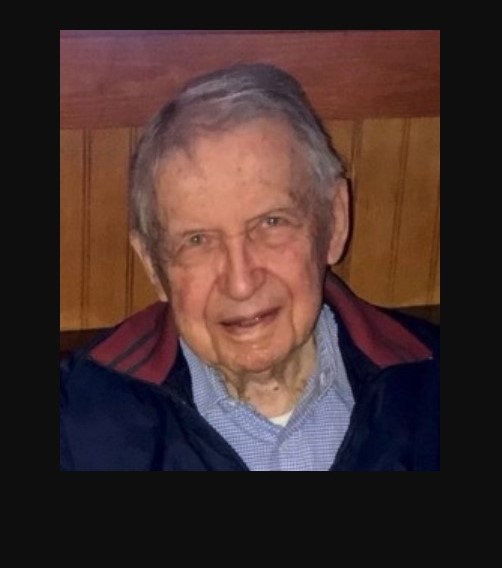
Two years after graduation, Mr. Trimble went to Washington D. C. to work for the FBI. In 1943 he was drafted and served three years with the 94th Infantry under the command of General George Patton. Soon the Army recognized Eugene’s ability to type 83 words a minute. He was assigned to the battalion office at a command post in Pilsen, Czechoslovakia, and later as an accountant in Bamberg, Germany. After being discharged from the army in 1945, he returned to his FBI job as a fingerprint analyst. He then learned about the GI Bill and enrolled at George Washington University, Washington D.C., and earned a degree and a CPA certificate. He married Betty Owen, from Vilonia, AR, in 1950. They had two children, Gary Allen, and Janet Lynn.
From 1950 to 1996, Eugene worked for the W. D. Campbell Furniture Company. He began as a company accountant and owned the company when he retired in 1996 and moved to McKinney, Texas, to be close to his grandchildren.
After 69 years of marriage, Betty passed away on July 6, 2019, at the age of ninety-three. Mr. Trimble recently celebrated his 101st birthday. He maintains a website, www.eugenetrimble.com, containing photos of Livingston County as well as personal historical accounts.
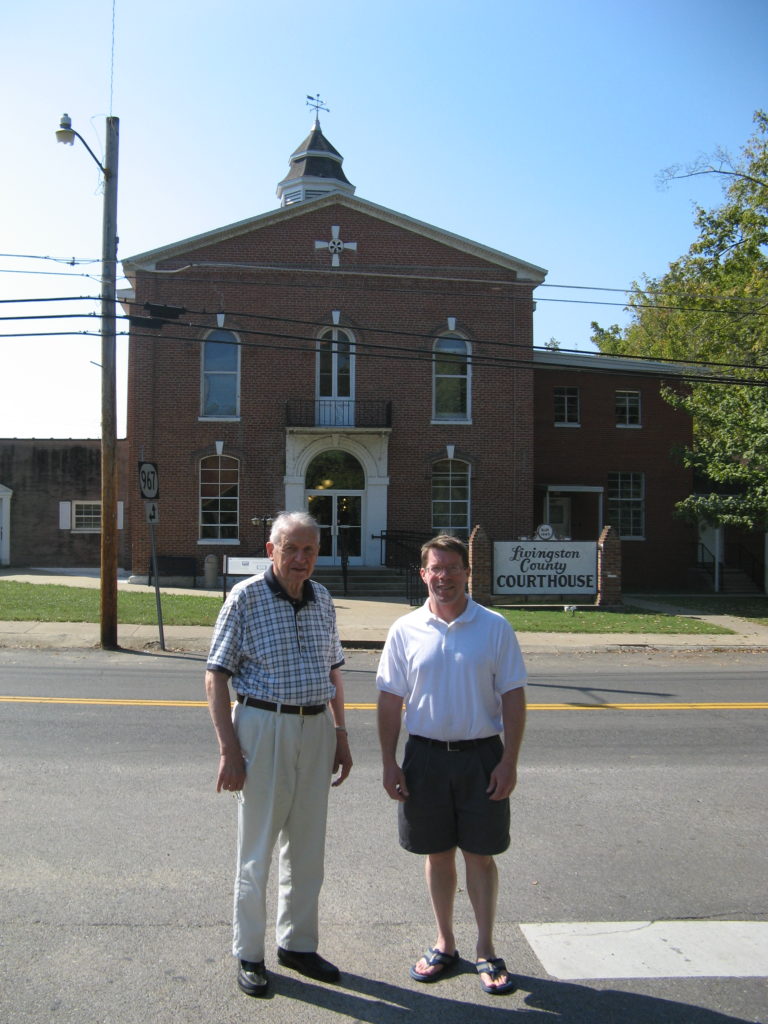
Eugene & Gary Trimble
Smithland, Kentucky

Come with me to Burna!
October 13, 2023
By Lola Guess
Burna, Kentucky, was established about 1890 and grew into a busy town in the first half of the 1900’s. There were grocery stores, blacksmith shops, auto repair shops, churches, farm stores, auction barns, and feed stores to name a few. On September 1st, 1936, the Paducah Sun-Democrat reported “three thousand persons attended the annual home coming picnic here Sunday.” Burna was also home to a successful baseball team in the 1940’s.
September 2, 1946
Paducah Sun-Democrat
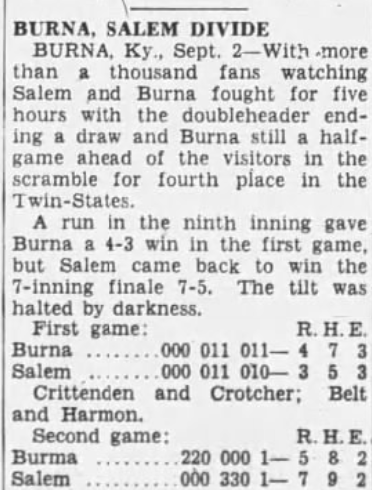
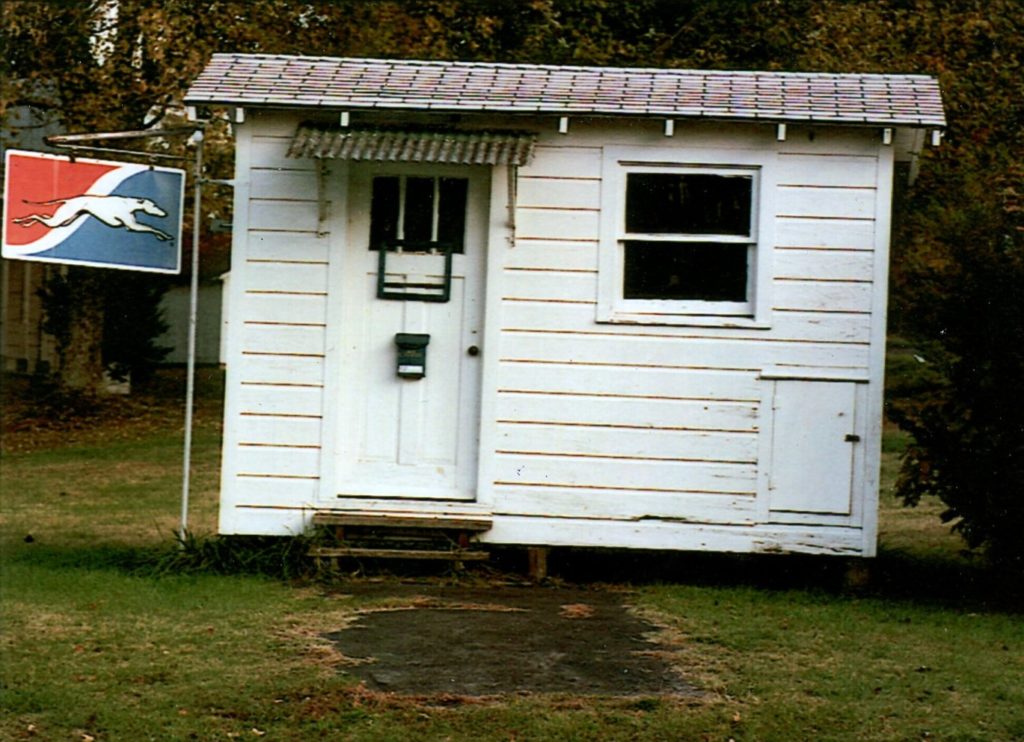
Burna Bus Stop
The Burna Bus Stop was the smallest Greyhound Bus Station in operation and is still standing.
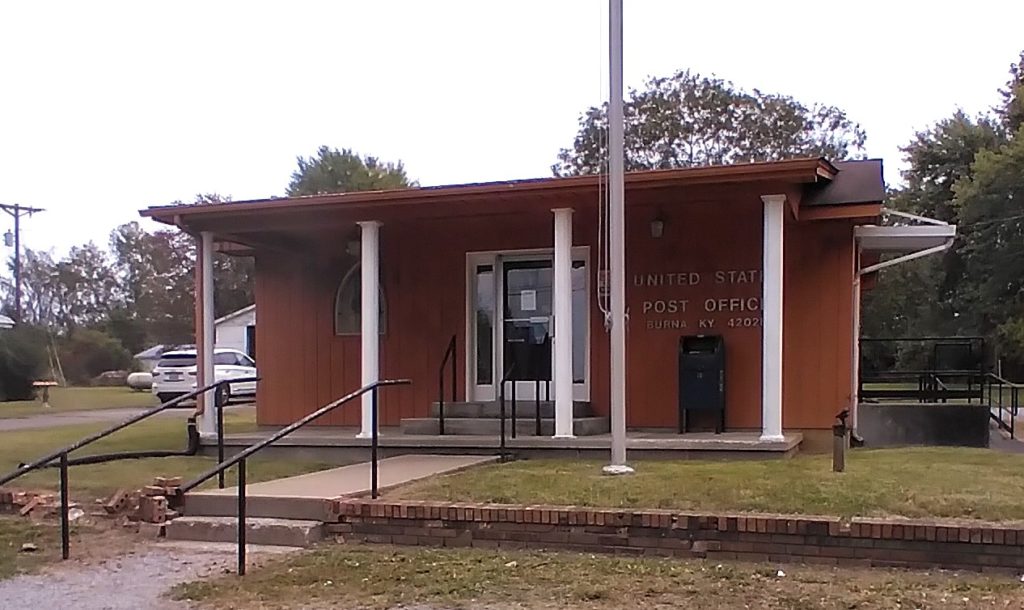
Burna Post Office
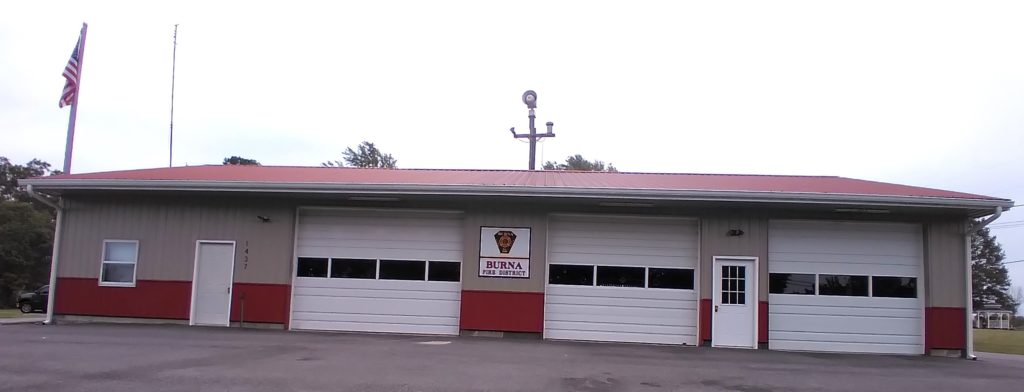
Burna Fire Station
Muriel Dickerson
October 5, 2023
By Lola Guess
“I loved my life. We knew how to work and God provided for us.” These are the words from Muriel Dickerson about her life of 102 years. Mrs. Dickerson also said she still has a lot of living to do and is enjoying every day of it. The Smithland Octoberfest on Saturday, October 7th, will host a parade with Mrs. Dickerson as Grand Marshall. Mrs. Dickerson said she is looking forward to it and all the people she will see.
Muriel Wilbanks was born on November 26, 1920, to Nell and Clarence Wilbanks. There were nine children. Muriel walked to school every day and the first school she attended was Lick Skillet followed by Blooming Rose School, Pleasant Grove, and then grade school in Livingston County. Muriel married Claude Thomas Dickerson on September 18, 1937. They were married at the Smithland Courthouse by Judge George Heater. Claude and Muriel had five children, Glenn Dickerson, Beulah Holt, Bonnie Hosick, Lesia Ruschmeyer, and Charlotte Belt.
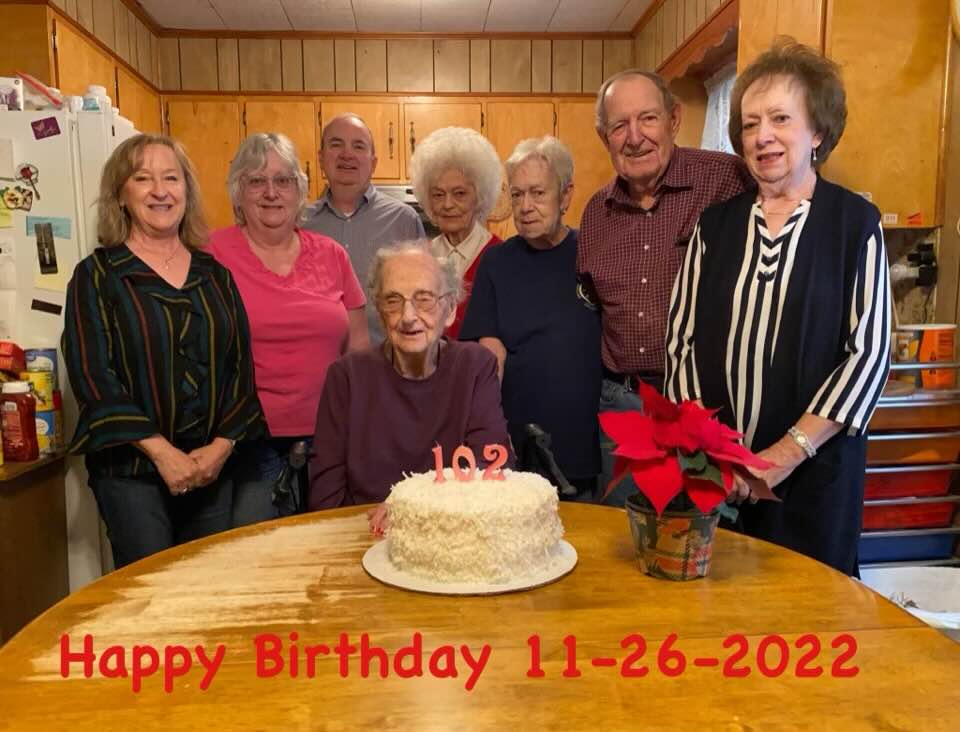
Mr. Dickerson (1907-1999) was a schoolteacher and PVA officer for Livingston County for forty years. Muriel worked as deputy PVA for several years and without pay. They worked out of their home until 1950 when they moved to an office in the Court House. Mrs. Dickerson stated that she loved “staying at home, taking care of my family, quilting, gardening, and canning.” She taught Sunday School at Old Salem Baptist Church and was active in the PTA when her children were small. She said, “I loved listening to older people when I was young. They taught me how to card cotton, make rag rugs, quilt, and do it right.”
Mrs. Dickerson attended the dedication of the new Jim R. Smith Memorial Bridge in Smithland on May 15, 2023. She also attended the dedication of the old Lucy Jefferson Bridge in 1931. An event occurring ninety-two years apart. The parade in Smithland begins at 1:00 p.m. Look for Mrs. Dickerson as she leads this year’s parade.
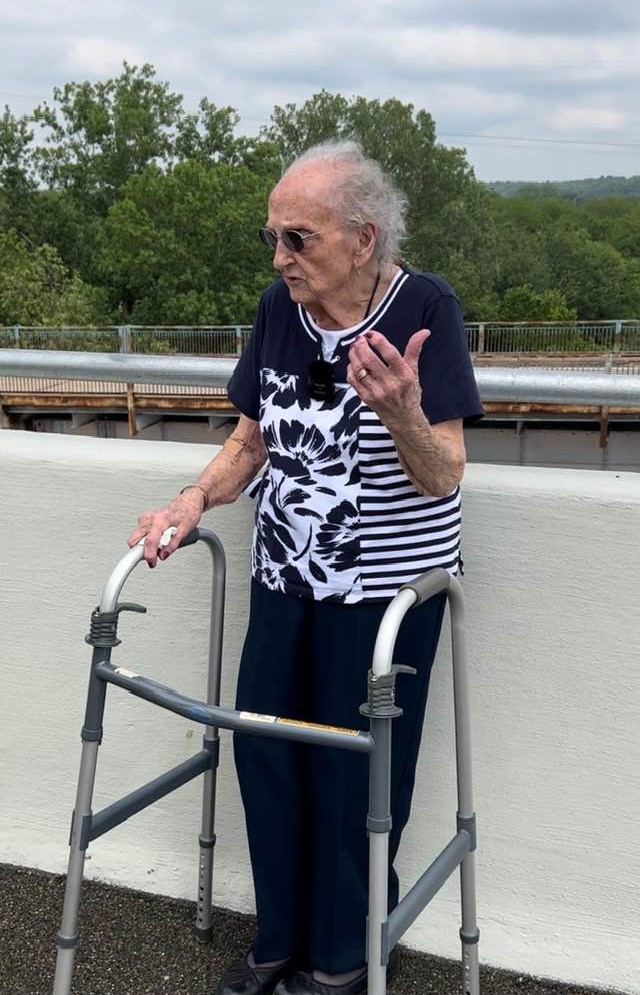
Did You Ever Ride a Mule?
By Lola Guess
I have not posted any stories the last two weeks because I spent a week in the hospital with Covid and pneumonia. This past week I have been recovering at home and I have watched TV probably more than I needed to. Gunsmoke is one of my favorites. Festus and his mule “Ole Ruth” can solve all the problems in Dodge City. Have you ever ridden a mule? Did your grandparents or parents break up the garden with a mule?


When settlers first came to Livingston County, they needed a mule, a plow, and a simple harness to put out a crop. Farmers relied on corn, tobacco, and hay to survive. Kate and Julie seemed to be popular names for a pair of mules. They were used instead of horses because mules were stronger, had more stamina, ate less, and lived longer. Farmers used “gee” and “haw” which is right and left to turn the mules. “Gee-haw” together meant straight ahead and of course “whoa” meant to stop. Mules teeth were checked to determine age. Census takers even listed the number of mules in the household on census reports. Then there is the fact that mules can be contrary. Mules can plant their feet in the dirt and balk and bray and there is not much anybody can do about it.
The lowly mule cannot be discounted. At the end of the Civil War the freed slaves were offered forty acres and a mule, which was a failed promise. Later mule trains settled the west by carrying loads of cargo over the mountains and into the mines. Mules have played a big part in winning wars throughout history by transporting weapons, food, and supplies to places not accessible by any other means. The “Crittenden Press” reported that 1000 mules and horses were in Marion on Mule Day in 1906 with the average price ranging from $75.00 to $100.00.
Trail rides have always been popular in Livingston County. Mules are better suited for trail rides because they are more sure-footed than horses. Tiline residents, Barnell and Alice Doom, enjoyed trail riding along the beautiful trails and roads in our county. (Barnell passed away in July of 2020.) These pictures of Barnell and Alice on their mules allow us a peek into their adventures.



Breakdown at the Buzzard Roost
The video was recorded by Norwood Wright on June 7, 1991, at Smithland, Kentucky.
Livingston County Churches
Livingston County Churches” by Linda Phillips Fox. Spiral bound. Published in 2023 by Livington County Historical Society. $15.00 plus $4.50 shipping. The book contains stories and pictures of churches in Livingston County both past and present. Excellent for Christmas presents and those researching the County.
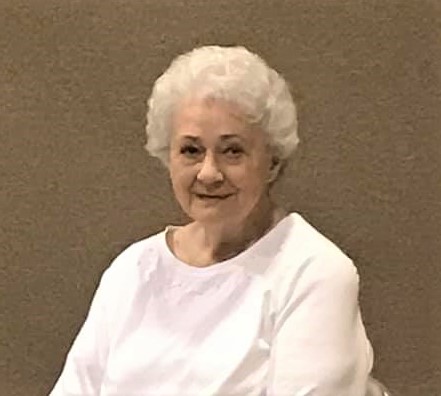
“
The following is an excerpt from the book about Good Hope Baptist Church.
“Good Hope Baptist Church was organized in 1842. There was a meeting at the Mount Pleasant Meeting House on April 30 and May 1 of 1842. It was at this meeting that Good Hope Baptist Church was organized in the presence of Elder William Bandean, James W. Mansfield, and Joel E. Grace. They represented the United Baptist Association of Livingston County.
The church was built with nine members, one being a black woman. Joel E. Grace was the first pastor.
In 1882 the church known as Old Good Hope moved to a site near the Hampton and Joy Road on Hwy. 135. In 1962 the old building was torn down and rebuilt. Bro. Z. M. Downs was pastor at that time. Other pastors have been Rev. James Sullenger, Rev. Will Ed Nance, Rev. Buddy Keeling, Rev. Virgil Diel, and Rev. Mike Templeton.”
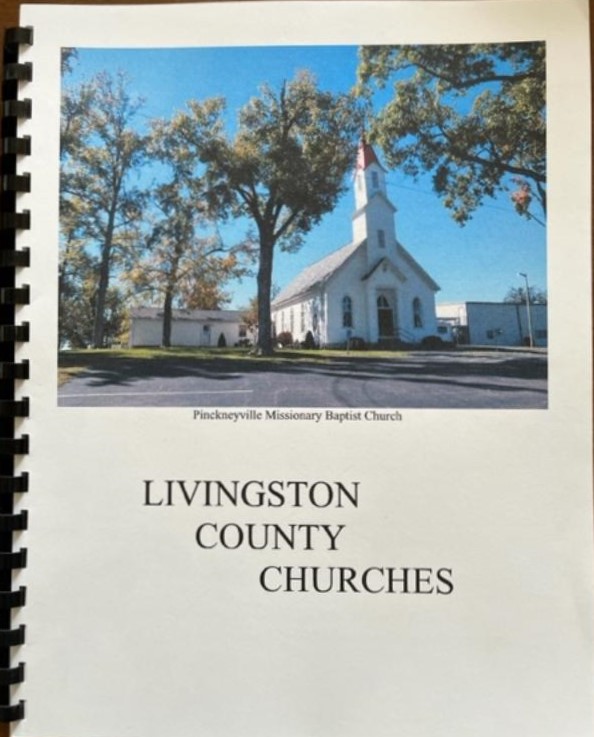

Renovation of the Old Livingston County Courtroom
By Justice Bill Cunningham
August 25, 2023
The court room in Smithland was built in 1845 – the same year Andrew Jackson died. One can still see it today, as it remains as a museum in the hands of the Livingston County Historical Society. There was no air conditioning, and at one time it was heated mainly by a large pot-bellied stove in the corner. A rope came down through the ceiling right behind the jury box. It led up to the bell in the cupola atop the courthouse. Each time court was convened, the one-armed jailer, Orville Cox, would ring that bell as the bailiff announced the opening of court and the judge took the bench.
Trials in the summer were insufferable. In a double murder case, I prosecuted one blistering August week, I lost 15 pounds. The judge’s office was located all the way to the rear of the court room and was falling apart. One day I heard a scratching above my head as I was working at my desk. I looked up and saw the bottom of the feet of a pigeon on the plexiglass covering the neon lighting.
But we soldiered on, thinking that we were not really any different from the lawyers and judges plying our trade in the other 119 court rooms throughout the state. By the early 1990’s, the 150-year-old court room in Smithland had become unsightly and dark. It was still serviced by the original wiring that had first brought electricity to the building. I finally had enough. One day I brought an old fashion oil lamp from home and mounted it on the back wall and lit it. I took a picture of it and sent it to the Chief Justice with this cryptic message: “We are the only court room in Kentucky still lighted by oil lamps.” It was for a demonstrative purpose. But I was tempted to keep it. The lamp actually helped.
The picture did the trick. Almost immediately plans were made to rewire the whole courthouse. Now that we had Frankfort’s attention with the lamp trick we decided to push forward with a total renovation of the old courtroom. In that historic old courthouse, the office shared by the judges was off to the right after one entered the front doors to the court room. It did not have access to either heating or cooling. Thanks to County Judge Executive Joe Ward, that changed.
Joe was made a quadriplegic from a car accident. He heroically moved about in his motorized wheelchair and with the loyal assistance of his wife. I admired them both greatly. He had a gas heater installed in our judge’s office for winter comfort, and a window unit air conditioner for the summer. I was very grateful. At some point, the knob was lost off of the AC. So, I went to the
Dollar General and purchased a cheap pair of pliers with which to operate it. When I passed the gavel to my successor, Judge Woodall, I also handed over to him those pliers.
The much more far-reaching improvement Joe Ward did for the court facilities was the installation of a much-needed elevator. Up till that point, the sheriff deputies had to pack crippled people needing access to the courts up the long flight of steps. In many instances if the person was a witness, or even a party, the court would try to accommodate them by moving a hearing downstairs somewhere.
Tinker Lister was the courthouse custodian and janitor. One afternoon he came to my office and inquired if court was finished for the day. I assured him that it was. “Okay,” he said, “I will cut off the elevator.” This piqued my curiosity. “You mean you cut the elevator off at night?” I inquired. “Yes,” answered Tinker. “If you don’t people from town come over here at night and ride it.” Indeed, not much to do in Smithland when the sun goes down.”
This is a condensed version of an article Justice Cunningham wrote about the old and the new courthouse. In the interest of space, the timeline about the new courthouse was not included. If you would like to read the complete story, please contact us and we will email you the entire article.
Judge Cunningham still presides over the courtroom in Smithland. Livingston County artist, Dana Kolb, created a life-sized mannequin of Justice Cunningham. Judge Cunningham donated one of his robes to dress the mannequin. Visit the museum and see Justice Cunningham in the courtroom!
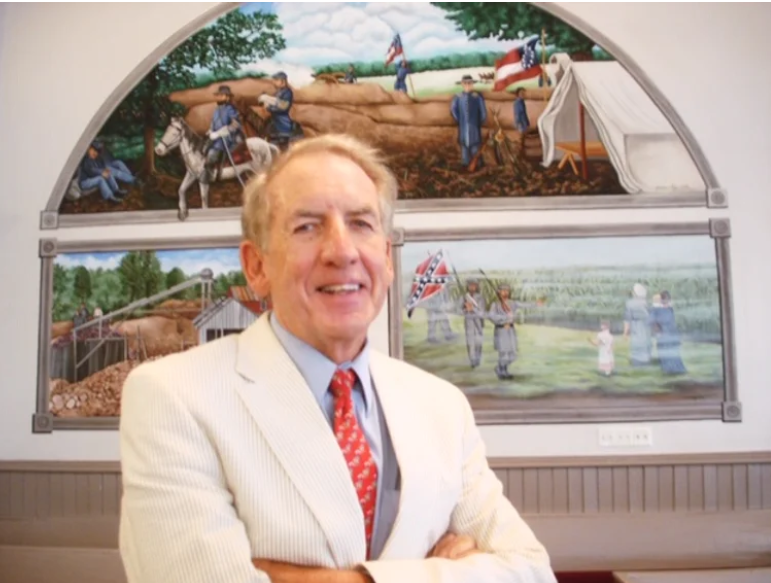
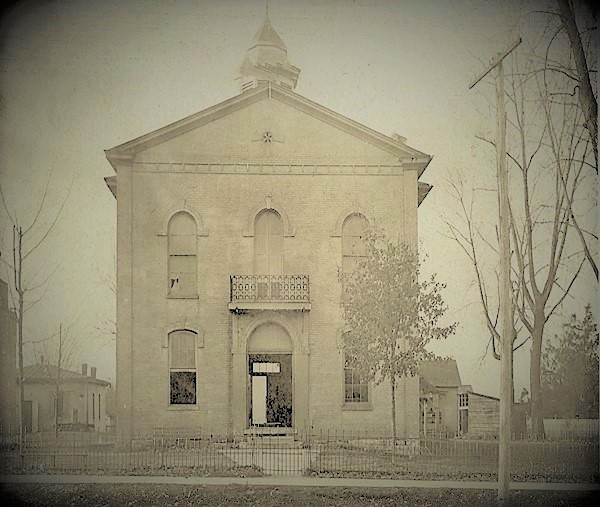
Discover Historic Carrsville
August 18, 2023
By Lola Guess
As I drove through Carrsville, I could see a busy river town in my mind. Many of the old homes and landmarks are still there, some beautifully restored, some forgotten. Carrsville is peaceful and calm on this sunny day in August. The river is a beautiful sight. This story doesn’t provide a lot of information. Only a few facts. Enjoy the scenes of unique Carrsville.

Stanley Walker
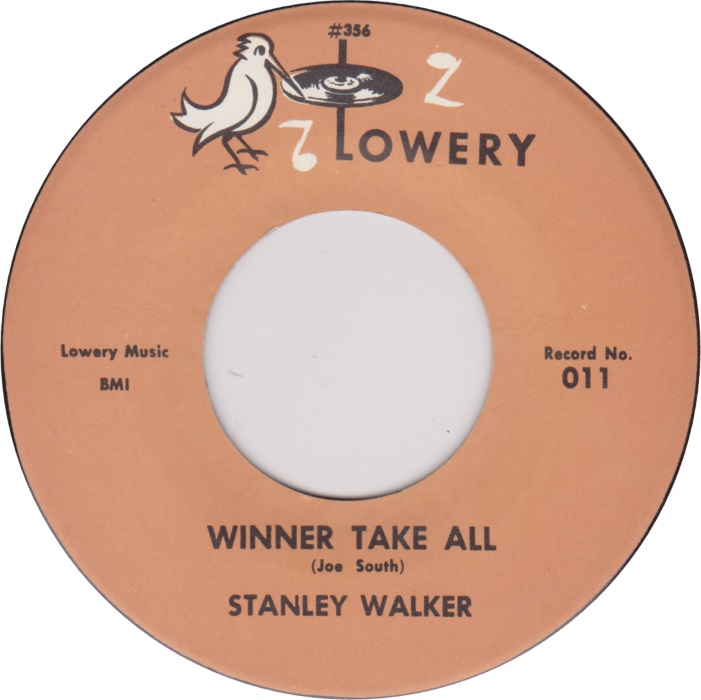
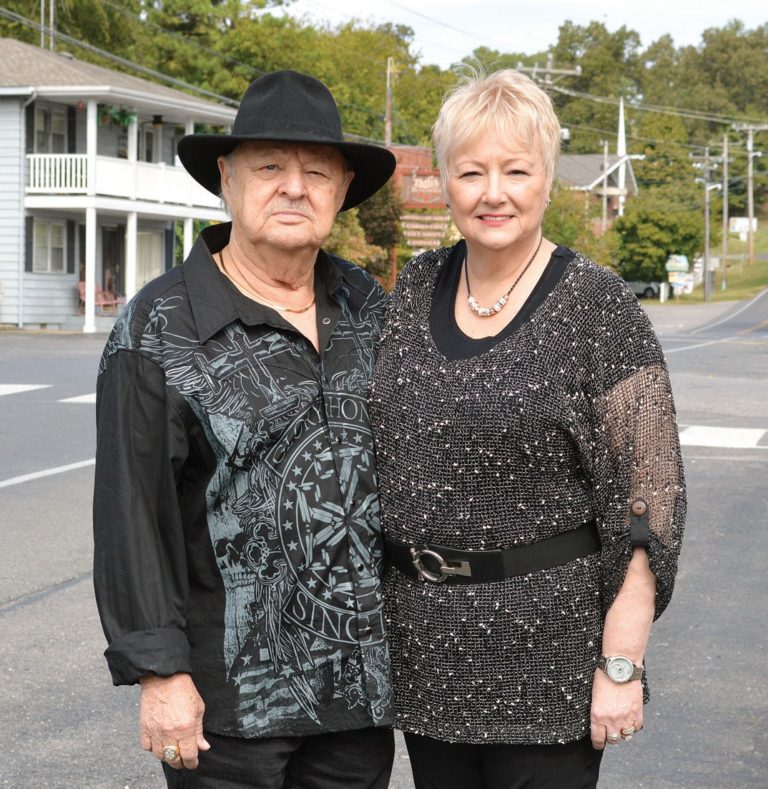
Stanley & Kay Walker
August 11, 2023
By Lola Guess
His voice has been described as deep, soulful, and emotional. His guitar picking is incredible. His is Livingston County’s own, Stanley Walker. Stanley began picking a guitar at the age of six. First in his career, he played with gospel singers Dottie and Bucky Rambo. At the age of 17 he joined Melber native and country music star Ray Smith’s band. He auditioned in a skating rink in 1956 in Metropolis, Illinois, for Smith and spent the next thirteen years with him touring and recording. He earned $3.00 a day on this job. Walker was lead guitar on Smith’s 1961 hit “Rockin’ Little Angel.” Walker worked with other legends of country music such as Jerry Lee Lewis, Lefty Frizzell, Hank Williams Jr., and Roy Clark. He toured with country star Jean Shepard and appeared on the Grand Ole Opry and was on the popular TV show HeeHaw.
Stanley quit life on the road in 1985. He had had enough of riding on a bus. He came back to settle in his home in Livingston County with his wife, Kay. Earlier in his career, Stanley was a popular attraction at the Time Out Lounge in the Executive Inn, the Cabana Club, Continental Inn, and many other venues. After a decades-long career, he remains popular and is sought after to play and sing with his band around the area. Grand Rivers, Kentucky, sponsors “Stanley Walker” day where he performs at the Badgett Playhouse to raise money for Kosairs Charities. This video shows his extraordinary guitar-playing ability and his amazing voice. Stanley Walker recently celebrated his 84th birthday.
The Livingston County Historical Courthouse Museum is proud to have a display featuring items Stanley has donated to the Museum.
The Day the Bull Went Berserk
August 4, 2023
Reprinted from the Livingston Ledger
Published in the Mid 1970’s
A bull which escaped slaughter at Smith’s Meat Processing Plant attacked and injured Mrs. Velda Johnson and her daughter, Faye Johnson, who reside at Wilson Avenue. Tuesday morning Mrs. Johnson suffered lacerations and bruises as we go to press. Her condition is considered fair at Western Baptist Hospital in Paducah. Miss Faye Johnson was knocked down but suffered no broken bones.
The bull was one of the new mixed breed of Hereford and Angus, bred for stamina. The owner, Raymond Phelps of Fredonia had warned that he was extremely dangerous. It is the practice of Smith’s to shoot such animals in the truck they come in, according to Ralph Smith.
Ralph Smith did not think this bull looked too dangerous. They decided to unload him. Noticing that the truck wasn’t backed in the platform too straight, the bull broke through the loading chute and darted at Ralph Smith. He escaped and ran to the top of Cemetery Hill.
Billy Downs was mowing the cemetery lawn when he saw the bull pawing and snorting toward him. He left his mower in panic and sprinted away as fast as he could. The bull went back down the hill to Mrs. Johnson’s back yard.
There, they were having a cookout. The bull charged Mrs. Velda Johnson and Miss Faye Johnson. Several tried to rescue the elder lady and she was rushed to the hospital immediately by the Livingston County ambulance.
Ralph Smith went downtown in Smithland to warn all elderly women who were calmly visiting with one another to take cover, but no one seemed to realize the gravity of the situation.
Meanwhile the bull took “rounders” on the Long Farm and made for Highway 60. Smith’s men tracked him to the cemetery and soon spotted him. “Little Jug (Neville) Robertson kept shooting him.
After the mad bull had been shot about a dozen times, he was still wild. He rammed his head in the grill of Deputy Encil Johnson’s truck and left a swath of skin and hair deep in the grill. He tried to get at the radiator.
Then the mad bull attacked a woman in a station wagon, almost upsetting the car, but she speeded up and escaped him. This tourist will remember Smithland!
“Little Jug” pumped about three more shots into the bull before he was killed. He has been skinned and will soon make some gorgeous steaks!
Epilogue: Written by Billy Downs:
July 24, 2023
I will never forget the incident! The writer apparently didn’t interview me before publishing the story. My encounter with the bull did not happen as reported.
I was using a push mower, heading uphill parallel with the road, below the Branstetter lots. Suddenly I was hit in the back and knocked to the ground. I did not hear the bull coming because of the noise of the mower’s engine. I was shocked.
I picked myself up and saw the bull continuing up the hill at a run, kicking up his heels and bucking like a rodeo animal. My stunned reaction wasn’t very rational. I was instantly indignant and furious. I took off after the bull, yelling in anger. When he turned back toward me, I realized my mistake and stopped running toward him, but I continued to yell. I didn’t realize that the animal was unusually crazy. For some reason, thankfully, he turned back toward the top of the hill and ran onward, still occasionally kicking up his heels.
After a short time, Ralph Smith came driving up the hill. I told him what had happened, and he asked if I was okay. I learned later about the Johnson ladies and their encounter with the bull. Things were certainly a lot more exciting and lively in Smithland in those days!
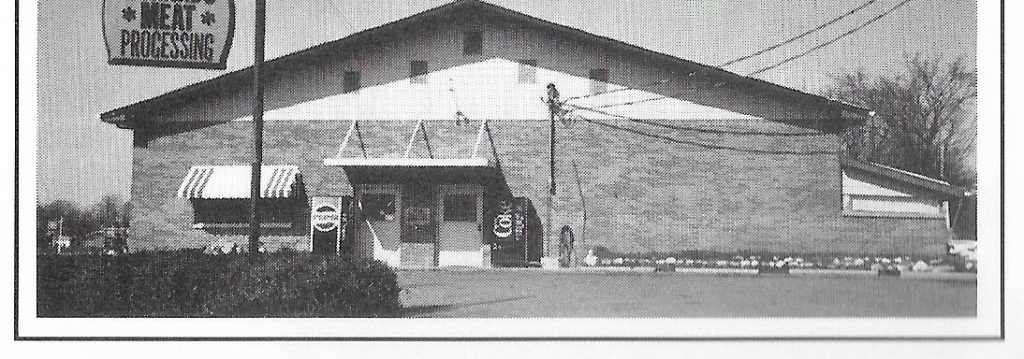
Ralph Smith's Meat Processing Plant
Norris McElmurry
The Backwards Relleps
July 28, 2023
By Lola Guess
Jay Leno with the “Tonight Show” once contacted Norris McElmurry and asked if he would fly to California and be on the show to feature his backwards spelling. but Norris declined. He was a simple man, lived a humble life in Burna, and was loved by the community. He was a high school graduate, a self-employed painter, a deacon of North Livingston Baptist Church, and a bible scholar. Norris lived in a ninety-year-old house with no indoor plumbing. He never had a phone, never married, and never drove a car.
Norris McElmurry had an incredibly special talent. He could spell words, phrases, and sentences backwards without hesitation. The Courthouse Museum is certainly fortunate to have two well-studied dictionaries belonging to Norris on display. Norris stated the longest word he could spell backward was a 45-letter word which is the name of a lung disease, and he could also spell “supercalifragilisticexpialidocious” (from the Mary Poppins movie) backward which is a thirty-four-letter word.
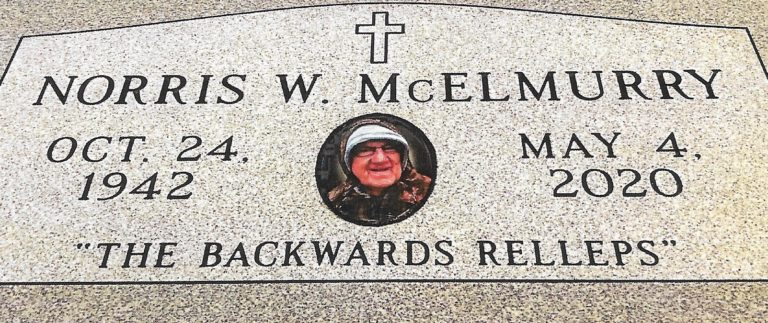
In the interview, he went on to tell that he gave up working at the radio station because he had to hitchhike to Paducah. He walked a mile or so to Burna most days to meet with his friends. Neighbors picked him up twice each week and took him to church. Although he was well-known in Livingston County, he remained true to himself and his faith his entire life…another Livingston County treasure.
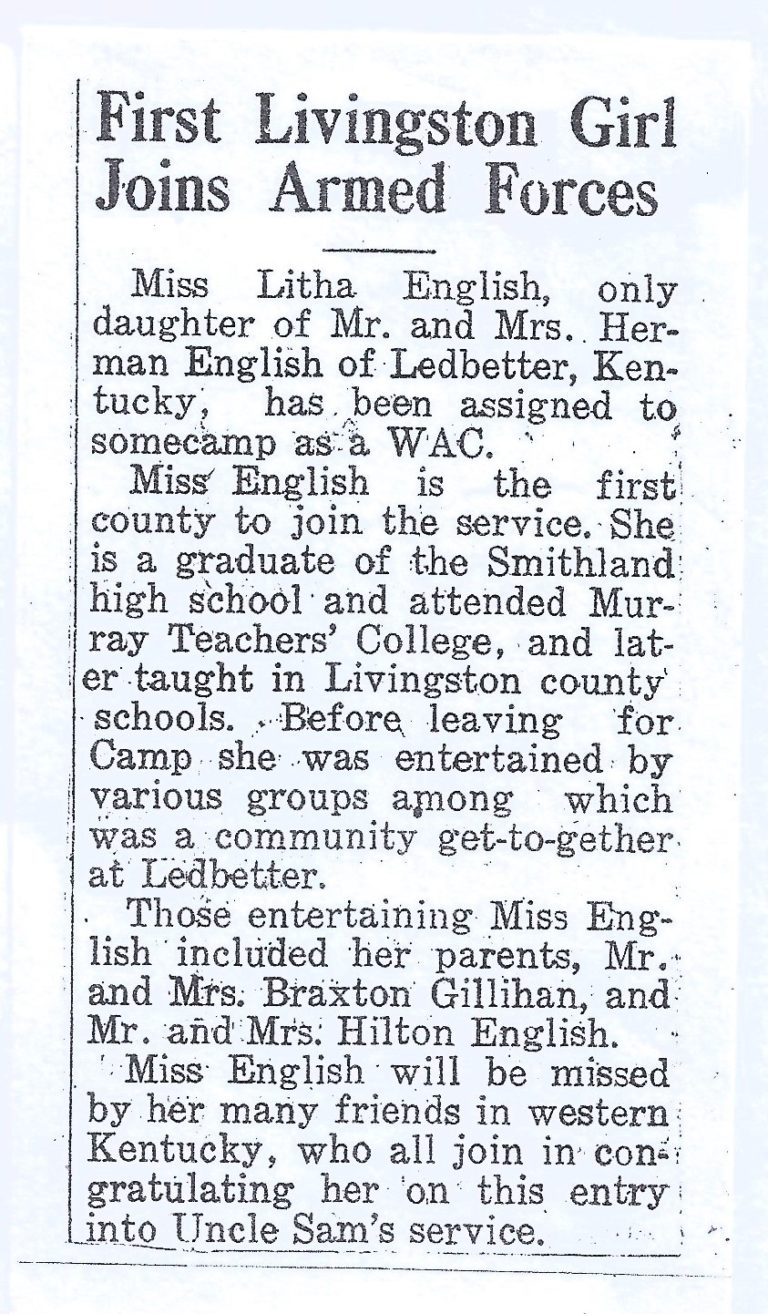
Litha Lavannia English Bass
July 21, 2023
By Lola Guess
Litha was the daughter of Herman English and Lottie Gillihan who first lived at Rappolee’s Landing on the Cumberland River. The family, which included Litha’s older brother, Clyde Hilton, moved to the Ledbetter community about 1928. Litha graduated from Livingston County High School in 1938 and attended Murray Teachers’ College for a short time. After the war began, Litha moved to Michigan. While living in Michigan with relatives, she worked at the Willow Run B-24 Liberator bomber plant where she helped build the heavy bomber for the war effort.
On April 28, 1944, Litha English joined the U.S. Army Air Corps and served until the end of the war as a Link Trainer Instructor. The article on the left was published by the Livingston Ledger and described the going-away parties given to Litha as she prepared to leave on her first assignment at an air base in Reno, Nevada. There she met Robert Earl Bass of Armstrong, Illinois. Litha and Robert were married in 1945.
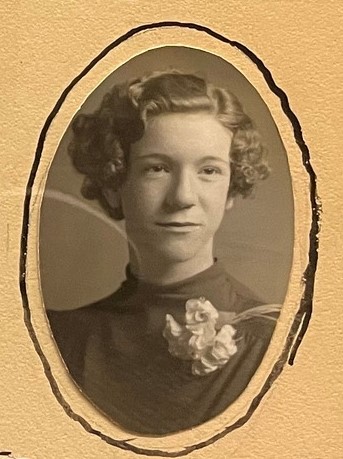
1938 Graduation Picture

Litha Bass
Have you Visited all the Cemeteries in Livingston County?
July 14, 2023
By Lola Guess
Mary Lynn Smith Driskill is a treasure in Livingston County in many ways. For one she is a valuable member of the Livingston County Historical Society. Mary is a tireless worker collecting obituaries and information from not only local sources but also from places outside the county. She follows leads that will take her to anywhere she can gather newspaper clippings, web pages, track down telephone calls…whatever it takes to find people connected to Livingston County that have passed away. In doing this, she has visited most if not all of the cemeteries in the county. If Mary has not been there, then the cemetery is probably not accessible. Mary is then ready to publish the next cemetery book listing all the deaths in the county in the last five years. The next book is scheduled to be published in 2024.
Mary took on this task after Lovertia Stegall retired and has been working on these cemetery books for several years. She is also a regular volunteer at the Log Cabin in Smithland, greeting visitors, helping with newsletters and mailings, doing research, answering the phone, and cleaning. In other words, Mary is ready to do what the day brings.
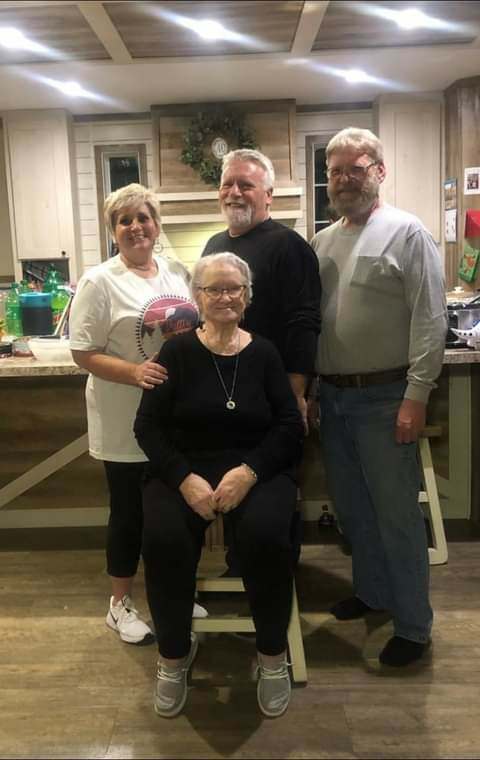
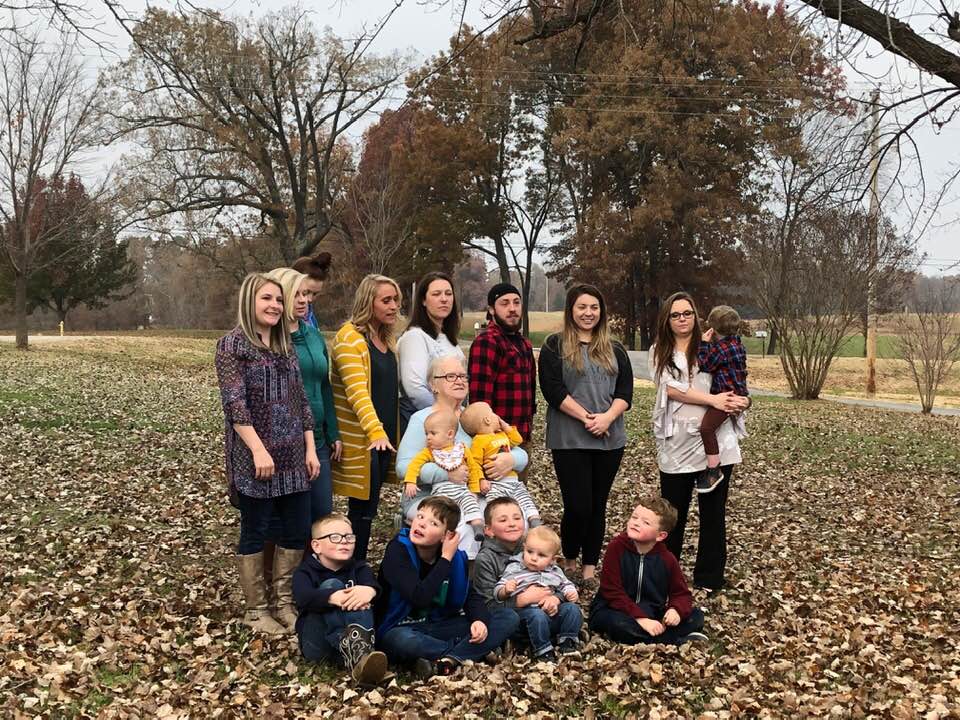
Mary was born on January 22, 1938. Her parents were William and Lillian Smith. Mary had three sisters, Edna Louise, Goldie M., Wanda Gail, and one brother Walter Beverly. Mary was a June bride as they say, marrying Charles Driskill on June 18, 1955. Their three children are Carol (1961), David (1966), and Jimmy (1969). Charles passed away in 2013 and is buried in Paradise Cemetery.
Mary is much loved by her family and spends time with her three children as well as nine grandchildren and fifteen great-grandchildren. Her hobbies are quilt making, embroidering quilts, and reading.
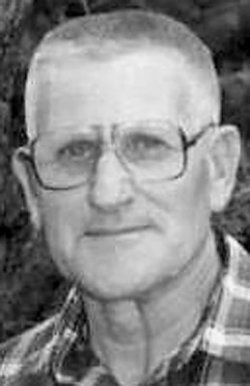
Charles Driskill
1934 – 2013
Buried in Paradise Cemetery
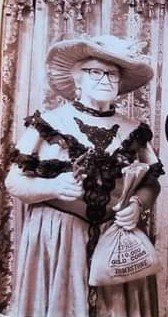
Mary Driskill
All dressed up!
Bo Moodie - Fluorspar Video
July 7, 2023
By Lola Guess
A new type of extremely powerful bomb was developed at the Oak Ridge, Tennessee, uranium production facility in the 1940’s. This facility is near Knoxville, Tennessee, and employed approximately 82,000 employees at its height during World War II. Only a handful of key people knew what was really being produced at Oak Ridge. The bomb making program was named the Manhattan Project and was said to be “the best kept secret during the war.”
The nuclear bomb production process requires spar (fluorite or fluorspar). This is the same fluorspar that was taken out of the numerous fluorspar mines around this area at that time. After years of research, study, and experimentation, the bomb was perfected and declared ready for use. On August 6, 1945, the first atomic bomb was dropped on Hiroshima, Japan. A B-29 named the “Enola Gay” was the name of the plane that flew on this mission. Then, on August, 9, 1945, another B-29 named the “Bockscar” bombed Nagasaki, Japan, subsequently ending the war.
The following is a recent video clip from Mr. Bo Moodie’s program at the Livingston County Historical Society’s meeting. Mr. Moodie and his wife, Terri, live in Livingston County. Mr. Moodie comes from a mining family that spans generations. He was gracious enough to share his wealth of information about mining, and how Western Kentucky fluorspar was instrumental in turning the tide of World War II.
Jumbo Scarbrough and His Big Fish
June 29, 2023
By Lola Guess
In the spring of 1925 , an impatient fisherman, Jumbo Scarbrough, set off a stick of dynamite in the Cumberland River. A gigantic fish surfaced and chased Jumbo’s boat to shore. Fellow fishermen Charlie Davis, Beck Bonds, and Ollie Charles helped trap and incapacitate the nine-foot-long alligator gar. They were able to tie a mule to the gar and pull it into a field. The fish was a prime tourist attraction for miles around. Phillip Smith and his sister, Isabelle Smith Thompson are in the background.
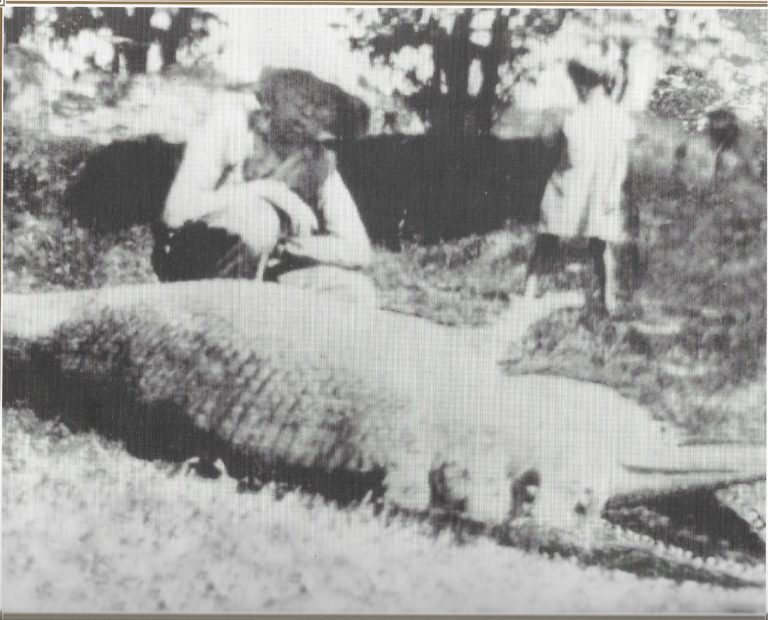
It is unknown what ultimately happened to the gar. Since alligator gar sells for about $3.00 per pound, today a catch that big would be an incredibly good day of fishing. According to Kentucky Wildlife records, an alligator gar is capable of reaching lengths of over 9 feet and weights of over 300 lbs. The largest reported size of an Alligator Gar is 9 feet, 8 inches and weighed approximately 302 lbs. The last Alligator Gar to be verified in Kentucky was in 1977 when a dead gar was found floating in Kentucky Lake near Cypress Creek. Jumbo Scarbrough’s fish was certainly one for the record books in 1925.

My Story of Mr. Bill Leffler
Smithland Memories
Paddle Wheel Boats & Stories
June 23, 2023
By Wanda Trail
I like the beautiful older boats. I have collected pictures, postcards, and lots of books on these boats. Smithland was a booming town back in the day with all the three rivers and boat traffic around the county. If the rivers could tell their stories, it would be unbelievable.

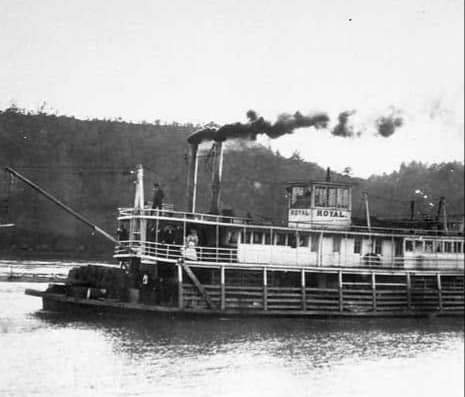
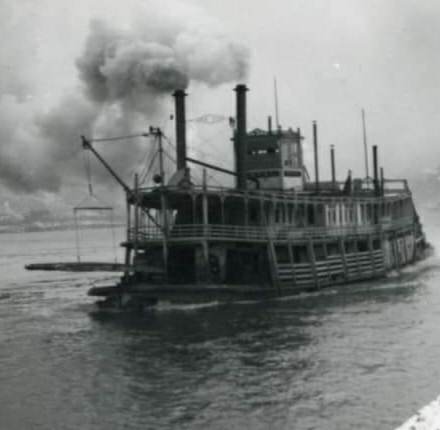
I only knew Mr. Bill in the 1960’s to 1981 when he passed away. He would show me the one special boat he made every time I went with Daddy to his house. I thought it was a very nice handmade boat. I would go every Halloween to his house. He gave me and my sisters a big nice red apple. I thought that was the best apple I had ever eaten. I can always remember him as a nice, kind, respectful gentleman to me. When he passed away his house was torn down and gone. I often wondered what happened to his boats he had made.
When I started going to the Historical Society…guess what? His boat was there and I was so excited to see his boat again. I have such good memories of him working on it and showing it to me. Mr. William “Bill” Leffler was born on January 15, 1891 and died September 20, 1981. His memory will live on forever because we have added two more of his boats with this one to our Historical Courthouse Museum. All three boats are on display for everyone to see.
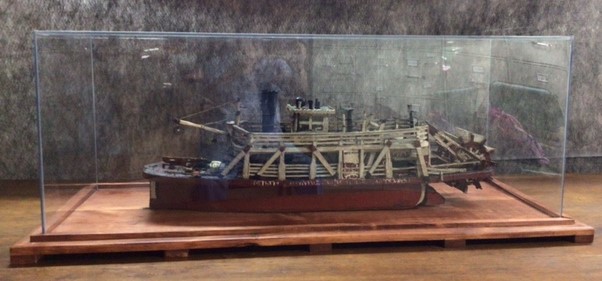
Have You Seen the Goat Man?
June 16, 2023
By Lola Guess
In the 1970’s a student dressed up as the Goat Man during the pep rallies at Livingston Central High School to help lead the cheerleaders. According to an article in the Paducah Sun dated, November 21, 1984, “Dianne Stallion, Livingston Central Middle School secretary recalled, it was all for fun.”
There have been Goat Man sightings reported around the County. According to legend, it all started at the Old Red Hole. An old iron ore pit near Tiline was claimed to be bottomless and filled with quicksand. The Ole Red Hole got its name from the reddish soil around the pit.
The Goat Man has been described as a man with a goat-like head who lived at the Red Hole. He supposedly ate people and threw their bones in the pit. He would appear only one week a year, but nobody knew when that week would be. People would drive their horses and buggies quickly by the pit. There were reports of glaring eyes and startled horses as they drove by. Something unseen near this site frightened a man’s horse so much that it threw him off, saddle and all. Children were warned not to go near the pit especially after dark.
(If there was a picture of the Goat Man, it would be here!)
In later years, the Goat Man was reported to be living in a barn. The Red Hole has all but dried up. Is that why the Goat Man chose to move to another location? Another article states that a half-man half-goat like creature was sighted in Livingston County and that an albino deer was seen and killed near where the Goat Man appeared.
Although there aren’t many stories being told nowadays about the Goat Man, who knows…he may go on a rampage again someday.
Murder at the Monument
End of Watch - Badge #4
June 9, 2023
By Lola Guess
Sunday night, September 9, 1984, was a pleasant 68 degrees with partly cloudy skies in Smithland, Kentucky. Deputy Carnie Franklin Hopkins left the dispatch office after checking in with Marvin Warren, the dispatcher on duty. He told Warren he was going to drive toward Salem to continue searching for an escaped convict from Illinois. The convict was named Edward Charles Cox an escapee from the Hardin County Correctional Center. Cox was serving a seven-year term for burglary when he escaped.
At 11:20 Deputy Hopkins called in on his two-way radio to the dispatch office that he was going to exit his vehicle to check on a “suspicious” hitchhiker. Approximately ten minutes later, Warren had not heard back from Hopkins and couldn’t reach him on his radio. This was not unusual since the area is hilly and contact was sometimes difficult. He decided to contact Deputy Orville Gilland who was on his way to work and have him check on Deputy Hopkins. Jack Day was sheriff at that time.
Deputy Gilland pulled in at the intersection of US 60 and Highway 137 about two miles east of Smithland which is known as the site of the “Monument.” He discovered Deputy Hopkins lying in front of his own cruiser. The lights were still on and the motor running. This was at approximately 11:30 p.m.
According to several newspaper reports, Deputy Hopkins, age 56, was shot in the upper chest with his own standard issue service weapon which was a .357 magnum. The gun was left at the scene and there was evidence of a scuffle. Although he was still alive, he was unable to speak to tell what had happened. Deputy Hopkins was pronounced dead at 12:45 a.m. on his way to the hospital.
A witness reported seeing a pedestrian walking toward Burna at approximately 11:10. The witness described the person as a white man approximately six feet tall dressed in a white T-shirt and jeans. Dogs were brought in to search the area, but no leads were discovered.
Scene at the Monument
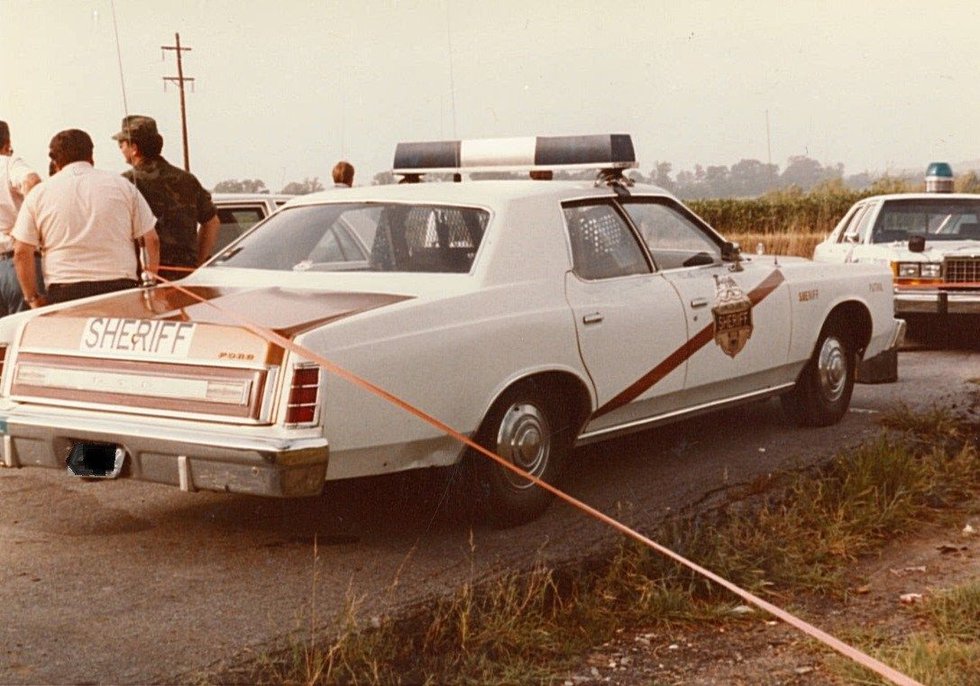


On June 2, 2023 a memorial ceremony was held in Smithland honoring the fallen officers in Livingston County. A beautiful memorial located in the Livingston County Museum Courtyard was unveiled. Sheriff Bobby Davidson and other dignitaries paid tribute to Deputy Carnie Hopkins along with four other fallen officers. They are Deputy Roger Lynch, Officer John Gooch, Officer Brian Jones, and Trooper Eric Chrisman.

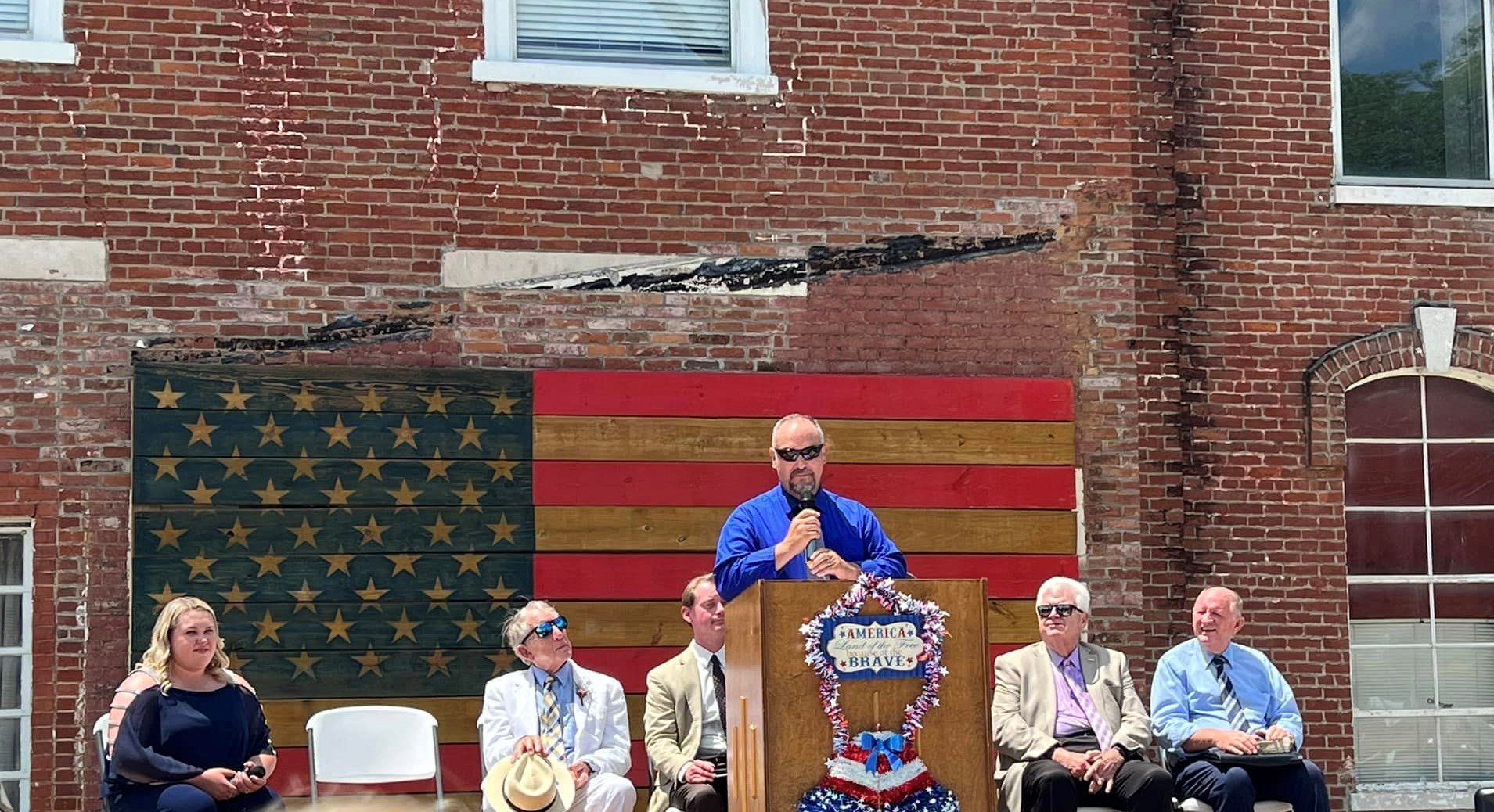
Carnie Hopkins was born on June 30, 1928. He enlisted in the Air Force during WWII. He was a trustee for the Ledbetter Fire Department, a member of the Ledbetter Optimist Club, the Smithland Masonic Lodge, the Ledbetter Church of Christ, and a member of the Board of Directors at the Bank of Livingston County. He was the first deputy to have been killed in the line of duty in Western Kentucky. Hopkins was survived by his wife, Rose Mary, and three children. He was the son of Frank and Fennie Dunning Hopkins. The service was held at Roth Funeral Chapel in Paducah with burial in Oak Grove Cemetery in Ledbetter.
In March 24, 2017 the case was reopened due to new information and technological advances. The Kentucky State Police asked for help from the public. There have been no arrests in the murder of Carnie Hopkins. The case remains unsolved as of this date.
In Remembrance of all Veterans Who Served
June 6, 1944 D-Day
Red - Letters from WW2 Soldier Bud Threlkeld
By Alexa Black
June 2, 2023
One veteran who fought during WW2 and survived The Battle of the Bulge was late Private First Class Harry (Bud) M. Threlkeld, Jr. who was a resident of Carrsville; a small river town in Western Kentucky. The family later relocated to Memphis, TN after his parents divorced and his mother remarried. Bud was the son of Harry and Mamie Threlkeld and was the brother to Charles Threlkeld. Bud left behind him with his family a series of WW2 memorabilia, v-mails, (veteran mail), letters and etc. written out to his parents, friends back home and his brother Charles who was also a WW2 soldier. The letters detail the beginning to the very end of his service.
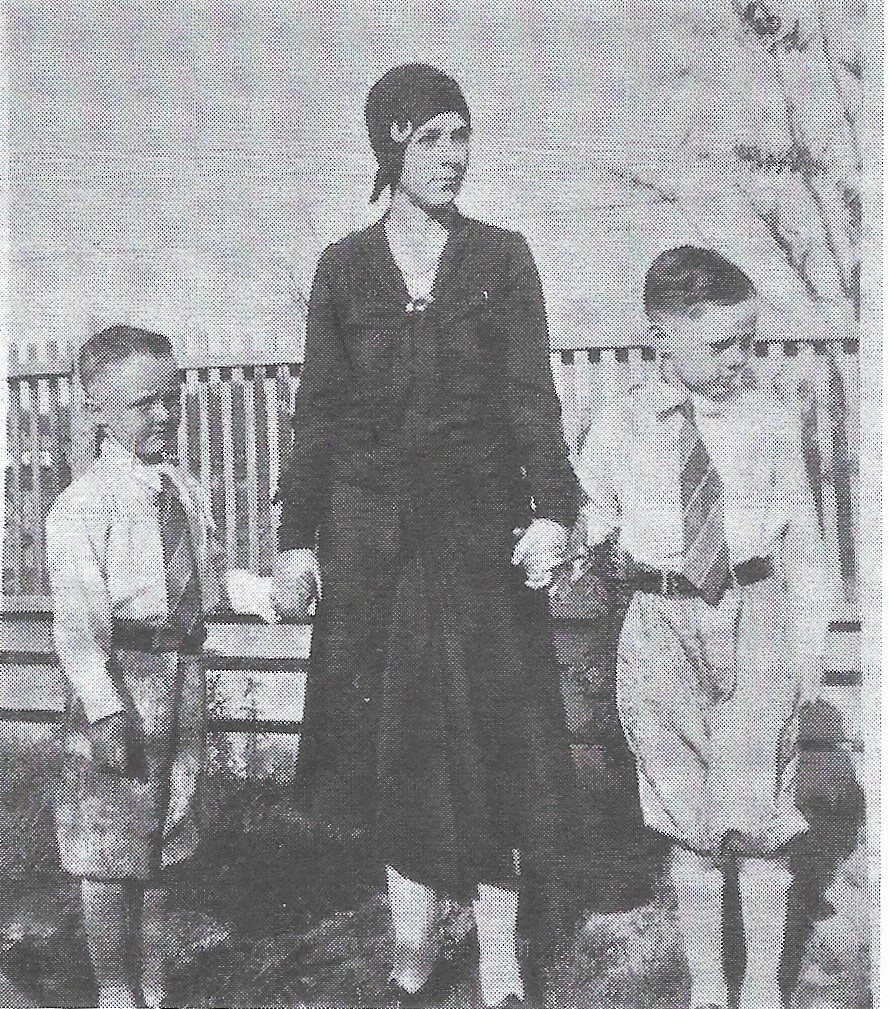
Bud (left) Mamie (middle), and Charles (right).
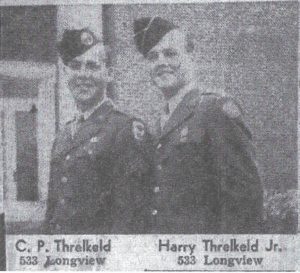
Newspaper clipping. Charles (left), Bud (right).
“You see I have traveled quite a bit. One of these days I’ll be back in the living room with you, Dad and Charles will have long forgotten these unpleasant things. I just sit and dream of home day and night and I can almost taste those good eggs, his biscuits, steak, and beef gravy you used to cook us for breakfast. I would even settle for some buttered toast. It is getting closer to Thanksgiving and I know I sure do have a lot of things to be thankful for though.”
“Dear Mom and Dad, it is about 11 now and I am sitting in my foxhole writing. My hands are very stiff from the cold but you can probably make it out. I was using my helmet as a writing table but the Germans started throwing the artillery in too close so I had to put my helmet on and just use a piece of cardboard to write on. I have to stop and duck every now and then, but I will get it finished before very long. Sometimes I think the Germans don’t like me so much because they keep shooting at me! They just need to see that I am a nice, loving man.”
“I have my rifle slung across my shoulder now loaded, and it seems a little unnatural. I can’t say I’m not scared now. Maybe it’s only the premonition of what is going to happen, it is supposed to be bad. I’ll know more about that sooner than I want to. Anyways, the French and Belgian people seem very friendly towards the Americans. I sure would like to be in the states with you all and maybe it won’t be too long until I can. “
Bud had written a few more letters to his mother and father over the course of November, none seemed as though he could give too many details about the combat he had been involved in. However, according to Bud on December 1st that had quickly changed in the last week. He had yet again found himself in another foxhole.

Alexa Black is an author, illustrator, and a musician. Alexa has won a variety of local competitions for her artwork and writing…She is looking to publish her other works. For a copy of this book contact Alexa Black.
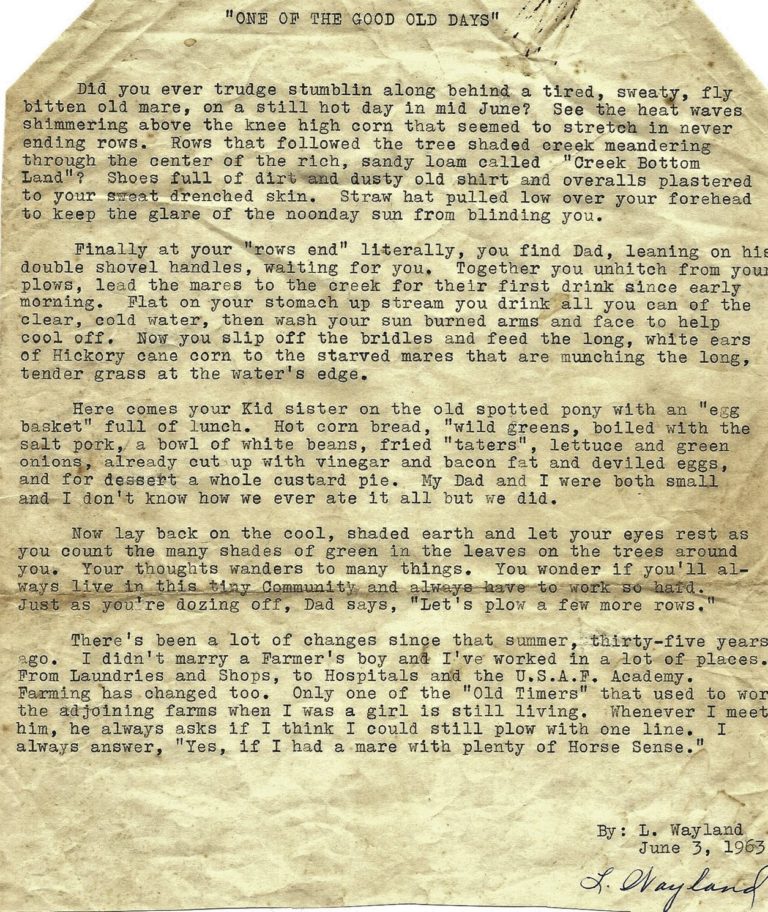
Linnie Esther Alsobrook & Alfred Clement Wayland
May 26, 2023
By Linda Phillips Fox
Linnie Esther Alsobrook was the first child of Martha Lee Bateman and Edgar Alsobrook. She was born on October 27, 1912 near Salem, Kentucky. Linnie married Alfred Clement Wayland on December 21, 1932. Their five children were Edgar C. (E.C.) born in 1936, Alvin B. and Alvie C. (twins) born on July 28, 1938 and both died in October of 1938, followed by Perry Andrew (Drew) in 1941, and Martha Lee in 1946.
Alfred worked in the Klondike mines where he contracted tuberculosis. They moved to Colorado Springs, Colorado where he soon recovered. Alfred was a top-notch mechanic and could easily find a job. They lived in many places, including Illinois, Kansas, California, and New Mexico. Alfred passed away in 1994.
Linnie was a very talented artist and published poet. She was in her nineties when she painted a picture that sold for several thousand dollars at an auction for Alzheimer’s Research. She was also an excellent seamstress. Linnie worked at the Air Force Academy where she altered uniforms for the cadets. She loved young people and would tell us about how many of the young cadets were so homesick when they first arrived. She would bring them some of her home baked bread and cookies to cheer them up. Linnie lived to be 100 and died on December 2, 2012. There are many advantages to being the oldest child but also a lot of responsibilities. Linnie describes a typical day in a story she wrote.
The People with the Big Scissors
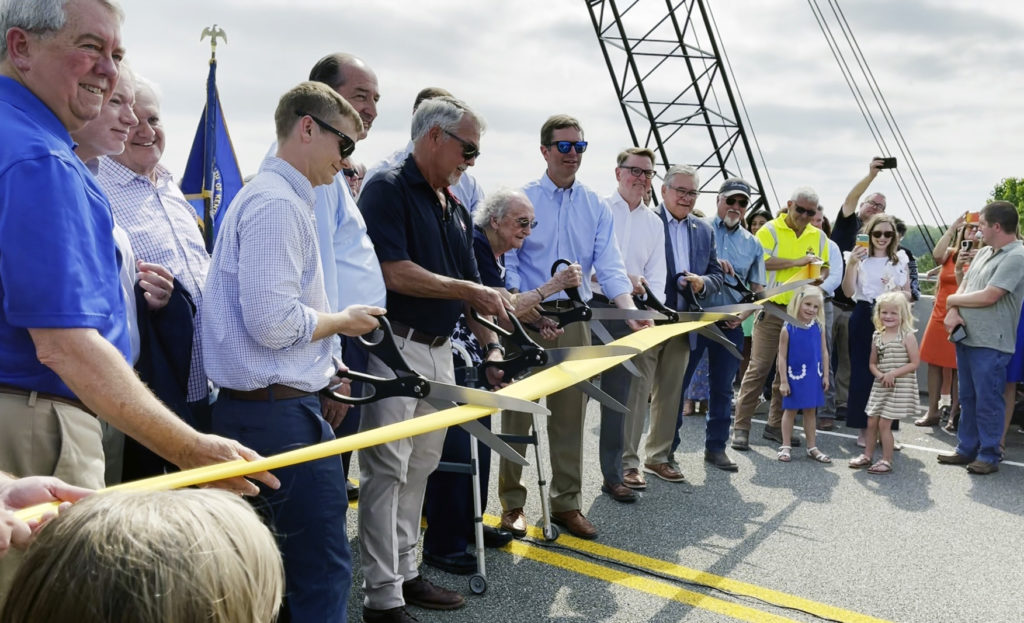
Usually, Livingston County is a quiet, peaceful place, but when the Jim R. Smith Memorable Bridge in Smithland, Kentucky, opened on Monday, May 15th, 2023, people were allowed to walk across the bridge before it opened to traffic later in the day. Politicians, students, residents, workers, historians, and the curious turned out for the walk and the ribbon cutting ceremony.
Ribbon cutting ceremonies date back to 1898 when the first ribbon cutting ceremony was believed to have been held at the opening of the Louisiana Railroad Line. The use of ribbons originated in military ceremonies and symbolize awareness and support. The big scissors and giant ribbons were introduced by Walt Disney and used at the openings of the Disney theme parks. Ribbon cutting ceremonies themselves symbolize a significant moment, or to mark a new beginning.
Livingston County celebrated this new beginning with five people holding the big scissors. Starting on the left, residents were proud to have our own Livingston County Judge-Executive Garrett Gruber in the ribbon cutting line. Judge Gruber is a second-term judge and keeps the business of Livingston County running smoothly. The next person ready to cut the ribbon is Rex Smith, President and CEO of Jim Smith Contracting. Smith Contracting was awarded the contract to build the $63 million bridge in 2020. The bridge was subsequently named in honor of Rex Smith’s father. Next in line is Ms. Muriel Dickerson. At 102 years of age, Ms. Dickerson resides in the Salem community and was present at the opening of the old bridge in 1931. Kentucky Transportation Secretary Jim Gray is next to Governor Beshear followed by Randy Bridges, Third District Representative. On the far right is Mike Smith, also a son of the late Jim R. Smith.
Livingston County is proud of the new bridge and honored to have these people in Smithland to celebrate with us. What happened to the scissors? The only thing I have been able to find out is the “keeper of the scissors” collected them after the ceremony to be used again at the next ribbon cutting. Which, as they say, is a good thing.
A Ghost Story in Livingston County
By: Carroll D. Walker
Carroll D. Walker began his career as Cashier of The Bank of Livingston County and later was elected to the office of County Court Clerk. Sadly, Carroll passed away in 2021 at the age of 78.
Among many of his hobbies and interests, he also enjoyed a good ghost story. He loved to talk to people and if they knew a ghost story that had been handed down, he was ready to write down the tale. He collected several stories through the years. This is one of my favorites.
Silas was a hard worker. His corn crop was proof of that. It was 1902 and Silas was in the field late in the day as usual. He was watching an approaching storm. Dark clouds were building and the corn stalks were rustling as the wind began to build. Silas needed to get the last few rows of corn plowed before the rain beat down and packed the dirt. He turned his team and began plowing the next row as the storm continued to move closer.
Ida prepared a late supper that night knowing Silas would use all the daylight he could in the corn field. It was well after dusk when Silas, covered with sweat and dirt, finally turned the mules loose and made his way to the house. He washed up and turned the coal oil lamp higher. Lightning flashed and then the distant sound of thunder sounded as the curtains in the kitchen window fluttered.
“Looks like a good un.” Silas told Ida as he sat down to eat. “We need the rain but this storm has been building for a long time today.”
Ida merely nodded and soon began to clear the table and wash the dishes. The front porch ran the length of the house, and Silas went out to smoke his pipe and sit in his favorite chair.
Their son, Amos, was sitting on the porch steps and the dog, Jack, came out from under the house to join them. Amos began telling his father that Jack had chased a rabbit that day.
“Did you get him?” asked Silas.
“Naw, answered Amos. “ Jack got tired and gave up. The rabbit ran under the wood pile and Jack just lost interest.”
A loud clap of thunder sounded in the sky as the storm moved closer and the wind picked up straw and dust. Silas and Amos decided to go in the house. Silas needed a cup of coffee.
“Listen! Did you hear that?” Silas asked. “Sounded like a whistle from a steamboat.” The room became quiet as they strained to hear above the thunder and the rain pelting down.
“Yes, I heard it.” Ida said. “Sounds like it’s coming from down around the creek.”
“Wait, I hear a different whistle coming from the other direction.” Silas said.
As the family listened in the kitchen under the dim lantern light, the storm continued to rage. Thunder and lightning drowned out the whistles from time to time. Finally, they could hear a steady blast of intense whistles. Then they hear a loud crash. Silas jumped from his chair and ran to the window unable to see anything other than the rain.
“I believe there was a steamboat crash out there on the Cumberland River just now.” Silas stated. They continued to look out the window and as the lightning lit up the yard, they saw a lone figure approaching the house carrying a lantern. The stranger was wearing a black raincoat and boots that came up to his knees. He wore a black hat and rain was dripping off the brim as he climbed the porch steps. The man knocked and Silas slowly opened the door and asked him to come on in out of the storm.
The stranger did not reply and merely stood on the porch. Silas asked him if there was a boat crash. Again, there was no answer and the figure slowly faded away as the family stood watching in the doorway.
When daylight came, Silas walked to the neighbor’s house to see if they heard all the commotion down on the river during the night. They had not heard or seen anything. No whistles, no crash, no lone man carrying a lantern.
This was not the last time Silas and his family heard the steamboat whistles, the crashing sound, and the stranger on the porch. Silas never answered the door again after hearing the crash and the frantic knocking. The incident always happened during a summer thunderstorm.
Other families that lived in that house and in another house that was built on the same site also experienced the ghostly appearance and the sounds of steamboats just as Silas, Ida, and Amos did many years ago.
Salem - The Big Spring Meeting House
May 4, 2023
By Lola Guess
The following is an excerpt from Leslie McDonald’s book titled Echoes of Yesteryear, published in 1972. Mr. McDonald tells about one Sunday in 1826 when Reverend Peter Cartwright, a Methodist minister and a traveling evangelist preached at the Big Spring Meeting House. It was an all-day meeting with “dinner on the ground.”
” Within half an hour after the service, the big spring, which was but a short distance from the meeting house was surrounded by groups of men, women and children. Many were seated on benches brought from the schoolhouse, which was nearby, and others were seated on the ground. Before them was spread upon clean, white cloths such an abundance of cold provisions that all could be supplied. There was cornbread, light bread, biscuits, broiled and boiled ham, broiled chicken, dried beef, venison, dried peach and apple pies. pickles, etc. The company had a most sociable and enjoyable time.
The Reverend Peter Cartwright was one of the most outstanding pioneer preachers and later ran for Senator in Illinois against Abraham Lincoln. Cartwright’s listeners were often afflicted with the jerks, a nervous affection which according to him seized the non-sympathetic and the sceptic, along with the enthusiastic. Saints and sinners alike would rise up and dance while so affected to obtain relief. Once he told a man to pick up his cross and follow Christ and was amazed when the man picked up his big, f– wife and started carrying her away on his back! Cartwright told the man that he didn’t think that was exactly what the Lord had in mind…The Reverend Cartwright’s father was a veteran of the Revolutionary War. He lived on Bissell Bluff and lived to be a ripe old age. He is buried at Bissel Bluff.”
This book is available in the Store. There are 232 pages of information, stories passed down through the years, and memories of Mr. McDonald.
Carl Talley - Mint Springs
April 28, 2023
By Lola Guess
There is a community in Livingston County named Mint Springs. It is located on Highway 70 and was so named because mint grew abundantly around the springs. Through the years, Indian artifacts have been discovered around the spring. The Indians were undoubtedly attracted to the clean, clear, natural underground water source. The following is a picture of the Mint Springs Baptist Church and the two Kentucky highway markers beside the church.
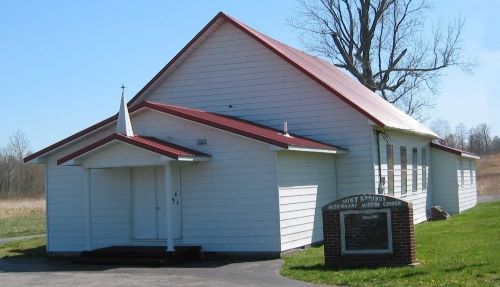
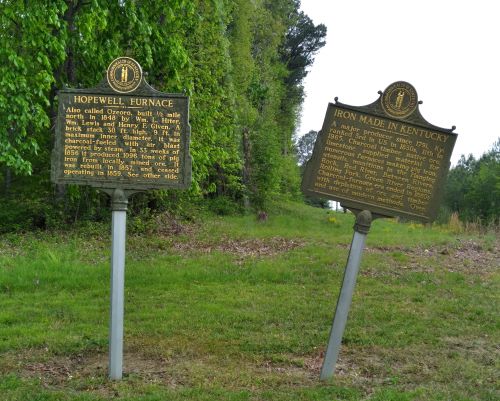
In the 1800’s, Effie Champion and her brother Fred inherited a farm at Mint Springs from their father and mother, John and Julia Champion. Julia was responsible for giving the land from this farm to Mint Springs Church. Effie married John Edgar Talley. They lived and worked on the farm for several years and it was also home to their nine children, Everett Reed, Mary Etna, Ora May, John Elbert, Olive Ollie, Carlton Matthew, Julia Alberta Pearl, Opal June, and Nina Daphne Talley. Carlton or “Carl” was the sixth child and was born on September 22, 1910. These pictures show Carl working in the field on the farm at Mint Springs. He is also shown holding his great-niece, Benita McDonald Jones.


Carl’s dedication to his work is proof that he loved the farm and relished working in the fields. But fate would interfere in his activities in the form of polio. The horrific disease did not stop Carl. He contacted Dearborn Motors in Detroit, Michigan, and ordered a custom-made tractor that he could drive after polio crippled his legs. The letter from Dearborn is dated 1948, so he contracted polio sometime before his 38th birthday. This shows Carl’s strength and courage. He did not give up. He found a way to do what he loved and lived his life in spite of the hardships that came his way.


Carl died on August 24, 1964, at Salem Hospital and is buried in Paradise Cemetery, in Grand Rivers, Kentucky. His death certificate states he was attended by Dr. Roscoe Faulkner and passed away from pulmonary tuberculosis at the age of only fifty-three. There are, of course, descendants of Edgar and Effie Talley and their children living in Livingston County today. If anyone has additional information to share about Carl, please use the contact button or post on Facebook.
Pictures courtesy of Benita McDonald Jones
Livingston County, Kentucky
April 15, 2023
An Introduction
Thirteen counties were established by Kentucky lawmakers in 1798. This was the most counties ever created in Kentucky in one year. The Legislature authorized the formation of Livingston County on December 13, 1798, which was six years after Kentucky became a state. Since Lyon County was a part of Livingston at that time, Eddyville was the first county seat. In years following the selection of Eddyville, the county seat was moved several times which included Centerville, Salem, and finally Smithland in 1841. Subsequently, a courthouse was built in Smithland. It was completed in 1845 at a cost of approximately $6,000.00 and still stands today.
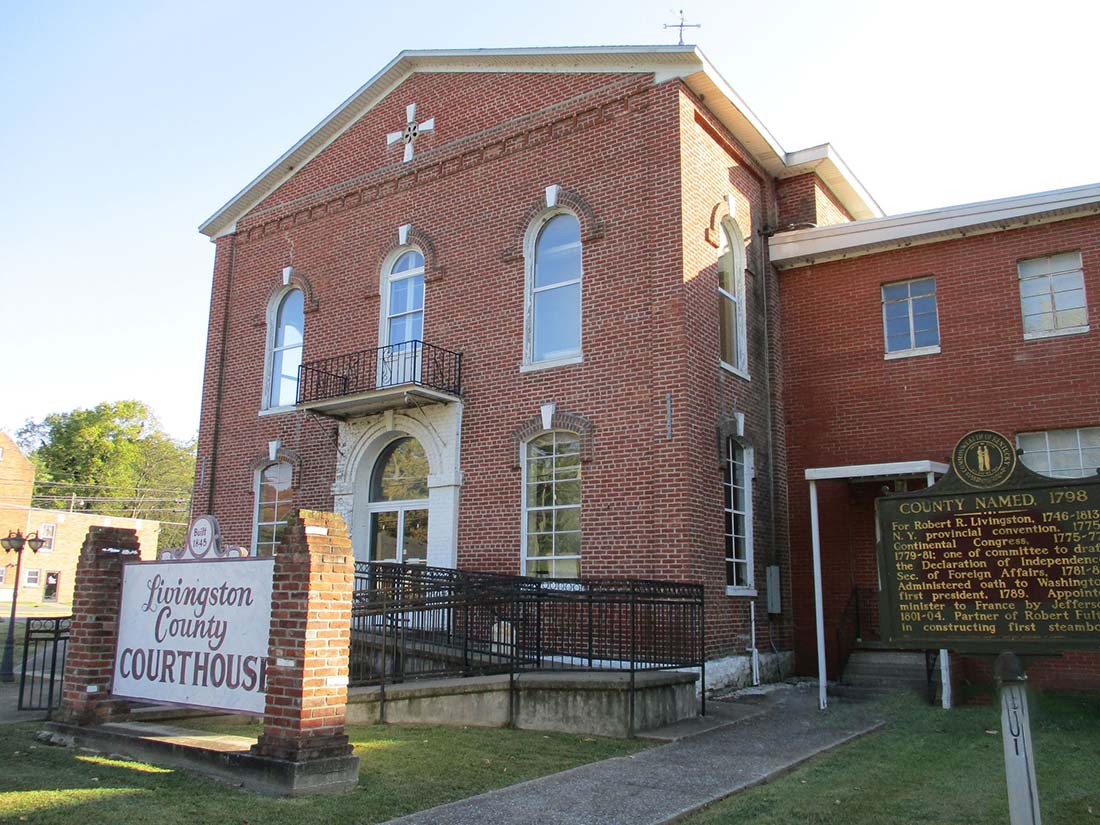

Livingston County is beyond comparison when it comes to natural resources, scenery, and impressive landscapes. Local fishermen enjoy the numerous creeks with names like Sugar Creek, Paddy’s Creek, and Bayou Creek. Thousands of tourists visit Kentucky Lake and Barkley Lake every year for recreation, fishing, hunting, camping, and sail boating. The rivers surrounding the county are dotted with tree-filled islands and sand bars can be spotted along the banks. Caves with intriguing pasts, deep limestone quarries, and famous rock formations such as Mantle Rock and Mandy Falls are popular attractions to explore. Several hundred Cherokee Indians stayed at Mantle Rock in the winter of 1838-1839. Many of them perished as they waited to cross the river on the “Trail of Tears.” Bissell Bluff and Newman’s Bluff are steep limestone and sandstone bluffs that were formed thousands of years ago. There are fertile river bottoms for growing crops and rolling green hills that provide pasture for livestock. This land in the region of the lower Ohio Valley along with the Cumberland, Ohio, and Tennessee Rivers is unique and rich in history. The Livingston County Historical Society is dedicated to exploring Livingston County, capturing the diversity of the region, and preserving the articles that are important to our heritage. Our goal is to provide a place for everyone to visit, research, enjoy, and be a part of our journey.
